SPACE RESEARCH

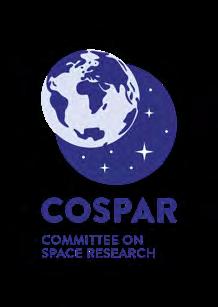

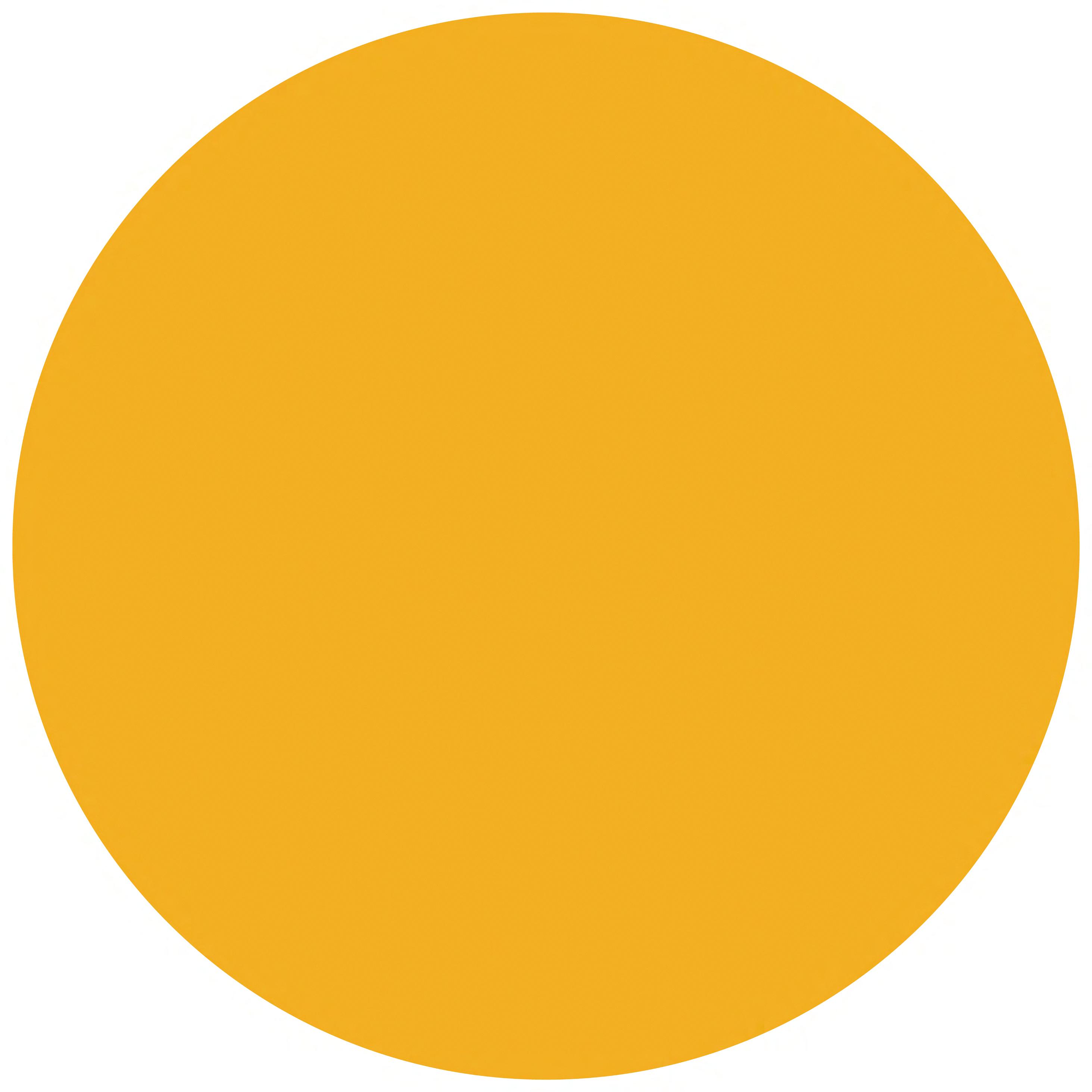
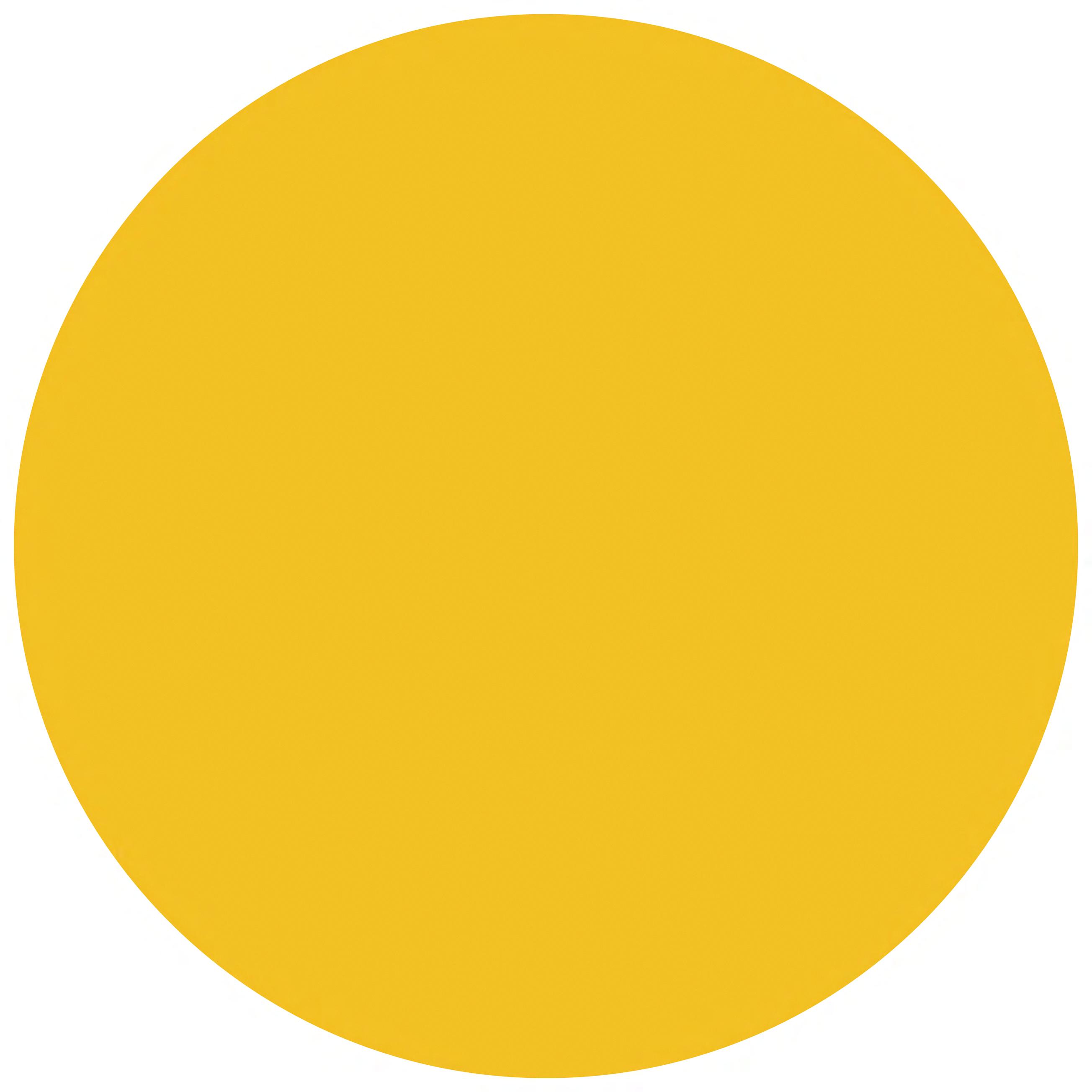








We are excited to share news about the forthcoming 6th COSPAR Symposium, taking place in Nicosia, Cyprus, from 3–7 November 2024. This biennial event brings together the global space science community in a focused, collaborative setting. This year’s theme, “Space Exploration 2025: A Symposium on Humanity’s Challenges and Celestial Solutions,” sets the stage for an especially dynamic and engaging program. Taking place in the historically rich setting of Cyprus, the symposium will feature an enticing program of scientific sessions, plenaries, and discussions, fostering interdisciplinary exchange across COSPAR’s diverse science domains. Among the highlights of this year’s Symposium are the Special Space Education Sessions and Weekend, which will take place just prior to and after the main event. These initiatives are designed to engage students, young researchers, early-career professionals, and teachers in space science, promoting knowledge sharing and mentorship. Through hands-on workshops, lectures, grants to participate to our events and networking activities, COSPAR continues to invest heavily in the next generation of scientists and engineers, affirming our commitment to education, support to early career scientists and capacity building across all regions.
As COSPAR advances its preparations for its 6th Symposium, we are pleased to report that the COSPAR community is expanding and evolving dynamically. Several new Panels have been established, reflecting the broadening scope of space research and the growing need for strategically aligned international cooperation. The new Panel on Machine Learning and Data Science (PMLDS) and the Panel on Early Careers and International Space Societies (PECISS) will address key scientific and strategic priorities, reinforcing COSPAR’s role as a unique forum for space research coordination.
Pascale Ehrenfreund
“Space Exploration 2025: A Symposium on Humanity’s Challenges and Celestial Solutions”
We also welcome a growing number of Industry and Institutional supporters (L3Harris and United Launch Alliance), whose participation highlights the essential synergy between academic research and industry innovation. This partnership ensures that scientific discoveries are effectively transformed into technological innovations, practical applications, and services that serve the broader needs of society.
Our expanding network of collaborations includes recent Memoranda of Understanding (MoUs) with international organizations (International Astronomical Union, Pan Ocean Remote Sensing Conference Association, Lunar Policy Platform, and renewal of the existing MoU with the UN Office for Outer Space Affairs) further enhancing COSPAR’s global reach and ability to act as a strong partner and catalyst in the space sector. These MoUs support joint initiatives in research, data sharing, and capacity development, aligned with COSPAR’s mission.
Scientific progress continues across several core COSPAR initiatives. The COSPAR Space Weather Roadmap, developed through extensive community input, is advancing into its next phase. The latest peerreviewed articles detailing this evolving roadmap will soon be published in Advances in Space Research , providing crucial guidance for policy makers, researchers, and operators in mitigating space weather impacts. We dedicate this roadmap to the memory of Professor Hermann Opgenoorth, former Vice-Chair of the COSPAR Panel on Space Weather and pillar of space weather science within COSPAR, who passed away on 19 May 2025.
COSPAR remains a committed partner to UNOOSA and actively contributes to international space policy discussions. During the recent session of the UN COPUOS Scientific and Technical Subcommittee (STSC) in February 2025 in Vienna, Austria, COSPAR organized and supported two side events: “Advancing Science and Planetary Defence in the International Year of Asteroid Awareness” and “Lunar Sites of Special Scientific Interest.” These events underscored COSPAR’s role in promoting scientific collaboration and raising awareness of critical issues in planetary defence and lunar research.
Another area of momentum is the COSPAR-1 small satellite project, emphasizing international collaboration and open data access to facilitate new science enabled by constellations. It reflects COSPAR’s ambition to support both cutting-edge research and global participation in space activities.
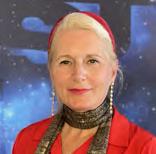
To conclude this brief and partial update on recent COSPAR activities, the Planetary Exploration (PEX) Roadmap is moving forward, providing strategic recommendations to promote space science as key drivers for space exploration, in order to maximize the scientific return of space exploration by stimulating international cooperation for the benefit of all sciences in space and to promote environmental stewardship in space exploration.
In all these efforts COSPAR remains dedicated to fostering scientific excellence, international cooperation, and peaceful uses of outer space. We look forward to welcoming you to Nicosia for a productive and inspiring 6th COSPAR Symposium as we continue to progress in the field of space science.
Pascale Ehrenfreund, COSPAR President
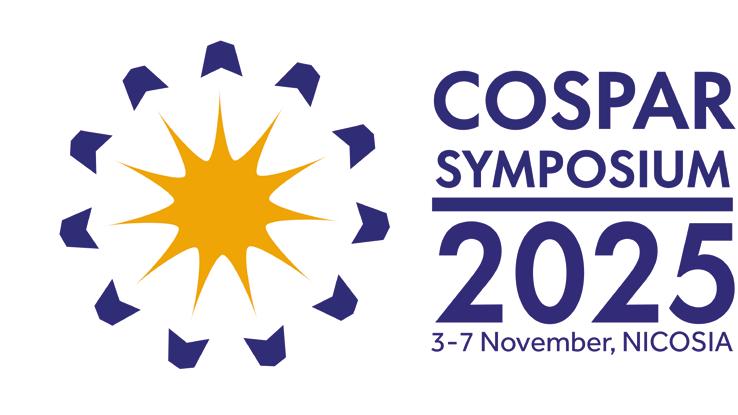
COSPAR is perfectly placed to be at the heart of global discussion about space-related issues that require strategic thinking and action as our field evolves and develops. Especially in light of rapidly developing commercial space interests, in the increasing numbers of space-faring countries and in the increased use of cubesats, for example, issues arise that were not on the agenda just a few years ago. Thus, it is not surprising to see a key discussion in this issue of SRT about sustainability and protecting the space environment, written by our President, Pascale Ehrenfreund, and colleagues. As General Editor, I am always so pleased to see such articles, carving out suggestions for policy and strategy on the international stage; taking the initiative to address emerging, key topics in a timely fashion within the auspices of COSPAR. This important article is also reflected in the related issues raised in Patrizia Caraveo’s book, ‘Space Ecology – from Earth to Moon and Mars’, which is reviewed in this issue.
In terms of ‘regular’ COSPAR business, I am delighted to see two substantial Scientific Commission reports from SC-A and E in this issue. These underline the relevance of COSPAR Scientific Commissions as a key part of the global development of their fields. They are far from nominal topical groupings of little relevance to scientific progress. As always, we
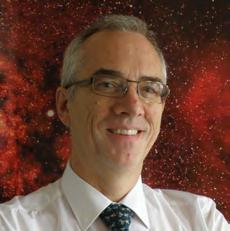
Richard Harrison
encourage the COSPAR Scientific Commission, Panel and Task Group chairs to submit reports to SRT on a regular basis. The wider COSPAR community is certainly interested to know what the different elements of our organisation are up to.
A personal highlight for me in this issue is the excellent article by Daniel Müller (ESA) on the Solar Orbiter mission as it begins the high-latitude phase of its mission, to enable studies of the solar poles. This is a mission close to my heart, having been a member of the mission proposal team in 2000. It is wonderful to see Daniel's summary of the superb science results.
Of course, there are many other interesting and important articles in this issue; once again, we have a wide range of topics and contributions. One reminder in this issue is that of World Space Week, 4 -10 October 2025 (which regularly celebrates the launch of Sputnik 1). I love the idea of inviting everyone to simply participate by generating an activity to be linked to the event, to encourage and emphasise global collaboration and participation, and in turn boost activity in our field.
As a final comment, I must note the sad passing of Hermann Opgenoorth, an extremely influential and loved space scientist, who was particularly active in COSPAR. We plan to publish a full In Memoriam in the next issue.
— Richard Harrison, General Editor
In this section we include profiles of COSPAR personalities, principally officers, and other articles relevant to persons active in COSPAR’s affairs.
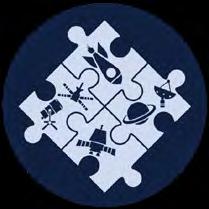
I was born and grew up in a small town in Argentina, a country I had to leave due to political persecution at the age of 20. Various vicissitudes led me to Germany, where I was granted political asylum and from there the opportunity to study at university. During my physics studies, I was first a physics and mathematics tutor at the Studienkolleg of the University of Heidelberg and later a scientific assistant at the Institute for High Energy Physics, where I completed my studies with a PhD in experimental elementary particle physics.
After a postdoc at the Max-Planck-Institut for Nuclear Physics (MPI-K) in Heidelberg, I started working at another MPI, the MPI for Astronomy (MPIA), in the same city, on the ISO (Infrared Space Observatory) project of the European Space Agency (ESA). Subsequently, after joining ESA as a member of its scientific staff, I was first part of the team in charge of the scientific operations of ISO, in particular leading the group that developed the scientific analysis programme of one of the instruments on board, but also collaborating with the calibration of the instrument, from the ESA facilities near Madrid, VIILSPA, later ESAC (European Space Astronomy Centre). The seven years of ISO were followed by nineteen years doing scientific operations in the XMMNewton X-ray space observatory, mainly responsible for its scientific analysis system and data pipeline processing, but also performing instrument calibration.
For ten years (2005-2015) in this last period I was also a member of the International Astronomical FITS Working Group Committee, and from 2003 on also a member of the Program Organizing Committee (POC) of the Astronomical Data Analysis Software and Systems (ADASS) conference, which I had the pleasure to chair between 2009 and 2016. These activities were complemented by my participation as member of the Scientific Advisory Board of Elsevier’s journal Astronomy and Computing.
I retired from ESA in 2019 after 26 years of service. Since
then I have devoted myself professionally almost exclusively to two projects that I had already started before my retirement: 1) my membership since 2017 in the board of directors of the scientific journal Astronomy & Astrophysics, representing the Argentinean astronomical community; and fundamentally 2) my activities in the COSPAR capacity building panel, to which I have belonged since 2009 and which I have lead since 2018.
In all these years of participation in the Capacity Building Panel, I have organised numerous workshops in space sciences in various disciplines in developing countries. This is the main goal of the initiative, initiated by Professor Peter Willmore, a mythical figure in COSPAR's history, in 2001, with a workshop on X-ray astronomy, which was my first contact with COSPAR. In the past quarter of a century, this initiative has led to almost 50 workshops in the most diverse areas of space science in 24 developing countries, with the participation of almost 1,500 young researchers from more than 72 countries.
In 2023 I proposed a new initiative based on the use of small satellites. The purpose is to involve each time a group of students from a university in a developing country in the design, construction, testing and operations of one or more small satellites in an international collaboration, acting as a mentor, and at the same time helping with the construction of a small satellite laboratory at that university. The first pilot experience, with excellent results, started in 2024, involving a group of five Peruvian students from the National University of Engineering (UNI) in Lima in the project to design and build the COSPAR-1 small satellite for space weather observations, in collaboration with the Laboratory of Atmospheric and Space Physics (LASP) and a group of universities participating in the INSPIRE initiative (at this link). This project is well advanced and after final integration and testing during the remainder of 2025 will be launched into orbit in early 2026.
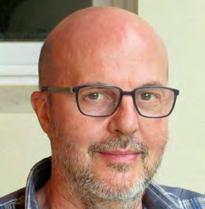

Dear COSPAR Member,
World Space Week is a UN-declared global celebration of space science and technology and their impact on improving life on Earth, taking place from October 4-10 annually . Each year, thousands of events are organized globally by space agencies, universities, research institutions, schools, and industry leaders.
As we look ahead to World Space Week (WSW) 2025, we would like to invite COSPAR and its members to join us in celebrating the world's largest annual space event.
The theme for WSW 2025, Living in Space , highlights the importance of humanity’s journey toward making space a habitat, which relates to many fields of space science such as life sciences and planetary environments.
We particularly encourage COSPAR members to actively support World Space Week by promoting space science and sharing their research with students and the public through lectures, outreach events, and media engagements.
However you choose to participate, please add your October 4-10 activity to the official WSW website .
Please don’t hesitate to contact us if you’d like to collaborate or need guidance in organizing your WSW activities.
Professor Emeritus Atsuhiro Nishida (Institute of Space and Astronautical Science) passed away on 17 May 2025 at the age of 89. Nishida-sensei, as he was known, was a world-renowned space scientist. For a period exceeding six decades, he achieved numerous pioneering research results in the field of space physics, with a particular focus on magnetospheric physics.
When he entered graduate school at the University of Tokyo, the International Geophysical Year (IGY) of Earth Observation was underway, and the first Soviet satellite, Sputnik, had just been launched. This was followed by the discovery of the Van Allen radiation belts by the U.S. Explorer I spacecraft. This period thus coincided with the dawn of the Space Age. As a researcher in the early stages of his career, Nishida
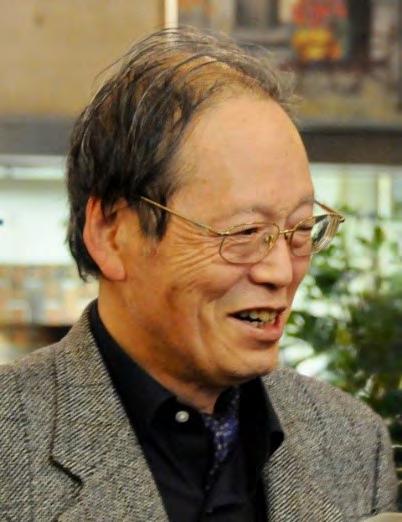
made a significant contribution to the establishment of a novel paradigm in magnetospheric physics. This was achieved by examining magnetospheric structure and plasma convection from the perspective of their interaction with the solar wind. As a result, he rapidly garnered an international reputation for his work. Since that initial work, he made great contributions to the establishment of the magnetotail reconnection model as a fundamental physical process in the study of energy and momentum transport processes from the solar wind to the magnetosphere and the structure and dynamics of the magnetotail.
Of particular note was his advocacy for the Geotail satellite project and its subsequent execution. The mission, which was realized under the strong leadership of Nishida-sensei, was the first full-scale Japan-U.S. joint project between ISAS and NASA. In 1992, the Geotail spacecraft developed by ISAS in Japan was launched by a U.S. rocket. The spacecraft's unique orbit design made it optimal for observations of the magnetotail and magnetospheric boundary region, thus yielding a series of novel findings. These included the demonstration of the magnetotail reconnection process and associated particle acceleration, a phenomenon that had long posed a challenge to magnetospheric physics. With regard to the Geotail results, Nishida's own research results, obtained by analyzing observational data, were and are, of course, significant. However, what is even more important is the fact that young and mid-career researchers in Japan achieved great results under his strong leadership. The Geotail spacecraft is widely acknowledged as the most successful spacecraft in magnetospheric physics during the 1990s.
In addition to his aforementioned roles, Nishida-sensei served as Director General of the Institute of Space and Astronautical Science in 1996-2000, followed by Auditor of the Japan Society for the Promotion of Science, and Director of the Graduate University for Advanced Studies. During this period, he made valuable contributions to the development of science
members of the COSPAR Community will remember that
Atsuhiro Nishida was Vice-President of COSPAR from 1994 to 2002.
in Japan. He also served the international scientific society, holding the positions of Vice-President of COSPAR in 1994 – 2002, and Vice-President (2006 and 2009) and President (2007 and 2008) of AOGS. Furthermore, the Interagency Consultative Group (IACG), consisting of four major organizations of space science, NASA (USA), ESA(Europe), IKI(Russia), and ISAS (Japan), selected solar-terrestrial science as its next major space science discipline for coordinated research, after its stunning success coordinating the Comet Halley encounters in 1986. Nishida-sensei, as the Executive Director of the ISTP (International Solar Terrestrial Physics) Program, made a major contribution to the promotion of international cooperation by adding the IKI and ESA satellites to the ISTP spacecraft fleet of Japan and the USA.
As described above, Nishida-sensei made significant contributions to the development of magnetospheric physics at its dawn, to the development of magnetospheric physics and human resource development at its maturity, and to the development of space science and the promotion of scientific research. In recognition of these accomplishments, he was honored with many prestigious awards at both the domestic and international levels. Notable honors bestowed upon him include AGU Fellow in 1988, EGS Hannes Alfven Medal in 2001, the Japan Academy Prize in 2001, COSPAR Space Science Award in 2006, AOGS Axford Award in 2009, the Order of Cultural Merit in 2012, and the Grand Cordon of the Order of the Sacred Treasure in 2014. In 2008, he was elected as a member of the Japan Academy.
Throughout his career, Nishida-sensei mentored many young researchers. His guidance was firm, yet always compassionate and deeply humane. Many recall how he consistently offered the right advice to the right person at the right time. His legacy will live on in our memories forever.
By Toshifumi Mukai (ISAS/JAXA*)
Kiyoshi Maezawa (ISAS/JAXA*)
Toshio Terasawa (University of Tokyo)
Masahiro Hoshino(University of Tokyo)
*Institute of Space and Asronautical Science/Japan Aerospace Exploration Agency.
Some people leave a mark on an institution not only through their work, but also through their warmth and presence, and the way they make everyone feel at home. Maurizio Falanga was one of those people. His death plunged the International Space Science Institute (ISSI) into a period of deep sadness, and although we still sorely miss him today, we remember the joy, humour and humanity he brought to the lives of his colleagues.
Maurizio was born in Basel, Switzerland, and graduated with a degree in theoretical physics from the University of Basel. He received his PhD in astrophysics from the University of Rome “La Sapienza” in Italy. He then held various research fellowship positions in astrophysics departments across Europe and the USA.

Maurizio joined ISSI in 2009 as a full-time Science Programme Manager and quickly became a key figure in scientific operations. He devoted his energy to co-organising numerous workshops and co-editing several volumes in ISSI's Space Science Series, including the first book published by ISSI Beijing. In 2013, he became the founding Executive Director of ISSI-BJ, helping to increase ISSI's profile in Asia. He was also a marvellous host during our visit to Beijing, happily showing us around and telling us all about Chinese astronomy and space sciences, as well as helping us with Chinese food in restaurants without English menus. In 2021, he was appointed ISSI Director in Bern and Associate Professor at the University of Bern. He was an active member of COSPAR, and a member of the COSPAR Task Group (now Panel) on establishing a Constellation of Small Satellites SubGroup on Radiation Belt (PCSS SGRB).
Maurizio was widely recognised as an expert in accreting systems, with a particular focus on black holes and X-ray pulsars. His contributions spanned the theory of accretion, growth and merger of black holes across the mass spectrum, from stellar-mass to supermassive. His review volume, The Physics of Accretion onto Black Holes, remains a valuable resource, integrating physical models and observations ranging from galactic binaries to quasars. He also had a keen interest in exotic phenomena such as pulsars, particularly millisecond X-ray pulsars in binary systems. In recent years, he had turned his attention to the fascinating realm of exoplanets orbiting pulsars. A dedicated researcher, he has authored or co-authored over 300 scientific papers, collaborating with observers and theoreticians from around the world. His work on missions such as BeppoSAX and INTEGRAL has made a significant contribution to the advancement of X-ray astronomy.
As Director at ISSI, Maurizio's leadership style wasn’t just about policies or major decisions; it was about people. He led by listening, taking the time to check in and valuing conversation as much as conclusions.
"Some people leave a mark on an institution not only through their work, but also through their warmth and presence, and the way they make everyone feel at home."
His door (and his mind) was always open, and he had a legendary ability to turn a casual chat into an impactful discussion. Having spent much of his research career travelling between institutions and collaborations around the world, Maurizio was familiar with the challenges and joys of working far from home. These experiences broadened his mind and deepened his perspective, both scientifically and personally. He carried with him a global outlook, an openness to different ways of thinking and an effortless ability
to connect across cultures. This gave him a deep appreciation for the scientists who passed through ISSI’s doors, and he made it his mission to ensure they felt not just welcomed, but understood.
Colleagues who worked at the university but not directly at ISSI would often meet Maurizio in the hallway on the way to teach, or perhaps even in the aisles of a local supermarket — ISSI veterans will know which one. You could always see Maurizio coming from a distance — he was the guy who always had a smile on his face. More often than not, you would end up having an impromptu chat with him about science or current affairs. No matter what the topic, you would leave feeling energised because his optimism and good mood were infectious.
Maurizio will be greatly missed.
From Fabio Crameri (ISSI, Switzerland), Willy Benz (University of Berne, Switzerland, and ISSI), Antonella Nota (ISSI) and André Galli (University of Berne)
The COSPAR space weather was greatly saddened to learn of the demise of Hermann Opgenoorth . A full In Memoriam will be included in the next issue of Space Research Today .
We strongly encourage COSPAR Scientific Commission Chairs, COSPAR Panel Chairs and Task Group Chairs to submit reports on progress and overviews of work in their topical areas. We would welcome such reports on a regular basis, to cater for the interest in COSPAR activities of our readership. We have in recent issues included reports from the Scientific Commission H, for example, and the Panel on Planetary Protection.
Here we present reports from Scientific Commission A – Space Studies of the Earth’s Surface, Meteorology and Climate and Scientific Commission E – Research in Astrophysics from Space. We also include an update of activities of the Panel on Education .
— Richard Harrison, General Editor, SRT.
Jérôme
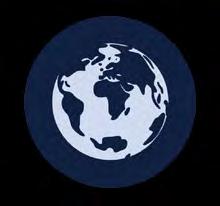
COSPAR is structured around several Scientific Commissions, each dedicated to a specific area of space science. Scientific Commission A focuses on Space Studies of the Earth’s Surface, Meteorology, and Climate.
Scientific Commission A’s primary mission is to advance scientific understanding of the Earth system as observed from space, supporting COSPAR’s mission “to promote at an international level scientific research in space, with emphasis on the exchange of results, information and opinions, and to provide a forum, open to all scientists, for the discussion of problems that may affect scientific space research”. Scientific Commission A supports research and collaboration on how Earth’s surface, atmosphere, weather, and climate can be monitored and analyzed using space-based instruments and technologies. This includes observations from remote sensing satellites that provide critical data for understanding global and regional environmental changes.
Key areas of Scientific Commission A’s work include:
• Earth Observation: Developing and improving methods for remote sensing of Earth’s surface features such as vegetation, land use, urban areas, and water bodies.
• Meteorology: Using satellite data to study atmospheric dynamics, weather systems, cloud formation, and precipitation patterns. This work supports more accurate weather forecasting and early warning systems for extreme weather events.
• Climate Studies: Monitoring long-term changes in Earth’s climate, such as temperature trends, sealevel rise, ice cover changes, and greenhouse gas concentrations. Commission A promotes the development of climate models that use satellite observations to improve predictions of future climate scenarios.
• Data Calibration and Validation: Ensuring the accuracy and consistency of satellite measurements through coordinated ground-based observations and inter-comparisons among different instruments and missions.
• International Collaboration: Facilitating cooperation among scientists, space agencies, and organizations worldwide. COSPAR’s Scientific Commission A organizes workshops and scientific sessions to share research findings, promote best practices, and support the development of global observation systems.
Through these activities, Scientific Commission A plays a vital role in addressing some of humanity’s most pressing challenges, such as understanding climate
change, managing natural resources, and preparing for natural disasters. By promoting high-quality scientific research and fostering international partnerships, it helps ensure that space-based Earth observation continues to deliver valuable insights for science, policy, and society, worldwide. Scientific Commission A also contributes to granting COSPAR awards.
Scientific Commission A is organized with subcommissions covering the Atmosphere, Meteorology, and Climate (A1), Ocean Dynamics, Productivity and the Cryosphere (A2) and Land Processes and Morphology (A3). These sub-commissions are fully involved in COSPAR Symposia and Scientific Assemblies, and other tasks and duties that will be described in this article.
At the COSPAR Symposium 2025, in Nicosia, Cyprus, from 3 to 7 November, Scientific Commission A will play a key role in advancing research on spacebased studies of the Earth’s surface, meteorology, and climate. Scientific Commission A is organizing dedicated scientific sessions that highlight the use of satellite data for monitoring land, oceans, atmosphere, and climate systems – critical areas for addressing environmental change and disaster risk.
Commission A’s sessions focus on the latest developments in Earth observation technologies, remote sensing applications, and climate modeling from space, and aim to foster collaboration among
scientists from diverse regions, with particular attention to the needs and capacities of developing countries. In addition to research presentations, the Commission will support capacity-building efforts through training activities and workshops, helping early-career scientists and local experts improve their skills in analyzing and applying space-based Earth data.
By actively participating in the Symposium, the Scientific Commission A helps ensure that the Earth science community remains connected and responsive to global challenges such as extreme events, land degradation, and climate variability – all through the lens of satellite-based science.
At the COSPAR Scientific Assembly 2026, to be held in Florence, Italy, from 1 to 9 August, Scientific Commission A will spearhead many sessions on spacebased Earth studies, emphasizing innovations in satellite monitoring of land surfaces, atmosphere and ocean dynamics, and climate trends.
The Commission’s program will feature cutting edge research talks on high resolution remote sensing, use of in situ data and data assimilation into models.
A0.1 What Are the Remaining Scientific Challenges above Equatorial Regions? How Small Satellites Could Fill the Knowledge Gap?
The objectives of the special event A0.1 are to review the remaining scientific challenges above tropical regions (e.g.: Atmosphere and Troposphere; Marine and Coastal; Solid Earth and Land; Ionosphere and Space Weather), and how small satellites could fill the gaps at different levels (eg: systems and sensors; data processing and modelling; applications and services),
to significantly enhance the scientific value of existing big LEO polar & GEO satellites. An overview of the latest mission launches and nextgeneration sensors for land, atmosphere, and climate studies. Speakers will highlight strategic priorities and upcoming data archives.
A0.2 Coastal Resilience to Hazards: Bridging the Gap between Earth Observations and User Needs
Coastal zones, home to vital ecosystems and growing populations, face severe threats from climate change, rising sea levels, hurricanes, tsunamis, and coastal erosion, all intensified by human activities. Enhancing coastal resilience has become a priority for governments and environmental advocates. However, understanding coastal processes is hindered by data gaps and the challenge of integrating satellite observations, in-situ data and modelling capacities. The CEOS COAST initiative addresses these challenges through pilot projects – Land 2 Sea and Sea 2 Land – focused on coastline changes, flooding, and land-based nutrient transfer into oceans. The GEO Blue Planet initiative contributes to this topic by facilitating data integration for improved decisionmaking around specific topics including Sargassum, marine litter pollution or eutrophication. Through CEOS and GEO Blue Planet, stakeholders are engaged in codesigning solutions to enhance coastal data products, bridging the gap between scientific knowledge and decision-makers’ needs. These efforts advance climate change adaptation and foster sustainable development across coastal regions. Please submit abstracts reporting your work in the Coastal Zone to this session.
A0.3 Green Solutions to Tackle Climate Change Using Earth Observation
This event will address possible solutions to respond to the actual triple crisis on climate, pollution and biodiversity. These solutions can be used by a wide scientific community but is as well targeting new end users and applications for the general public. The new ESA Earth Observation (EO) Science Strategy emphasizes the pivotal role of EO in advancing green solutions to address these pressing environmental challenges. The strategy prioritizes the integration of EO data into developing green solutions, leveraging predictive models, and harnessing frontier science across six overarching themes, such as climate science and extreme events. This holistic approach aims to foster
sustainable policies, facilitate global partnerships, and enhance industrial competitiveness. The Earth Action initiative under this strategy consolidates decades of knowledge and expertise, responding to diverse policy frameworks and sustainability goals. This event will bring together science, applications and policy in this context.
A1.1 Space-based and Sub-orbital Observations of Atmospheric Physics and Chemistry: Critical Information on the Health of our Planet
Space-based remote sensing observations have become an indispensable tool for monitoring the state of the atmosphere as well as improving our scientific understanding of the physical and chemical processes of the Earth system. Many satellite data products have reached a state of maturity that qualifies them to be used as essential climate variable (ECV) data sets. One of the main aims of this session is to provide a forum for interaction between space-based and sub-orbital remote sensing communities working in the related science areas of atmospheric chemistry and physics. Contributions are welcome for: new missions and techniques, instrument and retrieval development (including signals of opportunity), current validation comparisons, technical and spacecraft engineering issues, and scientific analyses of greenhouse gases, tropospheric pollution, tropospheric and stratospheric aerosols, the UT/LS region, and the dynamics and chemistry of the stratosphere and mesosphere. Contributions on suborbital missions, small satellites and geostationary satellites are particularly encouraged.
A2.1 Science and Applications Enabled by Satellite Missions for Monitoring the Global Ocean and the Cryosphere
The aim of this event organized by the sub-commission A2 is to promote the values of scientific and commercial satellite missions for interdisciplinary research and applications relevant to physical and biogeochemical oceanography, as well as in cryospheric sciences. Satellite measurements have greatly improved our understanding of changes in oceanic and cryospheric processes including mesoscale and sub-mesoscale dynamics, loss of land ice and its contribution to global sea-level rise, or changes in sea ice extent and its impact on ice-albedo feedback. This session aims to highlight studies where special retrieval algorithms are required to improve the
accuracy and resolutions of current and future satellite measurements for the monitoring of oceans and the cryosphere. Also encouraged are studies based on the synergy of different measurements, the use of machinelearning, and the combination with models or situ data for ocean and cryosphere science and applications. This event specifically invites studies that leverage the synergy between different satellite measurements and contribute to advancing future mission concepts, technologies, and processing algorithms for monitoring the changing oceans, sea ice, and land ice.
A3.1 New Earth Observation Technologies and their Applications for Sustainable Terrestrial Ecosystems under Climate Change
This session will highlight the importance of monitoring
Earth system for understanding the human impacts on sustainable terrestrial ecosystem. The sessions will cover a myriad of topics linked with the sub-commission A3: vegetation monitoring and the terrestrial carbon cycle; biosphere, biodiversity and nature positive; land use/ cover and their changes; agriculture; sustainable cities; carbon neutral, terrestrial water cycle, water management and water quality; natural disasters and their impacts; advances in solid earth science from satellite and airborne geodesy; data assimilation; synergistic use of satellite data and UAV; and future mission concepts.
Each COSPAR 2026 Scientific Assembly session will feature talks followed by discussions, providing a deep dive into Scientific Commission A’s contributions to satellitebased Earth science.
Earth observation also occupies a large part of COSPAR's capacity building activities from very early on with the support of Scientific Commission A. More than 25% of all workshops organised to date have been devoted to EO, covering scientific themes such as: water cycle, atmospheric aerosols, land surface, oceanography, including topics such as coastal deterioration, sea level rise, etc., all fundamental studies with a common denominator: climate change and its devastating consequences. Developing countries are the most affected places on Earth, so it is natural that we devote much of our capacity building efforts in developing countries to this domain.
In November 2025, a workshop on hydrology from space, for the first time in the programme, will be held in a country that joins the list of developing countries hosting a capacity building workshop: Cameroon. Thirty students from all over Africa will spend 15 days in Kribi. The topics that will be covered are: hydrometeorology, metrology, modelling, river level, river discharge, water storage, forecast of floods and droughts, water quality, hydrodynamics, hydraulics, river basin management, and innovation with the recent SWOT mission, as well as in situ data as we will go three days on the Sanaga river to make river level and water velocity measurements.
The COSPAR Capacity Building Workshop AfrHySpace is a landmark initiative designed to strengthen Africa’s emerging space science and technology capabilities. Hosted under the auspices of CNES, EUMETSAT, the French Embassy in Cameroon and COSPAR’s Panel on Capacity Building, AfrHySpace brings together earlycareer researchers, technical specialists, and decisionmakers from across the continent for an intensive week of lectures, handson training, and collaborative projects.
Central to AfrHySpace is the goal of democratizing access to satellite data and analysis tools. Participants learn to process realworld Earth observation datasets – ranging from optical imagery for landuse monitoring to radar for flood mapping – using opensource software platforms. Through guided tutorials, they develop skills in data calibration, image classification, and timeseries analysis, with an emphasis on applications that address local challenges such as deforestation, urban growth, and watersecurity management.
In addition to technical sessions, the workshop fosters crossdisciplinary exchange by pairing participants with mentors from established space agencies and international research institutions. Roundtable discussions explore best practices for initiating
national space programs, securing funding, and building regional consortia.
By the close of AfrHySpace , attendees will present their project outcomes in a minisymposium, receiving feedback from peers and experts. Beyond immediate
skill gains, the workshop nurtures a lasting network of African space scientists committed to advancing homegrown research and policymaking. In this way, AfrHySpace not only equips participants with practical tools but also lays a foundation for sustainable growth of Africa’s space capabilities.
COSPAR Scientific Commission A has a representative in the Virtual Constellation of the Committee on Earth Observation Satellites Coastal Observations, entitled “Applications, Services and Tools” (CEOS-COASTVC). COASTVC is coled by NOAA, ISRO and CNES, and its product development is supported by ESA, Geoscience Australia, NASA, and the GEO Blue Planet initiative. COSPAR has recognized CEOSCOASTVC’s work by inviting its contributions (e.g., to the A0.1 Earth Observation Open Session at the COSPAR 2025 Symposium) as part of broader international collaborations.
CEOSCOASTVC was present at the One Ocean Science Congress 2025 (Nice, 3–6 June 2025). It delivered a dedicated presentation (Session T1018), in which a COSPAR representative was giving one of the talks, on the coastal satellitederived products – covering applications such as highresolution sea surface temperature, shoreline mapping, intertidal bathymetry, flood monitoring, sealevel rise assessment, and more, demonstrating how these tools support coastal decisionmaking and where and how to access them.
COSPAR has been a formal Participating Organization in GEO since 2007. In 2016, it published a roadmap on satellite observations for integrated Earth system science covering 2016–2025, explicitly crafted as a GEO contribution; this roadmap was acknowledged with gratitude by the GEO Plenary, underlining COSPAR’s role in shaping GEOSS’s scientific foundations. Within COSPAR, the Task Group on GEO (TG GEO) drives its GEO engagement. TG GEO advises COSPAR leadership on the GEO Science & Technology Committee, and coordinates COSPAR delegations to the annual GEO Plenary and biennial GEO Summits. Its terms include promoting GEOSS visibility at COSPAR Scientific Assemblies and fostering open, free data sharing with minimal delay or cost. Through these efforts, TG GEO also champions capacity building, especially in developing countries, by advocating for well-calibrated regional observing systems feeding into GEOSS.
On the operational side, COSPAR routinely participates in GEO events, such as GEO Week and Ministerial Summits,
where its representatives deliver statements on, for instance, improving data documentation and openaccess policies, and encouraging FAIR (Findable, Accessible, Interoperable, Reusable) principles across GEO’s data services. Through these multi-layered contributions –scientific roadmaps, advisory roles, event participation, and governance in key datasharing bodies – COSPAR advances GEO’s mission to build a comprehensive, open, and sustainable Global Earth Observation System of Systems.
COSPAR was formally represented at the GEO Global Forum 2025 in Rome (5–9 May 2025) by the Chair of Scientific Commission A. As a Participating Organization, COSPAR submitted and delivered an official “Statement of COSPAR” during the Forum’s Plenary sessions – endorsing openaccess Earthobservation data, underscoring the importance of peerreviewed documentation, and highlighting COSPAR’s capacitybuilding activities in support of GEO’s Post2025 Strategy.
COSPAR’s involvement in the Fifth International Polar Year (IPY 5) is carried out primarily through its formal membership in the IPY Planning Group and participation in targeted Task Groups. COSPAR is one of the core international organizations in the IPY 5 Planning Group, as of May 2025. Meeting twice yearly, the Group “provides input, advice and overall direction for the IPY planning process and the IPY Executive Committee,” and ensures that spacebased science is fully integrated into IPY’s strategy. Within the IPY Planning framework, COSPAR experts are nominated to Task Groups that delve into specific planning issues – such as observational requirements, data management protocols, and outreach strategies. These Task Groups report back to the Planning Group, helping to shape detailed elements of IPY 5’s scientific agenda. Drawing on its decades of
coordinating satellitebased Earth and space science, COSPAR advises on the design, calibration, and validation of polar remote-sensing campaigns. It helps define which instrument capabilities (e.g., multispectral imagers, radar sounders) are most critical for yearround monitoring of Arctic and Antarctic environments, ensuring IPY 5 capitalizes on the latest spaceobservation technologies. Through its global network and Capacity Building Panel, the Committee organizes tutorials and workshops – bringing satellitedata processing skills to polar researchers, especially from underresourced regions. This fosters sustained, locally led use of space data for icesheet studies, seaice monitoring, and climate modeling throughout IPY 5 and beyond. COSPAR SubCommission A2 is establishing a dedicated task group to help coordinate the space-based components of IPY5.
This COSPAR panel addresses advances in machine learning applied to space science. It involves scientists and Machine Learning/Data Science experts from various COSPAR commissions and from panels, including obviously Scientific Commission A.
While discussions on AI are certainly taking place in all commissions of COSPAR, it is most important and timely to have a central focused panel, where the tools, methods, and approaches of AI and DS will be discussed and shared.
Scientific Commission A has a member of COSPAR’s IDEA Initiative, which aims to embed Inclusion, Diversity, Equity, and Accessibility across all COSPAR activities. The dedicated Panel (PIDEA) develops principles and codes of conduct, organizes sessions and panel discussions at Scientific Assemblies and Symposia, and collaborates with other scientific bodies.
Under the guidance of the PIDEA Coordination Officer, the initiative champions diverse representation in spacerelated events, governance, awards, and capacitybuilding. It fosters open and equitable participation of earlycareer scientists worldwide, and promotes accessible data and leadership opportunities.
The ESA Living Planet Symposium 2025, held 23–27 June 2025 at the Austria Center Vienna, is one of the world’s premier Earthobservation conferences. Over 6,900 participants from more than 90 countries have engaged in 250+ sessions and agoras, exploring how satellite data can drive climate action, sustainability, and innovative environmental solutions COSPAR was formally represented at the ESA Living Planet Symposium 2025 as the Chair of the Scientific Commission A was a member of the Symposium’s
Scientific Committee alongside leading experts from ESA, universities, and other institutions and co-convened a session on hydrology from space. Furthermore, COSPAR was represented at LPS 25 through one formal
contribution entitled “Earth Observation in the Framework of COSPAR Capacity Building” during Session F.01.03 (Trends in Earth Observation Education and Capacity Building).
COSPAR has expressed strong and enthusiastic support for the DESDEMONE program of the Montpellier University Space Center, Van Allen Foundation, a pedagogic innovative initiative aimed at demonstrating a proof of concept for optimizing the detection and tracking of floating marine plastic debris using a nanosatellite. The project also seeks to enable the organization of debris collection and its valorization.
By providing near-real-time, otherwise unavailable data, DESDEMONE will enhance operational efforts to collect floating plastic waste while also contributing valuable scientific knowledge about the volume, flow, and ecological impact of such debris. This aligns closely with COSPAR’s mission of advancing space-based science in service of global environmental challenges.
Further, the DESDEMONE program is closely linked to COSPAR’s capacity-building goals. The University of Montpellier’s Space Center, which participates in the program, hosts students from the Global South, particularly Africa. This educational dimension mirrors COSPAR’s own capacity-building initiatives aimed at supporting developing countries.
DESDEMONE thus stands out as an exemplary training project with a multidisciplinary approach that combines advanced space technology, educational outreach, and concrete field interventions. Its model encourages collaboration among scientific institutions, private sector partners, educators, and citizens around a critical environmental issue that disproportionately affects COSPAR’s partners in the Global South.
COSPAR has committed to accompanying and promoting DESDEMONE, seeing it as a clear illustration of the essential contribution that space sciences can make to protecting the planet. To further this support, COSPAR’s leadership endorses the involvement of the Chair of COSPAR’s Scientific Commission A, in his pro bono role as President of the DESDEMONE program, ensuring sustained scientific backing and collaboration.
Read more about DESDEMONE on page 22
Further information can be found at: https://csum.umontpellier.fr/ https://fondationvanallen.edu.umontpellier.fr/
Learn more about COSPAR’s Scientific Commission A by browsing the following web sites:
https://cosparhq.cnes.fr/scientific-structure/scientificcommissions/scientific-commission-a-space-studies-ofthe-earths-surface-meteorology-and-climate/ https://cospar2025.org/ https://cospar2026.org/ https://www.cospar-assembly.org/
https://cosparhq.cnes.fr/scientific-structure/panels/ panel-on-capacity-building-pcb/ https://afrhyspace.tech/
https://cosparhq.cnes.fr/scientific-structure/panels/ idea-inclusion-diversity-equity-and-accessibilityinitiative-task-group/ https://cosparhq.cnes.fr/panel-on-machine-learningand-data-science/
Jérôme Benveniste received his PhD in oceanography from space from the University of Toulouse, France, in 1989. After a post-doc in space data assimilation in ocean models at MIT, Boston, USA, he was recruited at the European Space Agency. He was at the ESA Earth Observation data centre near Rome, Italy, since 1992, where he was in charge of the ERS-1, ERS-2, ENVISAT, CryoSat, Sentinel-3 and Sentinel-6 radar altimetry data exploitation for Earth Science research activities in oceanography, hydrology and the cryosphere. He interacted with ESA Principal Investigators, organised scientific symposia, which included training sessions, and regularly launched Research and Development projects, including GOCE and GRACE data exploitation. He was recognised as Senior Advisor at ESA in 2008.
He is co-editor of a Springer book on Coastal Zone Radar Altimetry, published in 2011, co-editor of five others, and author or co-author of more than 140 peerreviewed publications. He is Editor of a peer-reviewed
scientific journal and guest editor of 14 journal Special Issues. Jérôme Benveniste launched and monitored the Climate Change Initiative Sea Level Project (2009-) and its sequel focused on the coastal zone, as well as other projects on sea level budget closure, runoff, river discharge, ocean heat content, Eastern boundary upwelling systems (EBUS), coastal oceanography and coastal hazards. He retired from ESA in 2024 and pursues many academic activities in oceanography and hydrology as advisor in several scientific committees. He has been an active COSPAR Associate since 2003, and was elected Chair of the Sub-Commission A2 “Ocean Dynamics, Productivity and the Cryosphere” in 2008. He is now Chair of Scientific Commission A.
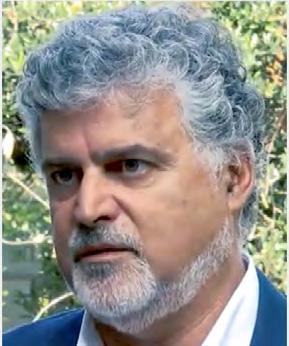
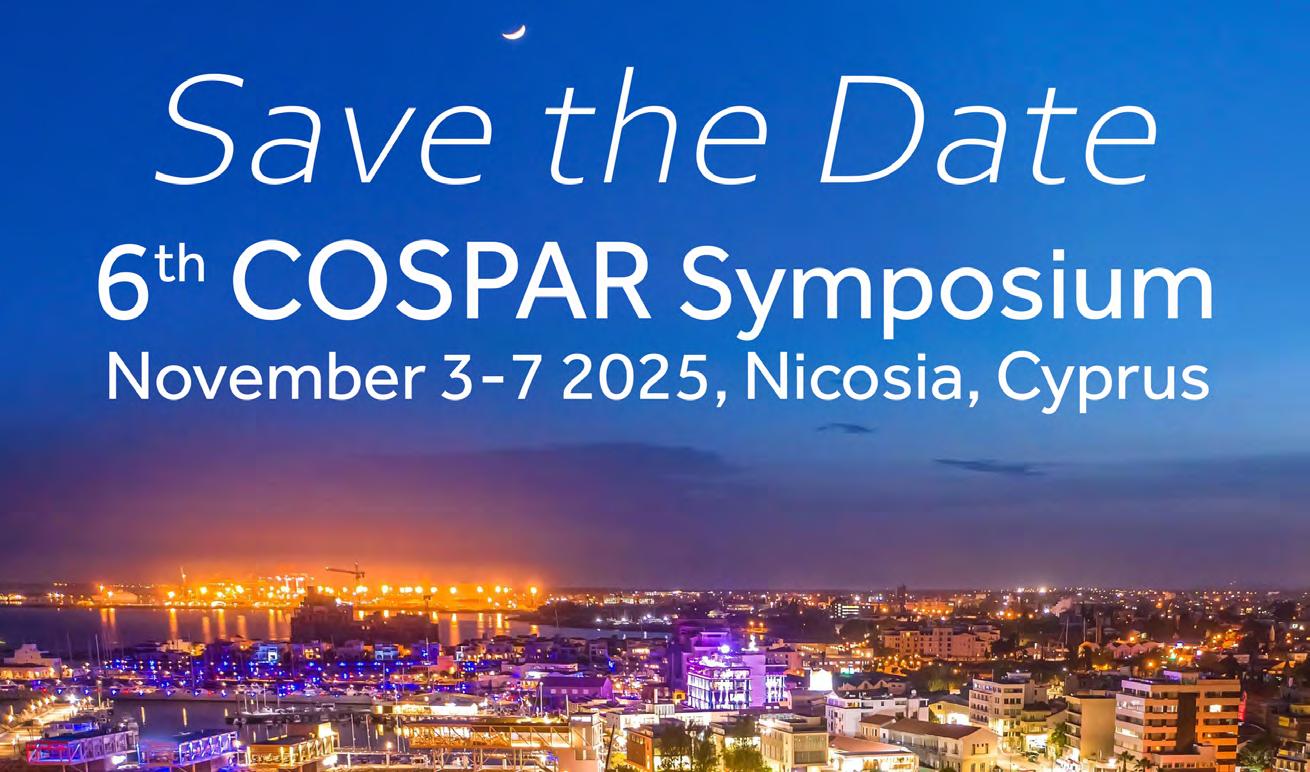
Iossif Papadakis, SC E Chair
Scientific Commission E (SC E) is COSPAR's scientific commission dedicated to the study of the Sun (from its atmosphere inwards to its centre), and to space science beyond the borders of our solar system. It is divided into two Sub-Commissions: E1 on "Galactic and Extragalactic Astrophysics" and E2 on "The Sun as a Star".
The first Sub-Commission, E1 (SCE1), deals with a variety of astronomical objects and phenomena, of various sizes (from elementary particles, compact objects to galaxies) and at various distances (from our own Galaxy to the most distant galaxies formed a few million years after the Big Bang). As an example, frequent events associated with SC E1 in COSPAR Scientific Assemblies are focused on the origin of cosmic rays, on the theoretical and observational study of X-ray binaries with compact companions (like black holes and neutron stars) in our Galaxy and in distant galaxies, on active galactic nuclei (AGN) and quasars, which are the most luminous, persistent objects in the Universe, on transient phenomena in galaxies, on the intensively star-forming, ultra-luminous galaxies, on gamma ray bursts, and on gravitational waves.
Sub-Commission E2 (SC E2) deals with the study of the Sun as a star including, in particular, the theoretical and observational study of solar structure and radiation. All the energetic phenomena associated with the Sun's photosphere, chromosphere and corona, relevant to solar wind acceleration, energetic particle generation, flares and coronal mass ejections, are covered by COSPAR's Sub-Commission D2(E3). SCE2 is mainly interested in the study of the solar interior structure and dynamics, on the mechanism of solar magnetic cycles, the structure and dynamics of the lower solar atmosphere, including phenomena that influence its radiation and energetic balance. SC E2 also deals with the study of the structure of the solar magnetic field because of its relevance and
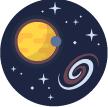
implications to the understanding of the solar-stellar connection. Finally, SC E2 deals with the sources of solar irradiance and its long-term variability.
Like all COSPAR Scientific Commissions and Panels, the main objective of Scientific Commission E is the advancement of space science. This is mainly achieved by the organisation of numerous events during each General Assembly, which acts as a platform or all relevant space scientists worldwide to discuss, exchange knowledge, and collaborate without barriers. The main activity of SC E in the months since the end of the last General Assembly in Busan has been the preparation of the Commission’s events for the next Assembly in Florence in 2026. This involved intense discussions and exchange of ideas, as well as constructive collaboration between numerous scientists in a wide range of research areas. The result of this worldwide networking has been the assembly of a highly exciting, diverse and ambitious scientific program of 23 events for SC E1, and 6 events for SC E2 in the next Scientific Assembly. There is also the general event SC E0, which was first suggested and organised by the late T. Belloni. This event will also be organised in Florence 2026. The main focus of the event is the celebration of all the recent, significant and high impact scientific events that have taken place the last couple of years within the space research activities near (the Sun) and beyond.
As is the case in many of the Scientific Assemblies, SC E will include the largest number of scientific events compared to all other Scientific Commissions in Florence 2026. The SCE program is eclectic, addressing numerous research topics that are in the forefront of the research activities relevant to SCE, worldwide. The months until next summer will be undoubtedly quite busy for many researchers around the world. Whilst some will be engaged in organising the SC E events as best as
possible, many more will start preparing the research programmes and the presentations of their results in these events.
It is probably true that the largest number of COSPAR Associates are scientists who work on research fields that are covered either by SC E1 or SC E2 and have participated in a SC E1 or SC E2 event in one of the past Assemblies. This situation will probably be reinforced in the near future (starting from Florence 2026) as the development of space science research in the topics of solar, galactic and extragalactic astrophysics will strengthen and increase in the near future. It is one of the most important objectives of SC E to support as best possible the collaboration and exchange of scientific results among the growing community.
Another objective that this Scientific Commission may consider is to foster and strengthen the collaboration between spaceborne and the ground-based research facilities, for the advancement of astrophysics, in general. It is true that knowledge of the cosmos at large (and in our neighbourhood) has been revolutionized

Iossif Papadakis has been the Chair of COSPAR Scientific Commission E since July 2024. He received his PhD in astrophysics from the Queen Mary & Westfield College of the University of London (UK) in 1992. He moved to the Physics
by spaceborne missions and satellites that have been launched the last decades, observing astronomical objects from the far infrared to optical and UV, as well as X-ray and gamma rays. At the same time, major groundbased facilities (from the Keck and the VLT to the ELT, Rubin Observatory, ALMA and SKA, to name but a few) have started, or will start operations in the near future. Many of the research presentations in many of the SC E events report results from both the ground-based and the space observatories anyway.
However, SC E could start considering how it may help to coordinate the discussion and exchange of ideas that could lead a common effort to focus activities regarding a closer collaboration between future space missions and ground-based facilities. It is possible that future space missions could be planned and designed by considering their complementarity with respect to the existing and/or planned ground based facilities, and the improvement they can offer to the common science objectives. Such an action could offer a significant service to the community, and it should be considered a priority for future SC E activities.
Department of the University of Crete in the late 1990s, where he still works as a Professor of Astrophysics. His main scientific interests lie in the area of extragalactic, high energy astrophysics, with the main emphasis on active galaxies.
In particular, he is very much interested in the study of their X-ray, UV and optical variability.
Laurent
The Space Center of University of Montpellier (CSUM)
– UAR 502 is a leading academic space center based at the University of Montpellier, dedicated to the development of nanosatellite missions and the training of the next generation of space professionals. Founded in 2011, CSUM combines cutting-edge infrastructure, handson education, and close industry collaboration to create a unique environment where students, researchers, and engineers work side-by-side to design, build, test, and operate CubeSats. Our mission is threefold:
• Education through real space missions – We integrate students at all levels into every stage of a satellite project, offering a truly immersive learning experience.
• Technological innovation – We design and deliver complete nanosatellite missions, from concept to
launch and in-orbit operations, including payload development and systems integration.
• Research & industry partnership – We collaborate with national and international institutions (such as CNES, ESA, and CERN) and major aerospace companies to advance space science, engineering, and sustainability.
Over the past decade, CSUM has successfully launched multiple CubeSats - including ROBUSTA1A, MTCube, CELESTA, and ENSO - contributing to fields such as radiation monitoring, electronics reliability, solar physics, and environmental observation. Our facilities include clean rooms, a satellite operations control center, thermalvacuum chambers, a concurrent engineering center, and ground stations, ensuring we deliver fully autonomous and professional-grade missions.
The Fondation Van Allen, created in 2012, is the strategic and financial arm of CSUM, established under the aegis of the University of Montpellier. Named in honor of American physicist James Van Allen — pioneer of space radiation research — the foundation supports and amplifies the center’s activities through fundraising, partnerships, and talent development initiatives. The foundation’s core objectives are:
• Sustainable funding – Through a mix of public and private support, including contributions from partners like Airbus
Defence & Space, 3DPlus, Expleo, and Latécoère, the foundation secures key resources for infrastructure, equipment, and staff.
• Training & inclusion – It funds engineering positions, internships, and scholarships for students, including international collaborations with countries such as Senegal and Djibouti.
• Community engagement – The foundation hosts professional events, technical workshops, and “Partner Clubs” that strengthen ties between academia, research, and industry.
To date, the Fondation Van Allen has financed over 370 student internships, enabled the hiring of numerous young engineers and researchers, and helped launch
Launched by CSUM and the Foundation Van Allen, the DESDEMONE program aims to develop a dedicated nanosatellite that will improve the detection and tracking of floating macro plastic waste to collect it more effectively from the seas and oceans. The proof of concept is carried out at sea in the Mediterranean. With a launch by the end of 2028, this mission marks CSUM’s commitment to environmental surveillance from space. The acronym is coined from the French title: “Une réponse intégrée au défi de la gestion des macro déchets plastiques marins”
Mission Goals
• Detect large concentrations of floating plastic before they sink or reach shores.
• Track the movement of these pollution zones in coastal and riverine outflows.
• Enable valorization by facilitating rapid cleanup efforts once plastics are identified.
• Collecting more data on macro plastic waste flow to refine the models
Technological Approach
DESDEMONE will use an hyperspectral camera capable of distinguishing plastics from seawater by their unique infrared absorption signatures—a technique validated
several CubeSat missions that have made a measurable impact in both scientific and educational arenas.
in ground studies by CSUM and the CEFREM/CNRS team of Perpignan.
Partners & Funding
Key technical collaborators include:
• CEFREM (CNRS / Univ. of Perpignan) – expertise in spectral indices
• Geomatys (Montpellier) – data analytics
• ReSeaclons (Occitanie Region) – act for collecting and recycling marine plastic waste
• Groupe Nicollin – waste management specialist and major benefactor.
To date, >€100 k has been invested by CSUM and the foundation to initiate development since 2021, with a broader fundraising campaign under way to secure €5–7 million over four years.
Timeline & Impact
• Technical development – Mechanical and electrical architecture defined; structural model passed vibration tests.
• Launch window – Anticipated Q4 2028.
• Data operations – First plastic-tracking dataset expected by late 2029, enhancing marine cleanup and coastal preservation initiatives.
Together, CSUM and the Fondation Van Allen are building one of Europe’s most dynamic university-led space programs. Through a shared commitment to excellence, accessibility, and innovation, we are proving that space is not only for large agencies or corporations but also for universities, students, and nations taking their first steps into orbit.
Want to collaborate, study with us, or support our mission? Contact us at: https://csum.umontpellier.fr/en/home/ https://fondationvanallen.edu.umontpellier.fr/en/home/
Saint-Priest’s Campus 950, rue Saint-Priest, Building 6 34 090 Montpellier FRANCE
csum-contact@umontpellier.fr
The EXPLORE (EXpeditionary Program for Learning OppoRtunities in analog space Exploration) Erasmus+ EU-co-funded project reached a major milestone in June with the first simulated mission for high school students. COSPAR was there to support the young analog astronauts, teachers and partners. Here’s a brief report.
For almost a year students from Austria, Greece and Portugal have been preparing for this lifechanging moment. Through the EXPLORE project activities and toolkits they have been learning about space exploration and its significance in our daily lives, understanding the importance of preserving the Earth’s environment with hands-on experiments, improving their digital skills, becoming problem solvers, and learning to collaborate. They took part in intensive online training with analog mission professionals from the Austrian Space Forum (OeWF). They also discovered new digital solutions while their teachers were introduced to innovative student-centred methodologies, new tools and technologies that make it easier to integrate digital content into their curricula.
From 23 to 27 June, this learning and practice was put to the test. The nine students (three from each participating country) and their accompanying teachers were taken to the challenging, barren environment near Monsaraz, in an isolated region of Portugal, leaving them far from friends and family. It was not a simple school trip, but a full mission, replicating a space mission on Mars, with all the related detailed planning and procedures necessary for safety, scientific accuracy and discovery, and using space suits identical to those used in space but without the pressurisation and full radiation protection. Becoming analog astronauts for a week involved six of the students providing full support in the Mission Support Centre (MSC) as Flight Director, Ground Support, Procedures and Records, Remote Science Support, Media, and Flight Plan, while three students were field crew in the habitat: Crew Commander for Analog Astronauts 1 and 2, taking instructions only from the MSC via chat. Students took
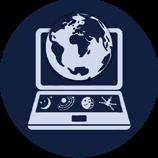
turns in each role for the week. The teachers were on hand for safety and guidance when needed, but by and large, the mission was carried out by the students themselves, from the planning of traverses, to finding solutions to equipment malfunctions, dealing with media, and carrying out scientific experiments, writing up reports, keeping their log books updated—and, especially, communicating clearly as part of an international crew.
"Without the pressurisation and full radiation protection"
“Being connected only through chat might sound like everyday routine, but it’s not. Explaining complex problem-solving processes via chat alone is significantly more challenging, and it sends your adrenaline skyrocketing,” said Austrian teacher Andrea Mühlegger who was on-site during the mission. “I was amazed at how quickly the students turned into professionals, fully aware of their responsibility for the lives of the analog astronauts and the success of the mission. They worked together with intense focus and faced major challenges, even though they had only just met a few hours earlier.”
Portuguese teacher Teresa Sousa was also impressed by the students: “The EXPLORE project inspires dreams and makes us believe in the best that young people have to give.”
For many of the students, there were unexpected difficulties. In the debriefing that followed, we heard that although they knew they would be isolated, it did not really hit them until the door of the habitat closed when it was their turn to take on the role of field crew. They did
not realise that they would have to solve any problems that arose by themselves. The tinned food on the menu made them appreciate the fresh meals they had enjoyed “back on Earth”. Those in the habitat missed fresh air, and all of them realised how much they relied on their smart phones. They also learned the hard way about the importance of following procedures exactly—one failure in this respect led to the early “death” of two of the field crew after the habitat door had been left open during an EVA (they were miraculously resuscitated when a long report on the incident was written).
And the students were equally enthusiastic, even after a week of hardships.
“Regardless of differences, regardless of origin, science is the chain binding scientists together as a big, successful and trustworthy community. Science unites. With the EXPLORE project students from three different nations, each with their own language and culture, are working side by side toward a shared goal. This collaboration is what brings people closer together,” said Fabian and Daniel, students from Austria.
“EXPLORE is a project that I’m truly passionate about, and I’m thrilled to be a part of it. For me, it’s an incredible opportunity to dive deeper into the areas of science that I love and to actively engage with them. I’ve been studying physics since a very young age, it’s always been a subject close to my heart, so this project has given me the chance to both apply and deepen my knowledge. For example, I’ve been learning about the physics of Mars to better prepare myself, and with EXPLORE, I’ve gained a deeper understanding of scientific experiments and the work of astronauts.
What I enjoy the most is being part of discussions where my questions are met with actual answers from people who understand them, and where curiosity is encouraged. I’m excited to keep learning and growing as the project continues. Thank you for this amazing opportunity!“ said Patrícia A. F. Miguel, one of the Portuguese students.
“I’m thrilled to be part of a mission that not only simulates Mars but also ignites the explorer within us all,” said Angelika Mara, a student from Ellinogermaniki Agogi, Greece.
“For me, this experience could help me better understand
the situations and problems that may arise, as well as personally experience what can happen during space missions, said Frederico Jesus, from Escola Secundária de Paredes, Portugal.
Due to the exceptional nature of this analog mission, there was considerable interest from schools and the media. The students organized online interviews with Austrian schools and a radio station, HitRadio OE3 Lusa , a Portuguese news agency, issued a media press to Portuguese media, and the project was featured in the online editions of Público, Expresso and Forbes Portugal , as well as many other newspapers, magazines, and online platforms throughout the country. On the penultimate day, SIC TV station was on site to film a report aired in the Sunday afternoon news and on SIC Notícias, and TVI station was present on the final day. The Portuguese students have also participated in the program Radar XS , on RTP , the Portuguese national broadcasting channel.
Kostas Nousis, one of the accompanying teachers in the mission from Ellinogermaniki Agogi, Greece, enthused: “My participation in the EXPLORE program has been a unique experience – unlike anything I’ve encountered so far in my educational career. It is one of the most innovative educational programs ever implemented at a European level and has truly inspired and captivated all the participants.”
To underline COSPAR’s commitment to such new approaches to science education, COSPAR General Counsel Niklas Hedman delivered a statement by COSPAR during the COPUOS plenary meeting on 30 June 2025 of its 68th session, specifically mentioning the EXPLORE project and the first mission. Read the statement here.
This first mission and the lessons learned has enhanced the second EXPLORE Summer School for teachers in Marathon, Greece, 6-11 July. On hand to answer questions from the eight educators taking part this year was Nestoras, one of the Greek students on the EXPLORE 1 mission. He led one session with a first-hand account of his experience as an astronaut for a week, and was a lively source of facts and anecdotes about his time in the habitat and working as part of an international crew. Asked if he would repeat the experience and go
on another analog mission, he answered “yes” without hesitation, “a thousand times yes!”.
During the summer school, teachers had time to familiarise themselves with the virtual toolkit, try out the space suit and carry out EVAs, albeit brief ones, because of the heat. They learned about the different responsibilities for each post in a mission and practised them using role-plays, working on mission planning during group work. They also had time to help develop activities for their own classes, finding ways to integrate the topics into their school programme.
On completion of the summer school, all the participants were awarded a certificate and have now returned “back to Earth” with plenty of ideas for the coming academic year. We look forward to following their progress.
[from Leigh Fergus, SRT Executive Editor]
If you know of any teachers in high schools or education officials interested in helping students learn life skills for the future, please share the EXPLORE website with them, and follow the project on Facebook and Instagram
EXPLORE – EXpeditionary Program for Learning OppoRtunities in analog space Exploration – is an Erasmus+ funded project under Action Type: KA220SCH – Cooperation partnerships in school education. Grant Agreement nº 2023-1-AT01-KA220-SCH-000154094. Period: September 2023 – August 2026

Funded by the European Union. Views and opinions expressed are however those of the author(s) only and do not necessarily reflect those of the European Union or OeAD-GmbH. Neither the European Union nor the granting authority can be held responsible for them.
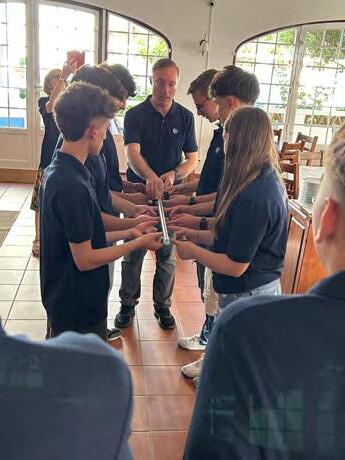
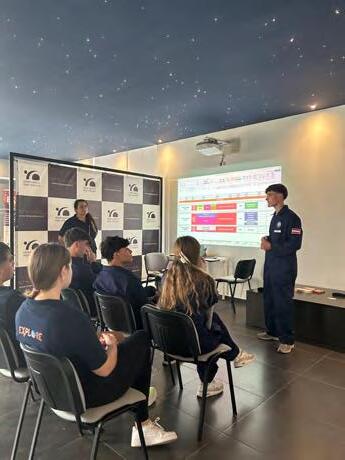

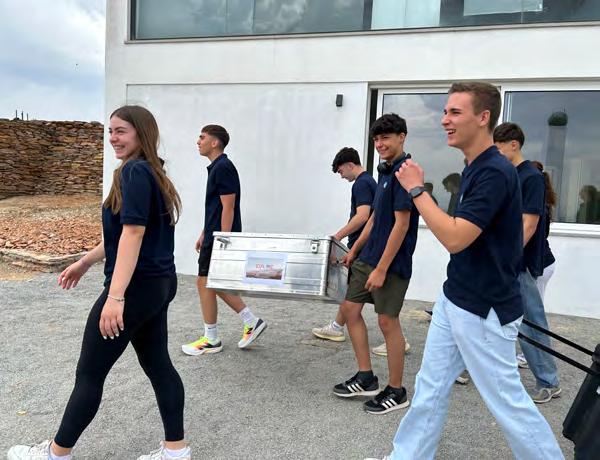
The project is led by the Austrian Space Forum (OeWF), in collaboration with COSPAR, NUCLIO, Ellinogermaniki Agogi , and OLA-Observatório do Lago Alqueva ▲ Left: Building trust in teamwork. Centre: Introduction to the analog mission. Right: Transporting the EXPLORE mission toolkit.
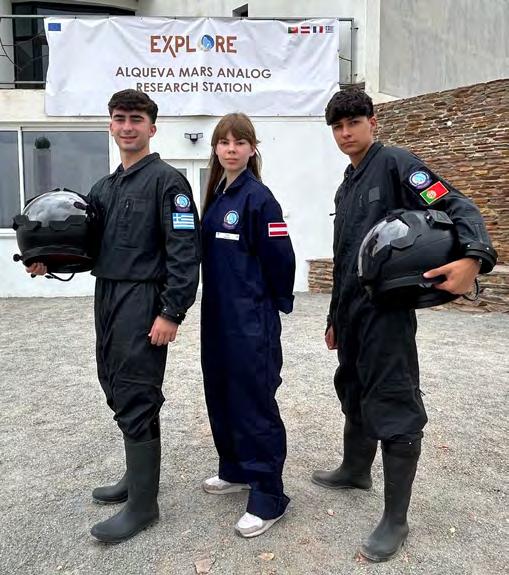
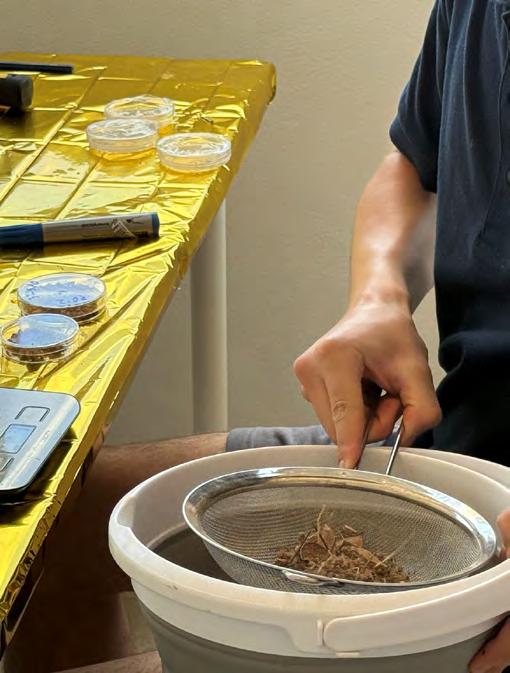
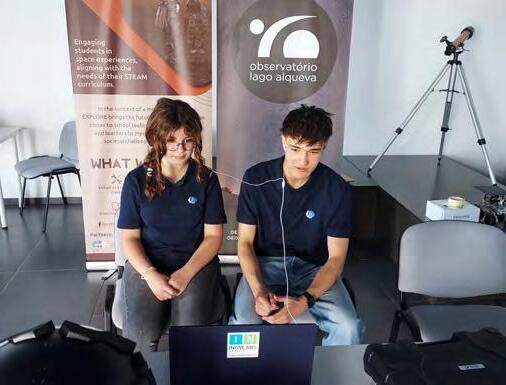
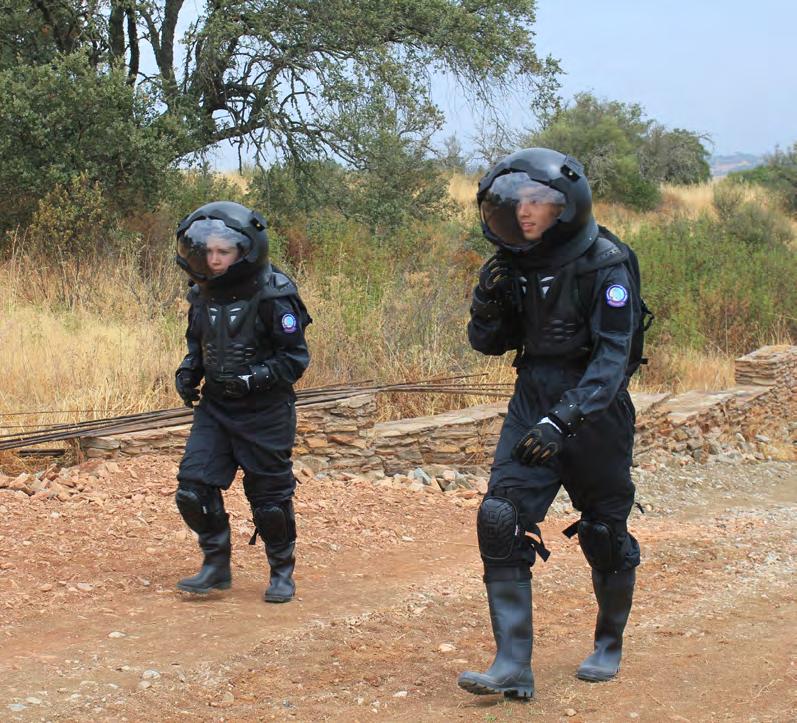
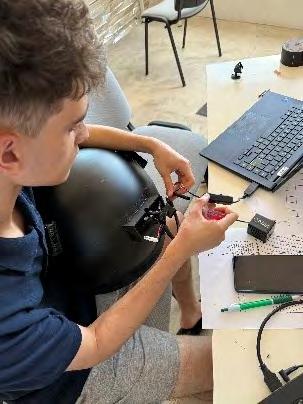
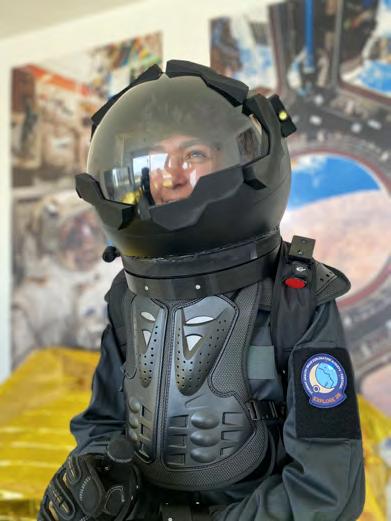
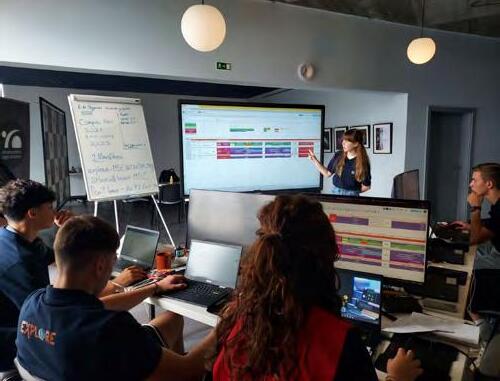
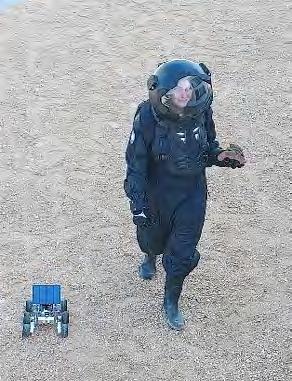
This year COSPAR was present again to support the second StAnD Summer School in Marathon, Greece. The five partners of this Erasmus+ project (INAF—lead partner, NUCLIO, Ellinogermaniki Agogi (EA), FTP Europlanet and COSPAR) welcomed a lively group of 14 teachers from five participating countries: France, Germany, Greece, Italy and Portugal. Maths, physics and chemistry teachers worked alongside music and IT teachers during the week—because StAnD welcomes teachers of all subjects who are passionate about the night sky! On the schedule were informative sessions, in a seminar format, on small bodies in the Solar System, delivered by Dario Barghini (INAF), with step-by-step exercises to get to know software for using robotic telescopes such as the Faulkes telescopes and how to observe asteroids by Lothar Kurtze (FTP Europlanet) and Gustavo Rojas (NUCLIO).
Dario Barghini also gave a detailed presentation of the meteor detection camera kit provided for selected schools and how all the schools in the project can use the data from these cameras in the classroom. Angelos Lazoudis (EA) was also on hand with Gustavo Rojas to present the StAnD educational resources, including online materials, simulations, software, videos, and hands-on activities that can be used by the students to explore and understand the various topics related to asteroids, comets, meteors, meteorites, and planetary defence. This material was created by fully applying Universal Design for Learning (UDL) principles, enabling students to have agency over their learning.
Seda Özdemir-Fritz and Lothar Kurtze (FTP Europlanet) presented a small collection of meteorites and Seda demonstrated how to make the most of the micrometeorite kit. Approximately 3,000 tons of cosmic dust falls to the surface of the Earth annually, and StAnD will enable school children to carry out searches for these tiny particles. The micrometeorite kit is a physical toolkit that is loaned to schools, to hunt for and identify micrometeorites. After initial analysis using the kit’s microscope, magnet, and some chemical reagents, the most promising samples will
receive closer inspection with partner institution electron microscope images—and possible validation of candidates by micrometeorite experts from European natural history museums. The project aims to highlight the results of these investigations on the project website and publish in relevant journals in collaboration with the pupils wherever possible.
These indoor sessions were complemented by outdoor activities such as a meteorite hunt and solar observation. The meteorite hunt took place after the organisers “heard a report” of a timely and very local meteorite shower near the beach in Marathon. After a quick review of what constitutes a meteorite, and how to distinguish it from an ordinary stone or rock, the teachers formed a tight line to start combing the area where the meteorites were expected to have fallen. Despite the heat of the near midday sun (possibly also the cause of the increasingly loose line, two meteorite candidates were eventually identified. This demonstrated the difficulty of the task and the importance of rigour and consistency in such searches, just as for any
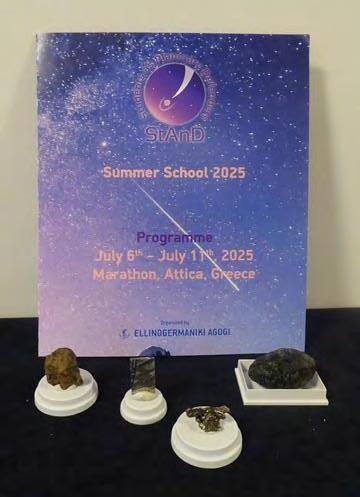
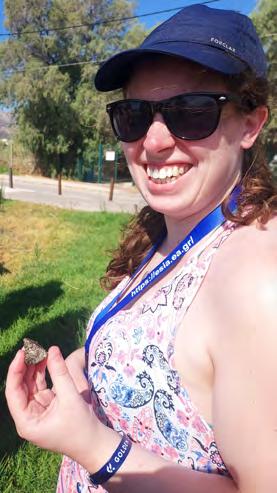
▲ On the left: A sample collection of meteorites to help students of all levels learn how to identify these celestial visitors. On the right: Success ! After a careful hunt combing an area, Tabea from Germany finds a meteorite.
scientific experiment. The outdoor session continued with solar observations, guided by Georgios Athanasopoulos (EA) who helped the educators look for flares and sunspots with a telescope kitted out with a protective lens and filter.
The teachers jumped in from the start with questions at each session, and were keen to try out all the material. At the end of the week, they had the opportunity to work on their own teaching scenarios, integrating one or several of the toolkits or activities proposed during the week. They presented their scenarios on the final day, for evaluation by the partner tutors, and were awarded a certificate of achievement. The certificates, along with their photos and notes taken during the six-day summer school, will continue to motivate them to incorporate the methodologies and tools provided by StAnD in the coming academic year. Hugo, an IT teacher from Portugal said “I am now hoping with my students we can find a new object in the sky.” And Chiara, a music teacher from Italy is keen to spread the word, “I hope to be able to share [what I learned] with my fellow teachers and students next year at school.” We look forward to following their progress!
As Pierre Tricot, a maths teacher from France, said “It’s a very cool opportunity for our students to learn more about the Solar System.” [from Leigh Fergus, SRT Executive Editor]
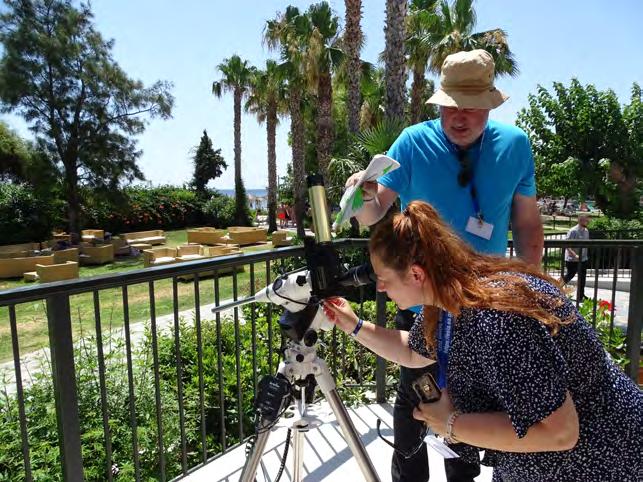
If you know of any teachers interested in this topic and joining this growing community, please share this article and direct them to the website at https://projectstand.eu/
And follow StAnD on Facebook!
Find out more at the COSPAR Symposium Education Weekend, see page 69.
Funded by the European Union. Views and opinions expressed are however those of the author(s) only and do not necessarily reflect those of the European Union or OeAD-GmbH. Neither the European Union nor the granting authority can be held responsible for them.



use the
[By P. Ehrenfreund1, M. Blanc2, N. Hedman3, T. Masson-Zwaan4, W. Peeters5, J.C. Worms3 (2025)]
1 Space Policy Institute, George Washington University, Washington DC
2 Research Institute in Astrophysics and Planetology (IRAP), CNRS-University Toulouse III – CNES, Toulouse, France
3 Committee on Space Research COSPAR, Paris, France
4 Leiden University, International Institute of Air and Space Law, The Netherlands
5 International Space University, Illkirch Graffenstaden, France
Exploring space around us is an integral part of the human mindset. With modern astronomy we look far into the cosmos and deep into our past, and the spectacular development of Solar System exploration over the last decades has taught us a lot about the “big science questions” we have about its origin, the mechanisms that drive its evolution, and the habitability of its diverse worlds. This great harvest of discoveries has provided partial answers to these “big questions”, but it has also opened new and deeper questions about our relation to the Cosmos that can only be answered by the next waves of exploration missions: we are still far from seeing humankind become an “interstellar species”.
Human and robotic exploration are currently undergoing a major transformation, with a surge in missions to the Moon, Mars, and near-Earth asteroids and an increased emphasis on space resource exploitation and utilization. Emerging space nations and private companies are playing a growing role, boosting the deep space exploration industry. Deep space technology is advancing rapidly, often requiring global collaboration. Recent forecasts predict a surge in lunar missions, both robotic and human, laying the groundwork for future Mars exploration. Over 150 lunar missions are planned through 2034 (Brycetech 2024 [1], Novaspace 2025 [2]). Even if this figure may have to be revised in the current geopolitical context, three major elements demonstrate the reality of a strong boost for exploration that focuses on the Moon.
While the science of the Cosmos encompasses the entire Universe, human exploration is for the time being limited to the Earth’s space environment, the Moon, Mars and asteroids. But, while more limited in its cosmic perspective, human exploration introduces new sciences and technologies into the equation: physics and materials in micro-gravity, life sciences in space, the sciences and technologies of ecosystems, human habitats, human behavior in society, ecology and up to space law and economy. Thus, it is fair to claim that human exploration opens exploration as a whole to a broader, interdisciplinary dimension of scientific inquiries and technological challenges.
A first important element is the interest for space exploration of space-faring nations such as India, Japan, the United Arab Emirates and many emerging space nations. Their increasing interest represents an unprecedented stimulus.
Secondly, the two dominant lunar exploration initiatives, Artemis and the International Lunar Research Station (ILRS) [3,4] provide a major impetus via their broad international scope. The Artemis Accords, a US-driven initiative promoting peaceful and co-operative lunar exploration, counts at present 55 signatories. The science drivers of the ILRS program, an initiative led by China and Russia, are well identified and convincing and offer access to compelling science for limited costs for several new national space players and many scientific institutions. Interestingly, one country, Thailand,
and several NGO’s have signed both agreements.
The third important element is the concept of commercial ventures, sometimes labeled the “New Space Race”. A new
generation of entrepreneurs and many start-up companies have turned their interest to space exploration, driven partly by visionary motivation, and partly by the search for profitability inherent in entrepreneurship.
All three elements contribute to the same goal of ultimately establishing a sustainable human presence on the Moon, an objective that will require decades of effort, robust infrastructure, and international coordination. Insitu resource utilization (ISRU) will be key to sustaining these efforts by providing the resources needed to support all types of activities, scientific, industrial, commercial and possibly touristic, on the lunar surface. This new era of space activities will need to ensure an equitable sharing of these resources between various political, commercial and scientific interests, thus providing the first major practical test to the concept of space sustainability beyond Earth orbits.
However, as human presence imposes the use of local resources and the development of infrastructures, it also introduces a new threat in the exploration of celestial bodies, via its potential negative impacts on their natural environments. If we ignore them, these impacts may grow in an uncontrollable way with time. The issue of the disposal of space debris in cis-lunar orbital regions and on the lunar surface will require the development of sustainable end-oflife strategies for spacecraft that are the current subject of intense research.
To address this major threat, Planetary Environmental Stewardship must serve as a guiding principle for
exploration and utilization. The concept of “Sustainable and Safe Lunar Activities” has been the subject of thorough investigations by numerous international bodies, including the United Nations Committee on the Peaceful Uses of Outer Space (UNCOPUOS), resulting in the publication of several comprehensive reports. Our current understanding of environmental impacts on the Moon and Mars is still limited, public awareness of these impacts remains low, and there is no consensus yet on the term "harmful contamination" [5].
The term is not legally defined in Article IX of the 1967 Outer Space Treaty, although in the context of planetary protection those provisions in Article IX on forward and backward contamination are acknowledged and applied in exploration missions. But various studies have explored sustainability, waste management and circular economies, and there is a growing call for visionary policies to extend Earth’s sustainability principles to space, promoting an integrated "Earth-space governance" model to ensure justice, sustainability, and integrity for all life forms in a multi-planetary future [6] To move forward, a broad dialogue across the space ecosystem—including public stakeholders, industry, investors, and the public—is crucial for understanding and promoting planetary sustainability, considering exploration and space resource utilization interests as well as environmental and cultural heritage issues.
The 1967 Outer Space Treaty, with 116 State parties, provides a general framework for the development of a global governance of space exploration and of safe, peaceful and sustainable Lunar activities.
Its principles set out the core foundation for the exploration and use of outer space, including the Moon and other celestial bodies. Though not always providing the desired level of detail, it nevertheless established a solid international law basis from which other instruments may emerge, such as guidelines and principles addressing sustainable activities
on the Moon and other celestial bodies. The 1979 Moon Agreement is far clearer on those points but has not been ratified by the major space-faring nations. In comparison with other international governance regimes, the 1982 United Nations Convention on the Law of the Sea (UNCLOS) makes a distinction between prospecting, exploration and exploitation of the deep seabed beyond national jurisdictions [7]. Also of interest is the Agreement on Marine Biological Diversity of Areas beyond National Jurisdiction [8]. With a potential future conflict of interest between space exploration and space resource utilization, there
should be a closer engagement between the different user communities to establish the parameters for cooperation and synergies, for instance in the prospecting as well as exploration phases of future extraction of space resources. In this overall context, the 2025 proposed initial draft set of principles on space resource activities, written under the auspices of the UNCOPUOS Legal Subcommittee Working Group on Space Resource Activities (document A/AC.105/C.2/L.339) is an interesting first step towards a negotiated framework for lunar sustainability.
Indeed, international efforts are intensifying to ensure sustainable lunar activities. Open Lunar Foundation aims to ensure a peaceful and cooperative presence on the Moon, through collaborative technology, policy and infrastructure. It envisions a long term human presence on the Moon demonstrating collaborative governance and stewardship, and emphasizes the importance of shared infrastructure in that context. Its recently launched flagship project, the Lunar Ledger, offers a neutral, open-access database where missions can be registered and activities tracked, helping reduce risks, avoid site conflicts, and build trust across the sector (www.openlunar.org). The Global Expert Group on Sustainable Lunar Activities (GEGSLA) has released a Recommended Framework promoting safe operations, environmental protection, and governance on the Moon [9]. The voice of young space professionals is compiled in the Space Generation Advisory Council's “EAGLE Report” that proposes a Lunar Governance Charter to guide international collaboration [10].
The Lunar Policy Platform's "Lunar Policy Priorities" report identifies ten key areas for safe lunar development and suggests a Lunar Policy Decalogue [11]. In its recent report
“Space Exploration: keeping the momentum going”, the Air and Space Academy (AAE) argues that planetary activities must be carried out in a safe, sustainable, and symbiotic manner, emphasizing the need for systematic environmental impact assessments to rigorously evaluate and refine mitigation measures [12]. Consequently, the establishment of an environmental database for celestial bodies is of paramount importance.
At the UN level, UNCOPUOS established in 2024 the Action Team on Lunar Activities Consultation (ATLAC) to foster global dialogue. These initiatives underscore the importance of transparency, stakeholder alignment, and environmental stewardship in lunar governance. With rapid space sector growth, ethical and timely complementary frameworks and instruments are crucial in fostering a legal order of contemporary exploration and use.
In 2019, UNCOPUOS adopted the Guidelines for the Longterm Sustainability of Outer Space Activities, addressing policy, safety, cooperation, and research, and which in Guideline D.1 emphasize the promotion and support of research into and the development of ways to support sustainable exploration and use of outer space. ESA’s “Revolution Space” report (2023) calls for a sustainable European space strategy [13]. In 2019, The Hague International Space Resources Governance Working Group drafted “Building Blocks for the Development of an International Framework on Space Resource Activities” [14]. NASA’s Artemis, Ethics and Society Workshop (2023) stressed the need to address the ethical and societal impacts of space initiatives [15]. Similarly, GEGSLA’s 2024 Project Plan advocates for the sustainable management of lunar heritage [16], [17]
As outlined in the introduction, scientific research greatly benefits from space exploration, not only in our understanding of the Solar System and of the Universe in which we live (via robotic exploration and space astronomy) but also for many scientific and technical disciplines that are intrinsic partners of human exploration.
But at the same time, the imperious requirement of environmental stewardship of celestial bodies calls for a deeper, more balanced, two-way and win-win partnership between Science and Exploration:
• Exploration is an enabler of new scientific quests: while offering
a deeper insight into the specific cosmic destinations Moon, Mars and asteroids, exploration also offers new opportunities for a diversity of sciences, for instance in astronomy (astronomy from the Moon or in orbit), in life sciences and plant/animal/ human physiology, in ecosystems, economics, international trade, space law etc.
• Science is an enabler of exploration: understanding and assessing the impacts of exploration on natural cosmic environments, and finding solutions to mitigate these impacts, is a major interdisciplinary scientific challenge involving a broad spectrum of disciplines.
COSPAR, because of its broad coverage of the various scientific disciplines that benefit from space and of its close proximity to all space exploration stakeholders, is the ideal body within which to develop and implement this win-win partnership between Science and Exploration. For 67 years, COSPAR has led international scientific cooperation in space, promoting peace and collaboration on a global scale.
Founded during the Cold War as a neutral forum, COSPAR has consistently facilitated vital dialogue and partnerships across the global space community. In today’s rapidly advancing space sector, COSPAR’s role is more crucial than ever. While COSPAR mainly represents space scientists and space sciences, its effective collaboration with other stakeholders is essential to ensure that the latest scientific knowledge informs space policy and regulations. In particular, partnerships between industry and research organizations, key to strengthening the space ecosystem— uniting expertise, resources, and innovation to accelerate progress in technology and exploration—are vigorously discussed within its Committee on Industrial Relations (CIR).
COSPAR was also one key partner in a recent initiative to define so-called ‘Sites of Special Scientific Interest’ (SSSI) on the Moon. The objective is to agree with all concerned stakeholders on an international process to define SSSI and enforce their preservation, taking stock of existing scientific as well as industrial constraints and requirements. The related discussion with several partners, namely the International Astronomical Union (IAU), the International Academy of Astronautics (IAA) and the Moon Village Association (MVAGEGSLA), has led to the submission of a Conference Room Paper on this matter, which was delivered by COSPAR, IAU, IAA and MVA at the February 2025 meeting of UNCOPUOS’ Scientific and Technical Subcommittee [18]
With 48 national scientific institutions and 13 international scientific unions, COSPAR draws on the expertise of over 14,000 space scientists. Its eight scientific commissions span all disciplines of space science, offering unique fora to discuss all the components of science contributing to exploration, while 16 panels and task groups address specialized topics, driving progress through biennial Scientific Assemblies, symposia, space projects, roadmaps, and publications.
The COSPAR Panel on Planetary Protection (PPP) has, for over six decades, upheld the principles of the 1967 Outer Space Treaty. It provides guidance on avoiding biological contamination of celestial bodies and protecting Earth from extraterrestrial matter, by developing and disseminating international standards. This work is carried out in collaboration with space agencies, scientists, industry, and UNCOPUOS representatives. COSPAR recently released its updated Planetary Protection Policy [19]. The COSPAR Panel on Potentially Environmentally Detrimental Activities in Space (PEDAS) tackles space debris issues, including research on upper atmosphere contamination and policy development for managing cislunar space debris.
The COSPAR Panel on Exploration (PEX) represents the interests of scientists from all disciplines and from all countries in an exploration endeavor which is naturally led by public, international and more and more private entities, i.e. the “stakeholders”, and is therefore only partly “science driven”. Building on the heritage of the previous COSPAR Exploration RoadMap (Ehrenfreund et al., 2012 [20]), it will coordinate the drafting of a new edition of this COSPAR Exploration RoadMap that will address three overarching goals:
A. Promote Space Sciences (or science in space) as Key Drivers of Space Exploration (without limiting them to natural sciences)
B. Maximize the Scientific Return of space exploration by stimulating International Cooperation for the benefit of all sciences in space
C. Promote Environmental Stewardship in Space Exploration
In addition to COSPAR, other organizations such as the Secure World Foundation, the Lunar Policy Platform and several others are drawing attention to our ethical and moral obligations towards sustainable space exploration.
The imminent involvement of commercial interests—while a valuable source of resources—heightens the need to establish appropriate boundary conditions, a topic several of the authors explore with support from the John Templeton Foundation. In a recent article, Peeters & Ehrenfreund (2025) [21] proposed the key elements and steps needed to support future space exploration strategies and reach a balanced agreement:
• Advancing innovative space ecosystem funding
• Accelerating regulatory frameworks for fast implementation
• Encouraging cross-cultural and interdisciplinary cooperation
• Driving progress in sustainable and ethical practices
• Enhancing communication with societal stakeholders
As the first permanent organization granted observer status to UNCOPUOS in 1962, COSPAR closely supports the United Nations Office for Outer Space Affairs (UNOOSA) through its integration into UN technical committees. Other COSPAR panels—like Innovative Solutions (PoIS) and Capacity Building—develop technologies and strengthen global engagement in sustainable space initiatives.
In conclusion, COSPAR's multifaceted efforts to promote
knowledge exchange, foster innovation and build partnerships underscore its dedication to integrating the latest scientific research into policy and regulatory frameworks and establishing agile and effective coordination mechanisms for the environmental stewardship of celestial bodies. COSPAR intends in particular to contribute to the establishment of systematic environmental impact assessments ahead of mission planning. Through this multipanel, science-driven framework, COSPAR plays a pivotal role in defining, researching, and advocating sustainability standards in space—integrating environmental integrity, scientific preservation, and global policy coordination.
1 https://www.weforum.org/stories/2024/07/sustainable-space-exploration-path-forward/
2 https://nova.space/hub/product/prospects-for-space-exploration/
3 https://www.nasa.gov/artemis-accords/
4 https://docs.google.com/spreadsheets/d/1dFNVSQeTto4DiDH9u2ds4ZAjzGje2Z0-XSiWyiPc8lo/edit?gid=1343837889#g id=1343837889
5 https://www.liebertpub.com/doi/abs/10.1089/space.2024.0041
6 https://www.sciencedirect.com/science/article/pii/S2589811623000101?via%3Dihub
7 https://treaties.un.org/Pages/ViewDetails.aspx?src=TREATY&mtdsg_no=XXI-10&chapter=21&clang=_en
8 https://www.un.org/bbnjagreement/en
9 https://moonvillageassociation.org/gegsla/
10 https://spacegeneration.org/eagle/documents
11 https://lunarpolicyplatform.org/policypriorities
12 https://academieairespace.com/publications/opinion-n19-space-exploration-maintaining-the-momentum/?lang=en
13 https://vision.esa.int/category/ambition/revolution-space/
14 https://www.universiteitleiden.nl/en/law/institute-of-public-law/institute-of-air-space-law/the-hague-space-resourcesgovernance-working-group
15 https://www.nasa.gov/wp-content/uploads/2023/09/otps-artemis-ethics-and-society-report-final-9-21-02023-tagged.pdf
16 https://moonvillageassociation.org/download/gegla-opereational-phase-project-plan-2024/
17 https://www.forallmoonkind.org/
18 www.unoosa.org/res/oosadoc/data/documents/2025/aac_105c_12025crp/aac_105c_12025crp_18_0_html/AC105_ C1_2025_CRP18E.pdf
19 https://cosparhq.cnes.fr/assets/uploads/2024/07/PP-Policy_SRT_220-July2024.pdf
20 https://www.sciencedirect.com/science/article/abs/pii/S027311771100679X
21 https://www.liebertpub.com/doi/abs/10.1089/space.2024.0041
[by Carlos Gabriel, Chair of the Panel on Capacity Building]
The small satellite Capacity Building programme announced by the Panel on Capacity Building (PCB) in 2023 and started in 2024 is based on the selection of a team of students (engineering, physics, computer science or related sciences) from a university in a developing country for integration in international collaboration with experienced people acting as mentors, in a multi-year programme for the planning, development, integration, operation and data exploitation of a small satellite, contributing to the establishment/expansion of a small satellite laboratory at the home university.
main hardware contribution of COSPAR to the development of the UNI laboratory.
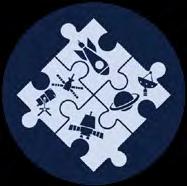
This summer in the northern hemisphere, the Peruvian team will stay again for several weeks in Boulder, this time to do the final integration of COSPAR-1 and perform all the corresponding tests, with the intention of having it ready for launch before the end of the year or in the first quarter of 2026, depending mainly on the launcher company finally chosen, for which negotiations are currently underway.
Prior to that, and as planned in the framework of the programme, in March this year we held a one-week workshop in Lima, with the presence of Professors Amal Chandran (LASP, USA) and Loren Chang (National Central University— NCU, China, Academy of Sciences located in Taipei), the main mentors in the collaboration, to corroborate what has been done so far and to define all the steps for the final integration of the satellite, tests, etc. The occasion was also used for the formal delivery to the Peruvian team of the CRP payload instrument provided by NCU for its integration in COSPAR-1, as well as for meetings with Peruvian authorities from the University and CONIDA. A public presentation of the project (with great media impact) also took place, taking advantage of our presence there.
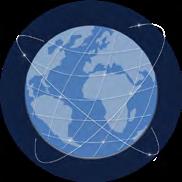
The first group selected was a team of five students from the National University of Engineering (UNI) in Lima, Peru, who participated in a Laboratory for Atmospheric and Space Physics (LASP) summer school in Boulder, Colorado, in the summer of 2024, working on the design and development of the COSPAR-1 space weather satellite, under the direction of Amal Chandran of the University of Boulder. The COSPAR-1 mission, carrying three payload instruments, a Compact Radiation Probe (CRP), an Earth Radiation Sensor (ERS) and a Solar Spectral Sensor (SSS), will focus on the study of the components of the Earth’s Radiation Budget and assess the Earth’s Energy Imbalance. It is worth mentioning that COSPAR-1 is the first element of a constellation of small satellites for Space Weather research pursued by COSPAR, through the relevant Panel on establishing a Constellation of Small Satellites (PCSS).
The Peruvian team continued its work once back in Peru under the supervision of UNI Professor Germán Comina Bellido, using as a fundamental element for the integration and testing the FlatSat from HEX-20, an Indian company actively collaborating with the project. The FlatSat was the
Our intention is for COSPAR-1 to be registered as a Peruvian satellite, which implies a series of formal and technical steps, which must be endorsed by the local authorities.
The Peruvian team, thanks to its involvement in this project, won first place in the UNI Special Formative Research Project Competition with the COSPAR-1 Ground Station project and with it its funding. The Peruvian station will be one of three or four communication stations with the satellite, together with one in India (from the company HEX-20), and another at NCU, both confirmed. A fourth could be located in Boulder at LASP.
[By Daniel Müller, ESA Solar Orbiter Project Scientist, on behalf of the Solar Orbiter Team, European Space Agency, ESTEC, The Netherlands]
The ESA/NASA Solar Orbiter mission, launched in February 2020, is exploring the Sun and heliosphere from close up and out of the ecliptic plane. Its suite of ten instruments combines in-situ measurements close to the Sun with simultaneous high-resolution imaging and spectroscopic observations of the Sun to address four interrelated toplevel science questions:
• How and where do the solar wind plasma and magnetic field originate in the corona?
• How do solar transients drive heliospheric variability?
• How do solar eruptions produce energetic particle radiation that fills the heliosphere?
• How does the solar dynamo work and drive connections between the Sun and the heliosphere?
The mission’s trajectory is highly elliptic and uses multiple gravitational swing-bys to achieve a minimum perihelion distance of 0.28 au (closer than planet Mercury’s perihelion) and to provide the first images of the Sun’s uncharted polar regions. Since the start of Solar Orbiter’s nominal mission phase in December 2021, its unique data have enabled the science community to make excellent progress on the first three questions.
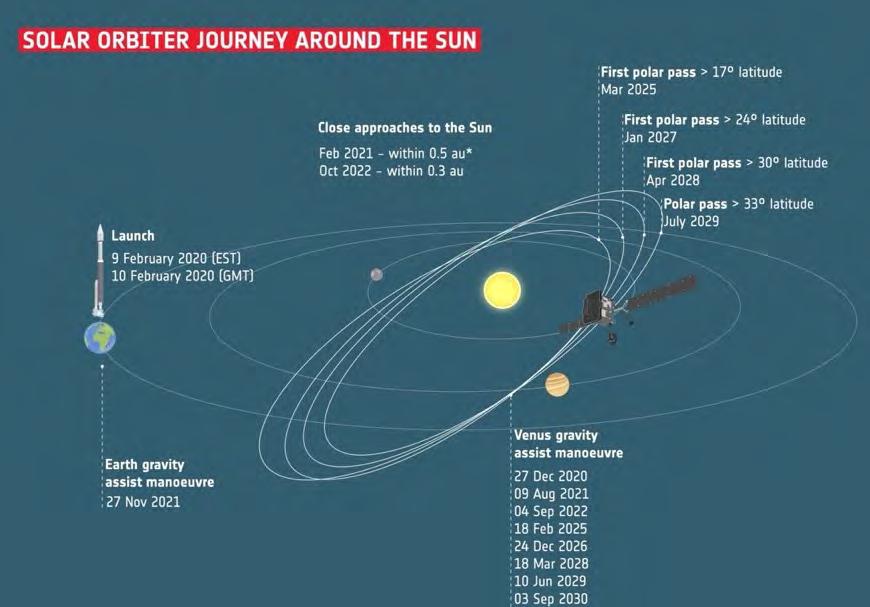
In February 2025, Venus Gravity Assist Manoeuvre (VGAM) #4 tilted the spacecraft’s orbit to reach 17° heliographic latitude in March 2025 and provided the first out-ofecliptic observations of the Sun’s south polar region. In its proposed extended mission phase, Solar Orbiter will successively increase its maximal inclination to 24°, 30°, and then 33° in June 2029 (see Figure 1 below).
Polar observations from increasing heliolatitudes will be key for tackling the final top-level question.
◀ Figure 1: Solar Orbiter’s mission milestones. Gravity assist manoeuvres are used to get the spacecraft close to the Sun and subsequently tilt its orbit out of the ecliptic plane to observe the Sun’s polar regions. (Image credit: ESA, CC BY-SA 3.0 IGO)
Solar Orbiter has been returning rich multi-instrument data sets that have already resulted in more than 500 refereed publications, a few of which are highlighted below. The Solar Orbiter Science Nuggets, short web articles covering overarching science topics, and the mission’s web pages provide more details.
How and where do the solar wind plasma and magnetic field originate in the corona?
The unparalleled spatial and temporal resolution of Solar Orbiter’s Extreme UV Imaging Telescope, EUI, coupled with data sets of the other instruments onboard, sparked new insight into the origin of the solar wind plasma in the lower corona. Observations of thousands of small-scale EUV brightenings, or ‘campfires’, were identified as smallscale magnetic reconnection events that inject energy into the Sun’s upper atmosphere.
Analysis of related ‘picoflare’ jets in a polar coronal hole showed that these can supply a significant part of the mass
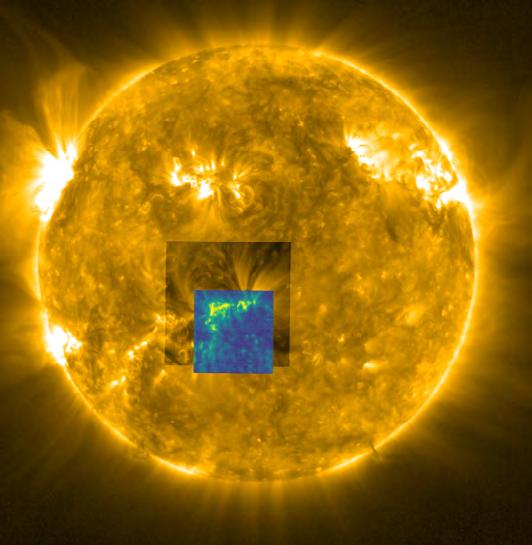
EUI
Large
and energy required to power the solar wind. A follow-up study used both in-situ and remote-sensing observations from Solar Orbiter to describe comprehensively how these picoflare jets are driving different types of solar wind–the fast wind and the Alfvénic slow wind. Solar Orbiter observations have revolutionised this particular science topic: While previous lower-resolution measurements by the SOHO mission indicated that coronal holes were the least active regions on the Sun, the new data from Solar Orbiter show that coronal holes are in fact incredibly dynamic at small scales and that this activity feeds the large-scale solar wind that can be measured close to the Sun by Solar Orbiter’s in-situ instruments.
Combined Solar Orbiter in-situ and remote measurements were also successfully used to connect the variability of solar wind features measured in the inner heliosphere to their sources in the corona (see Figure 2 below), to link the Alfvénic slow wind to its source region of the Sun, and to identify the inner corona as the place where turbulence develops in the solar wind
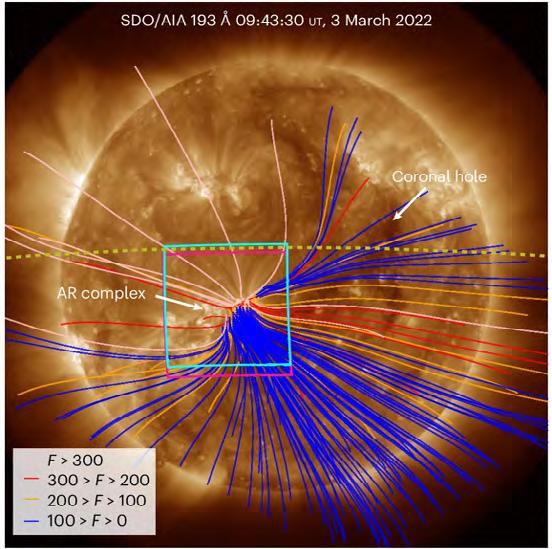
EUI
Resolution
Small inset: Rastered spectral image taken with the SPICE instrument. Right panel: SDO/AIA image showing the source region of the solar wind from the perspective of an Earth observer. Open magnetic field lines that are constructed from the coronal potential field model are overplotted, coloured by their associated expansion factor, F. The fields of view of the Solar Orbiter EUI and PHI high-resolution imagers are indicated as rectangles (from Yardley et al., Nature Astronomy 2023).
A combined analysis of Solar Orbiter and Parker Solar Probe data provided proof that Alfvén waves drive the sustained acceleration and heating of the fast solar wind after it has left the Sun. In this work, a specific alignment of the two spacecraft along a magnetic field line was used to measure the state of a ‘parcel’ of solar wind at two different distances to the Sun. Close to the Sun, the magnetic field contained ~10% of the solar wind’s total energy. At Solar Orbiter, this number had dropped to just 1% but the plasma had accelerated and had cooled more slowly than expected. From this, it could be concluded that the magnetic wave energy measured at Parker Solar Probe is required to maintain energy conservation.
How do solar transients drive heliospheric variability?
Jointly operating Solar Orbiter with other missions in the inner heliosphere has enabled multi-viewpoint observations of coronal mass ejections (CMEs). These have provided important modelling constraints on the internal structure of CMEs and improved our understanding of their propagation through the heliosphere. During
perihelion passages, Solar Orbiter is regularly able to observe the onset of CMEs with both in-situ and remotesensing instrumentation. A unique feature of Solar Orbiter is the experimental occulter mode of its EUI Full-Sun Imager (FSI) that can detect signals in the Fe IX/X 17.4 nm passband out to the edge of its field of view (7 RSun). This has paved the way for a new type of combined UV imager and coronagraph that will be flying on ESA’s upcoming space weather mission, Vigil
Solar Orbiter’s X-ray instrument STIX has been operating continuously since January 2021 and has observed more than 60,000 solar flares to date. This unique data set includes many flares that were not visible from Earth and covers the entire rising phase of Solar Cycle 25. STIX data has been providing new diagnostics of where particles are accelerated in the Sun’s atmosphere, which eventually leads to radiation or energetic particles detected in situ. Importantly, the combination of Solar Orbiter with observatories at different viewpoints has allowed revealing the 3D nature of flaring regions, including locating the source regions of energetic electrons. A novel operation mode of the EUI instrument was implemented in 2024: In addition to regular images at lower cadence, the instrument acquires short-exposure images at very high time cadence. This allows constructing high-quality, unsaturated movies of solar flares that provide key information for analysing STIX X-ray light curve data.

▲ Figure 3: Solar Orbiter’s observations of the solar flare event of 21 March 2022 highlights the complex magnetic environment in which the spacecraft operates. The flare itself took place just behind the visible face of the Sun as seen by Solar Orbiter but was observed above the limb by its Extreme Ultraviolet Imager (EUI) and the X-ray Spectrometer/Telescope (STIX). In the inset in the lower left, the X-ray flare source seen by STIX is marked as a small red dot, while the expanding coronal loops and shock front are visible in the EUI difference image. (Image credit: ESA & NASA/Solar Orbiter/EPD, EUI, RPW & STIX Teams, ESA Standard Licence).
How do solar eruptions produce energetic particle radiation that fills the heliosphere?
The launch of Solar Orbiter right at the start of Solar Cycle 25, with scientific measurements of Solar Orbiter’s in-situ payload starting already in mid-2020, have produced unique data sets of Solar Energetic Particle events (SEPs) that have provided valuable insights into energetic particles’ sources, acceleration, and transport in the interplanetary medium.
Solar energetic particle (SEP) events can fill the inner solar system with ionising radiation within hours and are therefore studied extensively. The high quality of Solar Orbiter data transformed the study of heavy ions from the Sun, e.g., by suggesting a common acceleration mechanism for 3He and Fe ions, despite their vastly different enrichment factors. Some other SEP events observed by Solar Orbiter pose new challenges for modelling, e.g. an event where the presence of an interplanetary flux rope is believed to play a role in unusually long particle propagation paths Interplanetary shocks driven by solar eruptions can be
studied at unprecedented level of detail, enabling the discovery of different particle acceleration mechanisms. A recent study investigated statistics of more than 100 shocks. In one of these events, rarely observed structures, known as shocklets, were found upstream of an interplanetary shock and measured by multiple spacecraft for the first time. Shocklets play a role in energising particles efficiently to high energies as they precondition the plasma before it encounters the shock.
The community-provided Comprehensive Solar Energetic Electron event Catalogue (CoSEE-Cat) collects solar energetic electron (SEE) events and associated solar phenomena observed by Solar Orbiter’s instruments. It contains the basic parameters for all observed SEE events, as well as information on the associated solar events and the conditions of interplanetary space near the spacecraft. Given the complexity of particle acceleration processes and the critical role of interplanetary structures in modulating particle transport, establishing comprehensive data sets for statistical analysis is key to advance our understanding of the underlying physics.
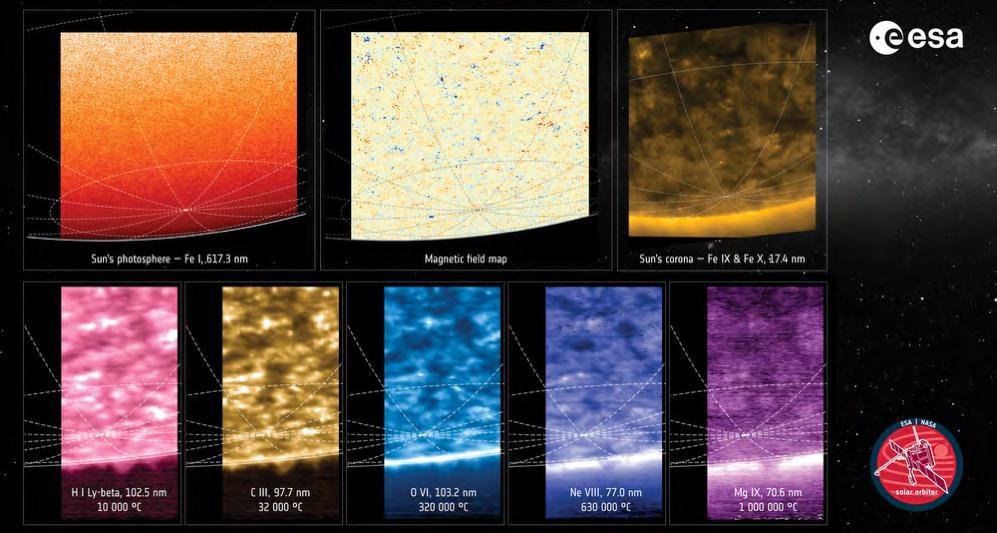
In June 2025, first images of the Sun’s south polar region were released, acquired during Solar Orbiter’s first outof-ecliptic passage in March 2025. The composite figure on the previous page shows a visible light image of the Sun’s photosphere and a magnetic field map from the PHI magnetograph, an EUI image of the EUV corona, and a series of rastered images acquired by the imaging spectrometer, SPICE, sampling different temperatures of the Sun’s atmosphere, from the chromosphere to the corona. One of the first findings from these observations is that PHI’s measurements show mixed-polarity magnetic field at the Sun’s south pole. This happens only for a short
time during each solar cycle, around solar maximum. After the flip of the Sun’s global magnetic field, a single polarity is expected to slowly build up and take over the Sun’s poles as the Sun evolves towards the next solar minimum.
Due to the Solar Orbiter’s elliptic orbit, the spacecraft’s distance to Earth increased rapidly after its first polar observations, which means that the complete data from the mission’s first full ‘pole-to-pole' scan in spring 2025 will only arrive on Earth in October 2025 and is eagerly awaited for scientific analysis.
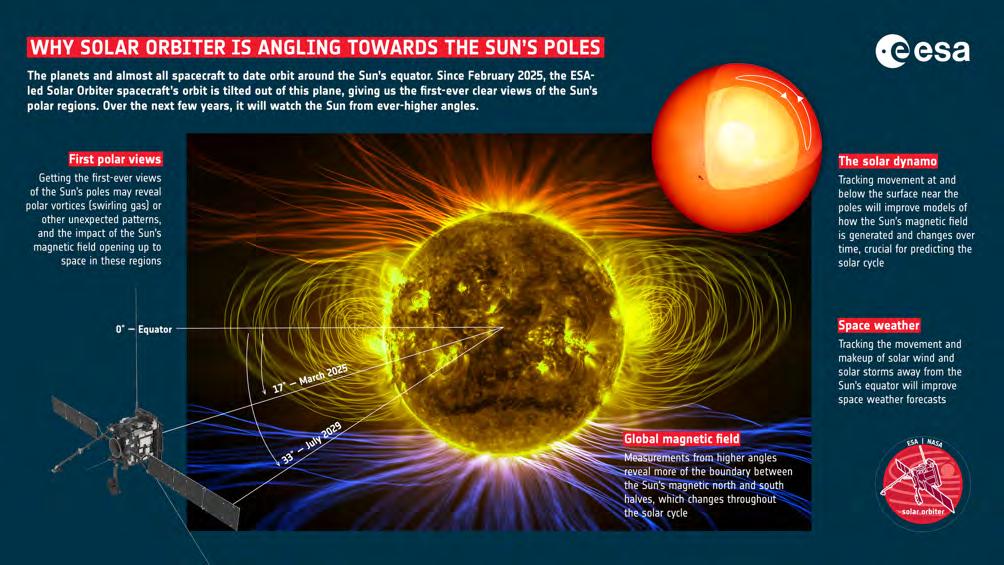
credit: ESA & NASA/Solar Orbiter, CC BY-SA 3.0 IGO)
The current orbit is just the first step of Solar Orbiter's 'stairway to heaven': In the coming years, the spacecraft will climb further out of the ecliptic plane for ever better views of the Sun's polar regions, with a maximum of 33°
heliolatitude reached in 2029. Already the edge-on views of polar coronal holes with Solar Orbiter’s EUI instrument have produced stunning scientific results. From higherlatitude viewpoints, the larger line-of-sight component
of polar outflows will enable detailed plasma diagnostics using the UV imaging spectrometer, SPICE, while EUI and PHI will be able to observe small-scale polar jets and the corresponding surface magnetic field in great detail. In addition, the in situ instruments will characterise the solar wind comprehensively at varying distances and heliographic latitudes, watching the global solar and heliospheric magnetic field and solar wind evolve towards solar minimum.
The fourth top-level science question will be a focal point of the proposed extended mission phase: How does the
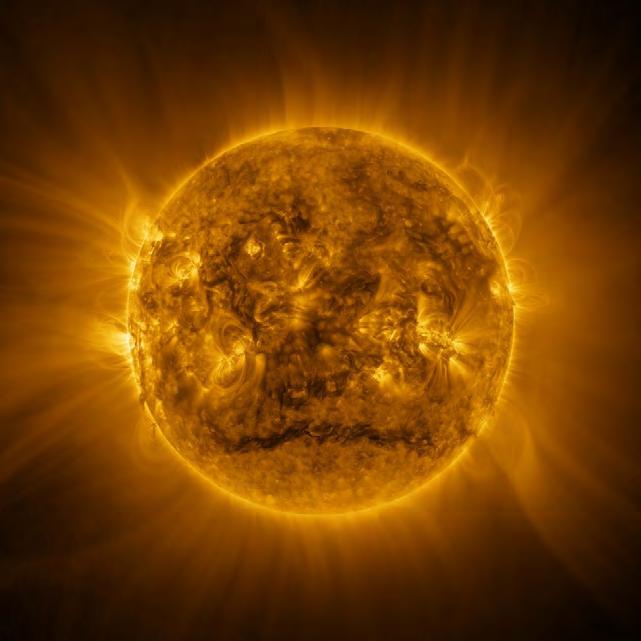
solar dynamo work and drive connections between the Sun and the heliosphere? The Sun’s magnetic field plays a dominant role in the solar atmosphere. On the global scale, the most evident manifestation of its magnetism is the Sun’s 11-year activity cycle. Similar activity cycles are also observed in other stars, so solar observations are not only required to understand how the Sun’s dynamo generates its magnetic field, but are also crucial importance to validate dynamo models of stellar activity. So far, however, dynamo models have often failed to predict actual solar behaviour on a global scale. For example, the 2009 sunspot minimum was significantly lower in solar activity and extended for a longer time than predicted by any model, and solar activity leading up to the current solar maximum has been significantly higher than predicted. This indicates that existing models are still missing key elements, which presents a unique science opportunity for Solar Orbiter.
Solar Orbiter’s polar magnetic field measurements will also inform better global heliospheric models, which will improve future space weather applications. In summary, Solar Orbiter’s data will further advance our understanding of the Sun’s magnetic field, the solar wind, and solar activity.
◀ Solar Orbiter’s widest high-resolution view of the Sun. On 9 March 2025, the Extreme UV Imager (EUI) acquired a 157-megapixel mosaic image of the Sun in the Fe IX/X 17.4 nm passband, composed of 200 individual images of its High Resolution Imager (HRI), plus additional images of its Full Sun Imager (FSI).
(Image credit: ESA & NASA/Solar Orbiter/EUI Team, E. Kraaikamp (ROB), CC BY-SA 3.0 IGO)
Daniel Müller is the Project Scientist of the ESA-NASA Solar Orbiter Mission, and senior staff scientist at ESA’s European Space Research and Technology Centre (ESTEC) in the Netherlands. He holds a Ph.D. in Physics from the University of Freiburg, Germany. After a Marie Curie Fellowship at the University of Oslo, Norway, he joined ESA’s SOHO team at NASA’s Goddard Space Flight Center, where he became Deputy Project Scientist of the ESA-NASA SOHO mission.
In 2010, he moved to ESTEC to start working on Solar Orbiter, and has been serving as the mission’s Project Scientist since 2012.
Since 2023, he is also ESA Project Scientist for SOHO. In addition to his scientific and project management work he has a strong interest in high-performance scientific data visualisation. In particular, he is coordinating the development of the open-source software JHelioviewer and is the ESA Lead of the ESA-NASA Helioviewer Project.
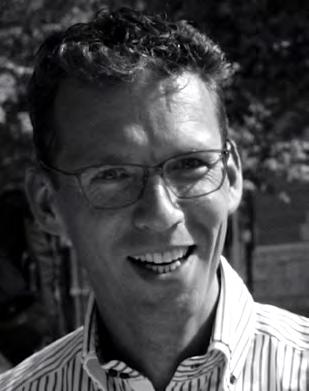
[By Michel R. Lapointe (Laurentian
University, ON, Canada, Northern Ontario School of Medicine University—NOSM University, Canada), Taylor Laframboise (NOSM University, Canada), Christopher Thome (NOSM University, Canada), and Douglas Boreham (NOSM University, Canada)
Ionizing radiation is a defining feature of the deepspace environment. As space agencies worldwide prepare for sustained human presence beyond low Earth orbit (LEO), understanding how biological systems respond to space radiation is a central concern. Life on Earth has evolved in an environment where ionizing radiation is ubiquitous at low levels, albeit with a vastly different particle spectrum than that present in deep
All life on Earth has evolved in the presence of background ionizing radiation. Estimates suggest that when life first emerged on Earth, background radiation dose rates may have been up to five times higher than they are today [1] The long-term reduction in environmental radiation is primarily due to the decay of the primordial radioisotope, potassium-40, which has a half-life of 1.25 billion years
space. As such, it is essential to quantify the biological impacts of perturbations in background radiation levels. The Researching the Effects of the Presence and Absence of Ionizing Radiation (REPAIR) project, located at SNOLAB in Sudbury, Ontario, Canada, offers a unique approach to this problem: studying the biological consequences of almost entirely shielding from naturally occurring ionizing radiation.
and decays via beta emission. As a result of sustained evolution in this low-dose-rate radiation field, all organisms have retained highly conserved molecular pathways for detecting and repairing radiation-induced damage. This evolutionary context raises the key question: What role does ionizing radiation play in cellular homeostasis?
To probe these questions, the REPAIR project has worked with desiccated/ anhydrobiotic (living without water) yeast Saccharomyces cerevisiae, implementing experimental techniques pioneered for NASA's Ames Research Center's
BioSentinel mission. Deployed aboard the Artemis I mission, BioSentinel aimed to investigate the biological effects of prolonged deep space radiation exposure [2]. In its dry state, S. cerevisiae halts metabolic activity, allowing it
to accumulate radiation-induced cellular damage without initiating repair processes until rehydrated. This makes it an ideal "living dosimeter," capable of recording biological damage that can be later measured as a functional outcome, such as reproductive fitness, metabolic rates or survival. S. cerevisiae is particularly well-suited for this type of work: its genome is fully sequenced, its DNA repair pathways are well characterized, and it shares key cellular features surrounding the DNA damage response with higher eukaryotes, including humans.
Located two kilometers (6,800 ft) beneath the Earth's surface, SNOLAB is the world's deepest cleanroom laboratory [3]. The rock overburden, equivalent to over 6 kilometers of water shielding, effectively reduces the cosmic muon flux by a factor of over 50 million. It was initially developed for solar neutrino detection, where exceedingly rare events must be distinguished from a constant background of cosmic rays and radioactive decay. In its current state, the laboratory hosts a diverse
range of low-background experiments with interests in supernova neutrino detection, dark matter detection, and rare-event detection, including neutrinoless double-beta decay and many other areas of research. This low radiation environment provides an unprecedented opportunity to examine the effects of the absence of ionizing radiation on biology, an opportunity the REPAIR project is taking full advantage of.
The anhydrobiotic yeast model is just one component of the REPAIR program, which has also conducted studies utilizing Lake whitefish embryos (Coregonus clupeaformis) [4] and human cell culture [5]. Across these models, observations have been made which are in line with similar low-background radiation studies, including reduced
growth rates and reproductive fitness, increased baseline genomic instability, impaired antioxidant defences, and increased susceptibility to subsequent stressors, such as acute high-dose radiation exposure or radiomimetic chemical exposure.
In works published in 2023, the REPAIR project stored desiccated yeast for up to 48 weeks within the subbackground environment at SNOLAB, along with matched surface-level controls [6]. The results to date have remarkable implications: yeast stored in the low-radiation SNOLAB environment exhibit reduced reproductive fitness and lower survival upon rehydration compared to surface-stored counterparts. This suggests that radiation, typically thought of as solely damaging,
may play a role in maintaining specific cellular homeostatic mechanisms or stress-response pathways, even during anhydrobiosis.
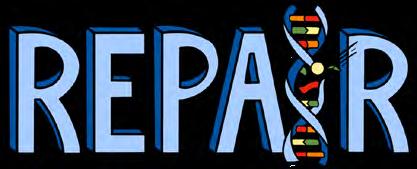
Building on these results, the REPAIR project is spearheading a large-scale, multi-facility collaboration with up to eight other deep-underground laboratories (DUL) around the world. Desiccated yeast samples will be stored in each DUL for one year, with sample collection occurring every four months. This collaboration aims to replicate the previous results with desiccated yeast at multiple sites and incorporate novel biological assays, including multi-omics analysis, to further elucidate the role of NBR in normal biological function.
▲ Researching the effects of the presence and absence of ionizing radiation (REPAIR) project logo.

▲ Panoramic view of the REPAIR facilities located 2km underground within the Life Sciences Lab at SNOLAB in Sudbury, Ontario, Canada.

▲ Representative micrographs of rehydrating yeast growing and reducing resazurin (blue) to resorufin (pink) as a metabolic indicator. One of several assays implemented with the desiccated yeast model which has shown that metabolic rates are significantly decreased with prolonged sub-natural background radiation exposure.
Our results underscore the value of ultra-low-radiation environments not just for fundamental physics but also for biology and radiation research. As we seek to safeguard astronauts during long-duration missions and develop platforms for future exploration, understanding both the damaging and regulatory roles of radiation is essential.
[1] Karam, P.A. and S.A. Leslie, Changes in terrestrial natural radiation levels over the history of life, in Radioactivity in the Environment. 2005, Elsevier, p. 107-117.
[2] Santa Maria, S.R., et al., BioSentinel: Long-Term Saccharomyces cerevisiae Preservation for a Deep Space Biosensor Mission. Astrobiology, 2020. 20(8): p. 1-14.
[3] Smith, N.J.T., The SNOLAB deep underground facility, Eur Phys J Plus, 2012. 127(108).
[4] Pirkkanen, J., et al., A research environment 2 km deep-underground impacts embryonic development in lake whitefish (Coregonus clupeaformis), Frontiers in Earth Science, 2020. 8(327): p. 1-9.
[5] Pirkkanen, J., et al., The role of natural background radiation in maintaining genomic stability in the CGL1 human hybrid model system. Radiation Research, 2024. 202(4): p. 617-625.
[6] Lapointe, M.R., et al., Protracted exposure to a sub-background radiation environment negatively impacts the anhydrobiotic recovery of desiccated yeast sentinels., Health Physics, 2024. 126(6): p. 397-404.
Douglas Boreham received his PhD from the University of Ottawa in 1990. Dr. Boreham is currently a professor at the Northern Ontario School of Medicine University (NOSM U) and is Division Head for the Medical Sciences Division. He is a recognized leader in the areas of low dose radiation effects in medicine and health, and radioprotection of ahumans and the environment. He was selected as an expert Canadian delegate for the United Nations Scientific Committee on the Effects of Atomic Radiation (UNSCEAR) in 2012. He has supervised numerous graduate students and Postdoctoral Fellows and has over 160 peer-reviewed scientific publications. He is a board member of the Radiation Research Foundation and the 2024-2025 President of the Radiation Research Society.
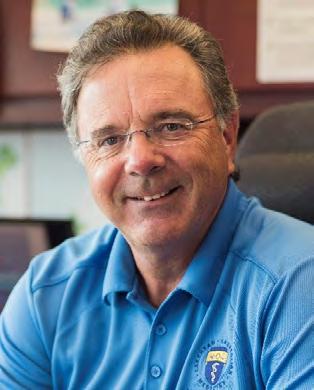
Christopher Thome is a radiation biologist who studies the cellular and molecular responses to low dose ionizing radiation exposure, including human-made and natural sources. He is an Associate Professor at NOSM University and is one of the lead scientists on the REPAIR project studying sub-natural background radiation exposure at SNOLAB.
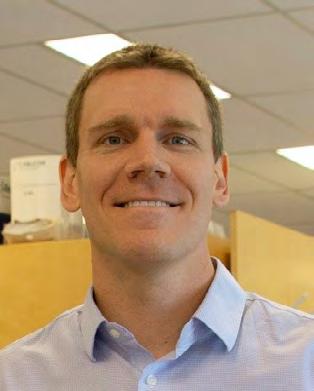
Michel R. Lapointe is a postdoctoral fellow at Laurentian University and a stipendiary assistant professor at NOSM University in Sudbury, Ontario, Canada. His research is primarily concerned with studying the biological effects of sub-natural background ionizing radiation exposure with the REPAIR project at SNOLAB in Sudbury, Ontario, Canada.

Taylor Laframboise is a laboratory technician at NOSM University in Sudbury, ON, Canada. He is tasked with coordinating the REPAIR project at SNOLAB, where he has handled experiments implementing a variety of biological models, including Lake Whitefish embryos, human tissue cultures, nematodes, and yeast, with a focus on the effects of sub-natural background radiation exposure.
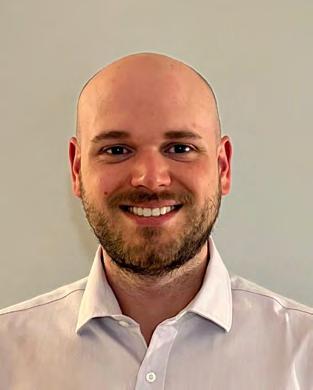
Editor’s Note: Our intrepid Associate Editor Lia Laiakis spared no effort in helping us track down the Research Highlight on the REPAIR project, and here she shares her personal experience of the SNOLAB site.
On a cold day in March, my friend and guide Dr. Mike Lapointe picked me up from my hotel at exactly 5:50 am for a much anticipated and thoroughly planned visit to SNOLAB. We arrived at Vale’s Creighton nickel mine and soon realized that this was not a simple visit to a science lab. Dressed as a miner with the required lifesaving gear needed in case of an emergency, we took our turn waiting for the cage to take us 2 km below the surface of the Earth. “If you feel like fainting, tell someone so they can catch you” said Mike. “Wait, what?”
Well, it became quickly obvious that this was no ordinary “elevator” ride, descending at an extraordinary speed in the dark, only to get more exciting from there. After a
~1.5 km walk through the drift, we arrived at SNOLAB, a scientific marvel.
SNOLAB is the world’s deepest operational clean room facility, so we had to change out of our mining gear, take showers, and change into clean clothes. There are really no words to fully describe how amazing this lab is, with its winding tunnels, vast excavated rooms housing neutrino and dark matter physics experiments, and of course a fully functional biology lab, where investigators are trying to understand biology in the absence of background cosmic radiation. Just thinking about how they built this facility leaves you in awe! After a two-hour tour, and multiple pictures, we put our “dirty” clothes back on and started the hike to catch the cage to the surface. I must confess, the ride up was much more enjoyable as I knew what to expect. With full excitement on my face, amazement from the scientific jewel I had the honor of visiting, and a new appreciation for the extreme efforts students go through to complete their projects, I turned to Mike and said: “Let’s do that again!”
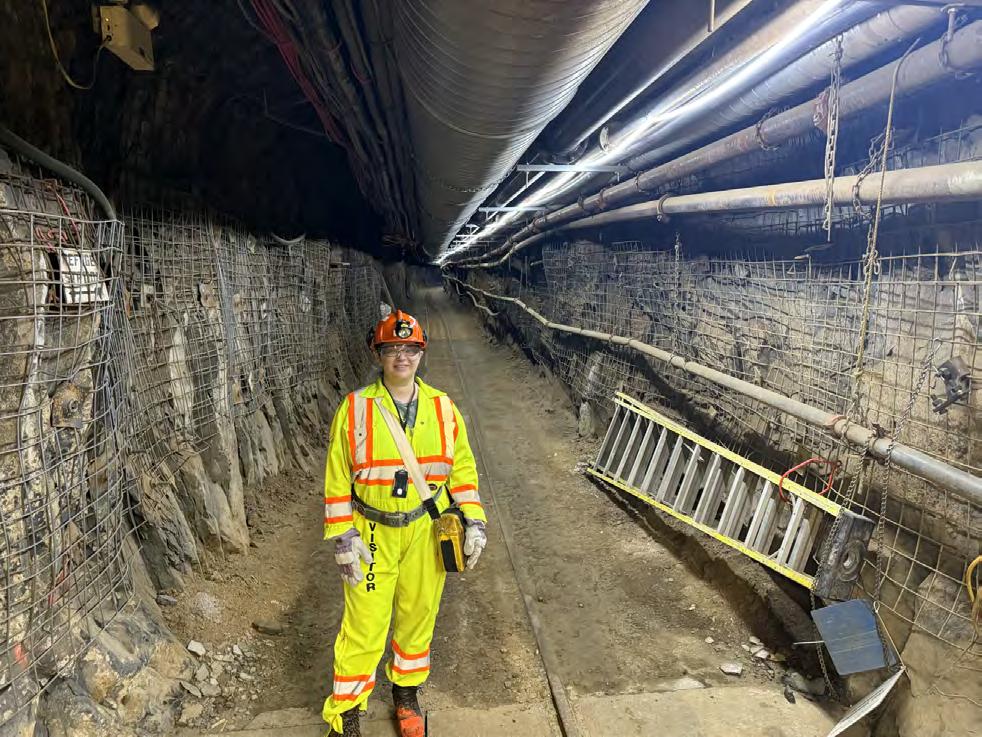
[By Giorgio Petroni, Istituto Nazionale di Astro Fisica (INAF), Milano, Italy, and Alberto Petroni, Università di Parma, Italy]
Within the rapidly evolving domain of the Space Economy—which has experienced significant acceleration over the past two decades—a group of space agencies has emerged as particularly dynamic in expanding their national space activities. This advancement can be largely attributed to both
technological innovations and strategic advancements in organizational and managerial frameworks. This article presents and analyzes four highly illustrative case studies: the space agencies of Canada, Luxembourg, Singapore, and South Korea.
Over the past two decades, the Space Economy has shifted into high gear, marking a dramatic transition from a historically geopolitical and defence-driven domain to one increasingly fueled by technological and organizational innovation. While the Cold War era was dominated by US–Soviet rivalry, the post-Berlin Wall period unlocked new channels for knowledge exchange and international cooperation—laying the groundwork for today’s commercial and strategic space surge.
The turning point came with the rapid maturation of satellite technologies. Enhanced Earth observation capabilities catalyzed a demand boom across sectors like telecommunications, environmental monitoring, disaster response, precision agriculture, and logistics. The market response was immediate: by the end of 2024, the number of national space agencies had soared to over 80, some of which are now reshaping the global space landscape beyond their national borders.
Canada (CSA), Luxembourg (LSA), South Korea (KASA), and Singapore (SSTL/OSTIN) have demonstrated a distinct and powerful blend of technological excellence and
institutional innovation. Their trajectories reflect not only strategic governmental support but also a systemic ability to develop space ecosystems aligned with economic and societal goals.
From Canada’s internationally recognized robotics and Earth observation technologies, to Luxembourg’s positioning as a European financial hub for NewSpace ventures; from South Korea’s ambitious investment in launch vehicles and space clusters, to Singapore’s agile hybrid model of public-private governance—these cases illustrate what happens when space policy goes beyond R&D to embrace entrepreneurship, global collaboration, and dual-use capabilities.
Data for this study have been compiled through a combination of literature review, official agency reports, financial statements, and interviews with senior space agency officials.
The Canadian Space Agency (CSA), established in 1989 and operational since 1990, functions under the Ministry of Innovation, Science and Economic Development. With a staff of 570 and a 2022–2023 budget of Can$1.4 billion, CSA reflects Canada’s ambition to align space activities with national economic and societal development. Its structure is reinforced by a Strategic Advisory Board, ensuring strong coordination between scientific goals and policy priorities.
In 2022, the space sector generated Can$5 billion in revenues, contributing Can$3.2 billion to the national GDP, with a workforce of 12,624 direct employees and around 13,000 additional jobs supported in adjacent sectors. While the number of space start-ups has increased significantly, the top 30 firms still account for over 90% of revenues and two-thirds of employment.
CSA is strongly engaged in international cooperation, holding associate membership in ESA and close ties with NASA, JAXA, and DLR. It contributes to the ISS program and regularly collaborates in major exploration missions. These partnerships provide access to frontier knowledge and enhance Canada’s visibility in the global space community.
Technologically, CSA has delivered a number of standout innovations. These include the MOST telescope for stellar variability studies, the Canadarm series of robotic arms used in ISS and Shuttle missions (with Canadarm3 planned for the Lunar Gateway), and the LEAR rover, designed for
lunar polar exploration. The OLA system, used in NASA’s OSIRIS-REx mission, provided detailed 3D mapping of asteroid Bennu.
CSA’s research ecosystem is anchored by the David Florida Laboratory (Ottawa) and the Chapman Space Centre (Québec). The agency collaborates with top universities and SMEs, the latter responsible for 85% of space-related patents and a significant share of R&D investment. A dedicated STEM Initiative also supports young entrepreneurs with grants up to Can$50,000, while around 100 graduates and PhD students are hosted each year for hands-on research training.
In parallel, CSA leads advanced Earth observation efforts with the RADARSAT Constellation, launched in 2019. This three-satellite SAR system provides continuous, highresolution imaging for civil protection, environmental monitoring, agriculture, and maritime surveillance. The system’s design includes local stakeholder input, ensuring responsiveness to regional needs across Canada’s vast 10 million km² territory.
In sum, CSA offers a model of strategic integration, combining scientific excellence with industrial relevance. Its strong links with academia, dynamic SME sector, youthfocused innovation programs, and advanced observational infrastructure position Canada as a key contributor to the global space economy—agile, cooperative, and future-ready.
Established in 2018 under the Ministry of the Economy, the Luxembourg Space Agency (LSA) marks the institutional consolidation of a strategic national journey that began in the late 1970s. Originally a supporter of ESA’s satellite communication initiatives, Luxembourg progressively transitioned from a steel- and agriculture-based economy toward a highly specialized financial and technological services hub. This evolution led to the creation of SES (Société Européenne des Satellites), now a global leader
in satellite communications, and laid the groundwork for the country’s growing role in space.
Today, Luxembourg hosts over 70 space companies employing 1,400 people. The sector contributes 2% of national GDP, with government plans to double this share to 4% by 2027. LSA acts as the public driver of this ecosystem, promoting investment in both emerging and established space ventures. Its development model is
powered by an informal “decision-making unit” composed of LSA, ESRIC (the European Space Resources Innovation Centre, founded with ESA and the Luxembourg Institute of Science and Technology - LIST), and the national financial institutions, providing a seamless pipeline from project ideation to funding and execution.
LSA’s strategic mission is twofold: expand the space services industry, especially satellite communications, and prepare for the future utilization of off-Earth resources such as rare metals potentially found on the Moon and in asteroids. In pursuit of this vision, Luxembourg has signed Memoranda of Understanding with NASA and ESA. These agreements support cooperation on commercial opportunities emerging from the Artemis lunar program and set the legal and economic framework for in-situ resource utilization (ISRU). Through these accords, LSA also pledges to ensure compliance among Luxembourgbased companies operating in space resource extraction. While the country lacked an entrenched aerospace tradition, Luxembourg’s political leadership leveraged international opportunities and partnerships to build a space economy rooted in financial innovation and regulatory foresight. ESA’s early telecom programs, especially ECS/Eutelsat, offered the entry point.
From there, the government worked closely with ESA to establish funding frameworks that today support both startups and scale-ups in the space industry.
LSA’s dual strategy centres on enabling access to capital for space ventures and positioning the country as a leader in the legal and technological infrastructure for space mining. The first pillar has already seen significant success, benefiting from Luxembourg’s global standing in finance. The second is still nascent, as legal norms for space resources remain under development. Nevertheless, LSA has aligned itself with international missions such as Artemis and committed to sending a Luxembourg astronaut to participate in building the Lunar Gateway. The agency also collaborates with companies like ISPACE, Deep Space Industries, and Planetary Resources, all of which are exploring technologies for asteroid and lunar extraction.
In essence, Luxembourg’s model demonstrates how a small state can assume a significant role in the global space economy through targeted regulation, strategic alliances, and financial leverage. LSA’s success reflects a convergence of smart governance, global connectivity, and a proactive stance on the commercial opportunities of space beyond Earth orbit.
Established in May 2024, the Korean Aerospace Administration (KASA) represents a structural evolution in South Korea’s space governance. Reporting to the Ministry of Science and ICT, KASA was created to centralize the strategic and commercial direction of space activities, distinguishing it from earlier research-driven institutions such as KARI and KASI. With a staff of 293 and a 2025 budget of $724 million (up from $532 million in 2024), KASA is the operational cornerstone of a national ambition: positioning South Korea among the world’s top five space powers by 2045.
The agency is the institutional answer to South Korea’s rapidly expanding space sector, which has seen continuous investment since 2000 and now employs approximately 11,000 professionals across dozens of companies. Former President Yoon Suk Yeol viewed space as a strategic
economic engine and laid out bold targets: reaching 10% of the global space market by 2045, creating 250,000 new jobs, and launching ten globally competitive space firms. The roadmap includes participation in high-profile missions such as NASA’s Artemis and a proposed human Mars landing by 2045.
South Korea’s space trajectory has been marked by strong capabilities in satellite design and manufacturing. Since 1999, the country has launched 13 satellites, including Earth observation (KOMPSAT), meteorological, and lunar probes. In 2022, the Danuri mission placed South Korea’s first satellite in lunar orbit, laying the foundation for future exploration and communications with the Moon. A constellation of GNSS satellites is also planned to establish autonomous positioning infrastructure, reducing reliance on foreign systems.
Equally ambitious is Korea’s development of launch vehicle technology. Starting with sounding rockets in the 1990s, KARI progressed to the KSLV-I (NARO-1) and, more recently, to the advanced KSLV-II (NURI). Capable of placing 1.5-ton payloads into low Earth orbit, NURI marked a turning point for domestic launcher autonomy. A next-generation vehicle, KSLV-III, is under development to support future lunar missions in partnership with NASA. KASA also champions a space cluster strategy, introduced in 2022 and formalized in the 2024 “Space Cluster Plan.” The aim is to develop regional industrial hubs that integrate R&D, manufacturing, and entrepreneurship. These clusters, supported by public-private partnerships, are envisioned not just as industrial nodes, but as training grounds for future space entrepreneurs. A new feasibility study for a national spaceport is also underway, signaling Korea’s intention to consolidate vertical capabilities.
Recognizing the limits of national scale, South Korea has embraced international collaboration as a pathway to rapid technological advancement. The country has built alliances with NASA, ESA, and JAXA, leveraging knowledge exchanges and informal tech transfer. Notably, Korea partnered with JAXA on the SLIM lunar lander, part of the Artemis program, underscoring its readiness to contribute to global missions while accelerating its own learning curve.
South Korea’s space policy is thus defined by its focus on launch vehicle mastery, deep technological integration, and the creation of regionally embedded innovation ecosystems. KASA’s establishment reflects a deliberate national pivot—where space is no longer a research outpost, but a central pillar of industrial competitiveness and geopolitical presence.
Singapore’s space sector follows an unconventional trajectory, marked by a hybrid governance model that combines public strategy with private entrepreneurial drive. Founded in 2007, Singapore Space & Technology Ltd. (SSTL) is a private entity operating in the public interest. Its core mission is to drive national economic development by promoting the industrial application of space technologies. SSTL’s governance structure includes an international advisory board made up of scientists, entrepreneurs, financial experts, and defense officials, reflecting the sector’s inherently dual-use potential.
In 2013, the government established OSTIn (Office for Space Technology and Industry) under the Economic Development Board, creating a public-private framework unique in the global space landscape. SSTL focuses on outreach, talent development, and international partnerships, while OSTIn oversees public investment strategy, program planning, and the regulatory environment. This synergy ensures both agility and institutional oversight, facilitating growth across research, industry, and diplomacy.
By the end of 2023, Singapore was home to 70 spacerelated companies spread across the value chain. These
firms gained global recognition for their expertise in small satellite development, enabled by close collaborations with National University of Singapore (NUS) and Nanyang Technological University (NTU), which operates a dedicated research center in this domain. With university support, local firms have advanced in SAR imaging, satellite miniaturization, and intersatellite communication. Emerging technologies under development include lowEarth hyperspectral platforms and quantum cryptography for secure satellite communication.
Singapore’s space strategy is underpinned by its ambition to become a global space technology and innovation hub. This is pursued through two primary channels. First, SSTL promotes startup incubation, talent recruitment, and venture acceleration—its Cyclotron Program supports the development of deep tech applications, including dual-use technologies. As of 2024, SSTL was actively incubating 30 new space companies. Second, Singapore has cultivated deep international partnerships, which have both strategic and reputational benefits.
Notable collaborations include a 2022 agreement with NASA related to the Artemis lunar program, and longstanding cooperation with JAXA, especially through the
KIBO-ISS project and the Asia-Pacific Regional Space Agency Forum (APRSAF), which Singapore hosted in 2011 and 2018. The country also organizes the annual Global Space Convention, hosts a number of UN-related roles— including participation in COPUOS and the UNFCCC’s climate and space policy tracks—and is recognized as a trusted international interlocutor in space governance.
Singapore’s rise as a space innovation hub is grounded in three core decisions: the creation of a dual institutional model (OSTIn and SSTL) enabling both strategic direction and private-sector dynamism; the mobilization of top-tier
universities for research and technology transfer; and the cultivation of a robust international engagement strategy that integrates knowledge sharing, standard setting, and joint exploration.
Despite its small geographic size and limited natural resources, Singapore has crafted a resilient and scalable space ecosystem, blending industrial pragmatism with geopolitical foresight. Its case demonstrates how focused governance, entrepreneurial initiative, and international cooperation can converge to build a high-impact presence in the global space economy.
The cases examined in this article confirm that the Space Economy is no longer the exclusive domain of major powers. Countries of modest geographic or demographic size—such as Canada, Luxembourg, South Korea, and Singapore—have demonstrated that visionary leadership, combined with strategic public policy and targeted technological investment, can unlock significant national value in the space domain.
These nations have successfully capitalized on the synergy between technological advancement and economic development. The innovations they have introduced— both technological and organizational—have not only reinforced their domestic economies, but in some instances, transformed them. Space has become a fertile ground for the emergence of new industries, particularly in satellite services, telecommunications, robotics, and
Earth observation.
However, alongside this momentum lies a critical caveat. While these success stories often carry an optimistic tone, they risk overlooking a structural vulnerability that remains underestimated even by scholars: the absence of comprehensive international regulation. Without a clear and enforceable legal framework, the very sustainability of space activity may be jeopardized—especially by rising threats such as space debris and resource-related disputes.
To ensure that space remains a shared and viable frontier, the growing diversity of space actors must be matched by a robust multilateral governance architecture. The challenge ahead is not only to scale innovation, but to do so responsibly, through cooperative frameworks that protect orbital environments and ensure equitable access to the benefits of space.
▶ References on the next page
APRSAF (2023). 29th Meetings Announcement Link here
Bradley, J. (2024). Why Did South Korea Create a New Space Agency?. Center for Strategic and International Studies. Link here
Canadian Space Agency (2023). State of the Canadian Space Sector Report. Link here
Canadian Space Agency (2020). Canadarm2, the Canadian Robotic Arm on the Space Station. Link here
Choi, J. (2024). South Korea Joins NASA’s Artemis Project for Manned Lunar Exploration. Business Korea. Link here
CSA (2021). STEM Initiative – Opportunities for Students. Link here
ESA (2002). ECS-4: Conclusion to a Success Story. Link here
German Aerospace Center (2024). DLR, JAXA and CSA Extend Cooperation on HR. Link here
Goh, D. (2020). Singapore’s Defence Investment Arm Partners with SSTL on Project Cyclotron. Government of Canada (2023). Canadian Space Industry Overview. Link here Government of Canada (2020). Radarsat Constellation Mission. Link here
Hardy, M. (2019). Luxembourg’s Bold Plan to Mine Asteroids. Wired. Link here
Invest Korea (2024). KASA to Inaugurate Private Space Era via Tech Transfers. Link here
KARI (2023). Korea’s Cutting-Edge Earth Observation Satellites.
Kim, S. (2024). With New Space Cluster, Yoon Vows Bold Space Expansion. Korea JoongAng Daily. Link here
Lee, S. & Shin, S. (2024). Evolution of South Korea’s Space Industry. IFRI Asia Visions, No. 137. Link here
Lee, J. P. & Wong, M. T. (2019). Public–Private Partnerships in Singapore’s Space Industry. Space Policy. LIST (2024). ESA–Luxembourg Extend Space Resources Collaboration. Link here
Luxembourg Government (2019). NASA and LSA Deepen Space Cooperation. Link here
Luxembourg National Research Fund (2018). Luxembourg Launches Business-Focused National Space Agency. Link here
Luxembourg Space Agency (2022). 2023–2027 National Space Strategy: Focus on Sustainability. Link here
Luxembourg Space Agency (2019). NASA and LSA Deepen US–Luxembourg Cooperation. Link here
Media Note (2022). Republic of Singapore Signs the Artemis Accords. Link here
Mulia, K. (2020). Singapore Leading Southeast Asia’s Space Tech Industry. SSTA. Nanyang Technological University (2024). Final Test Model of Singapore’s Latest Satellite. Link here
News Focus (2024). Phase 2 of Lunar Rover Mission to Begin by 2032. Link here
Nguyen, T. M. & Chia, W. Y. (2020). Technological Advancements and Policy in Singapore’s Space Sector. Int. Journal of Space Science and Engineering.
Office for Space Technology & Industry (2019). Our History. Link here
Office for Space Technology & Industry (2025). Singapore’s Space Sector: Next Bound of Development. Link here
Tan, H. L. & Lim, S. K. (2021). Singapore’s Emerging Space Economy: Innovation and Strategy. Journal of Space Policy and Economics.
United Nations (1967). Treaties and Principles on Outer Space. Link here.
Whalen, D. J. (2002). The Origins of Satellite Communications, 1945–1965. Smithsonian Scholarly Press. Link here.
Wu, V. (2023). Korea’s GPS Satellite Program Expands Aerospace Ambitions. Digitimes Asia. Link here.
Yadav, V. & Agarwal, D. (2020). Analysis of Quantum Cryptography for Secure Satellite Communication. International Journal of Scientific & Technology Research, Vol. 9(5). Link here.
Giorgio Petroni is an Italian expert in organizational management and technology transfer within the space sector. He serves as an Associate Member of the Italian National Institute of Astrophysics (INAF) at the Institute for Space Astrophysics and Cosmic Physics (IASF) in Milan. Throughout his career, he has held significant roles in both industry and academia. He has worked with large companies in the chemical sectors and served as Assistant to the President of the Italian National Agency for Research on Renewable Energy (ENEA).
Additionally, he was a board member of the Italian Space Agency (ASI).
In academia, he has been a Full Professor at the Department of Production and Economics of Engineering at the University of Padua, Italy. He also served as Rector at the University of San Marino. He holds an honorary degree in Economics of Industrial Engineering from the Politehnica University of Bucharest, Romania.
He also co-edited the book "The Space Economy: From Science to Market" which addresses key issues in the space economy, focusing on the tangible returns of investments made in the space industry since the Space Race.
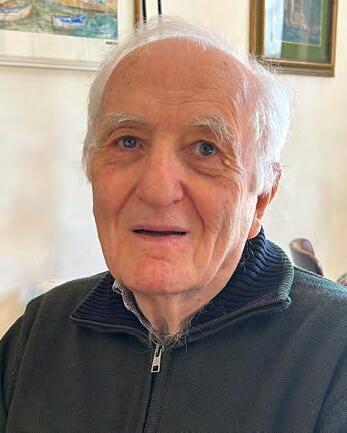
Alberto Petroni is an Italian academic specializing in industrial and managerial engineering, with a particular focus on industrial innovation. He is currently a Full Professor at the Department of Engineering of Industrial Systems and Technologies at the University of Parma. Professor Petroni earned a PhD in Science of Industrial Innovation from the University of Padua, Italy.
His primary research interests include innovation financing and technology transfer.
Professor Petroni is also a member of the Future Technology Lab (FTLAB) at the University of Parma, Italy, an interdisciplinary research centre focused on future technologies.
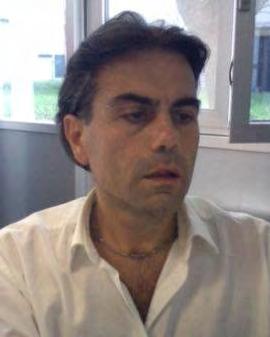
In June ESA revealed the first stunning images from its groundbreaking Biomass satellite mission (see Space Snapshot on page 62). But these inaugural glimpses go beyond forests. Remarkably, the satellite is already showing potential to unlock new insights into some of Earth’s most extreme environments.
Biomass – an Earth Explorer research mission developed within ESA’s FutureEO programme – was launched less than two months ago. This new mission is, therefore, still in the process of being commissioned, but its first set of images are stunning none the less.
ESA’s Biomass Project Manager, Michael Fehringer, commented, “As is routine, we’re still in the commissioning phase, fine-tuning the satellite to ensure it delivers the highest quality data for scientists to accurately determine how much carbon is stored in the world’s forests.
“Biomass is equipped with novel space technology, so we’ve been closely monitoring its performance in orbit, and we’re very pleased to report that everything is functioning smoothly and its first images are nothing short of spectacular – and they’re only a mere glimpse of what is still to come.”
Biomass is the first satellite to carry a P-band synthetic aperture radar, its signal capable of penetrating forest canopies to measure woody biomass – trunks, branches and stems. These measurements serve as a proxy for carbon storage, the assessment of which is the mission’s primary objective.
While it settles into its life in orbit, ESA’s pioneering Biomass mission is already returning data. The satellite, its instrument and systems are still being calibrated so these first data cannot yet be used to quantify carbon or support scientific advances, but they do show that Biomass is well on track to achieving its goals.
ESA’s Director of Earth Observation Programmes, Simonetta Cheli, said, “Looking at these first images, it’s clear to see
that our Earth Explorer Biomass satellite is set to deliver on its promise. We fully expect that this new mission will provide a groundbreaking leap in our ability to understand Earth's forests – combining cutting-edge radar technology with the scientific excellence that will unlock vital insights into carbon storage, climate change, and the health of our planet’s precious forest ecosystems.”
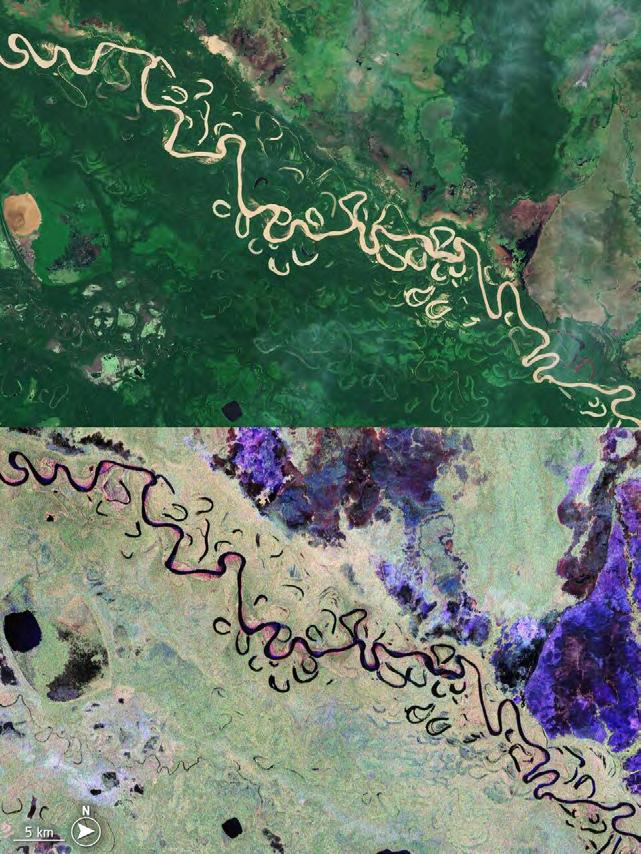
The true strength of the Biomass mission lies not in identifying features from a single image, but in its unique sampling technique and ability to combine multiple
observations of the same area to reveal forest height and biomass. This enables scientists to accurately quantify forest carbon stocks and better understand the role of tropical forests in the global carbon cycle.
The first image, in two parts, is a capture of Bolivia from Biomass but featured below an image of the same area from Copernicus Sentinel-2.
Although the images appear visually similar, the Biomass image offers significantly more information for quantifying forest carbon stocks. This is primarily thanks to its longwavelength radar, which can penetrate the canopy and characterise the entire forest structure. In contrast, the optical Sentinel-2 image captures only the top of the canopy.
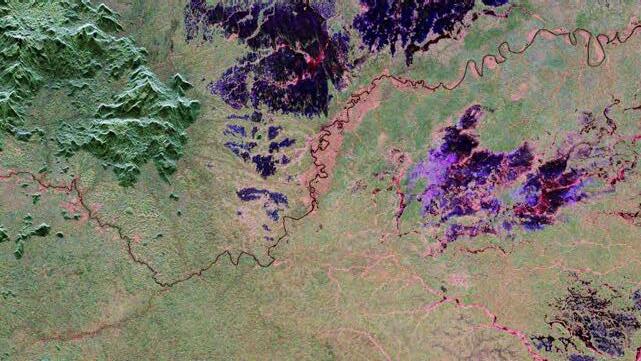
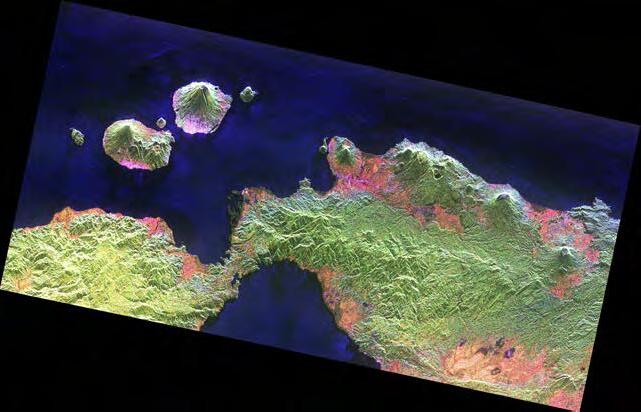
This particular image clearly demonstrates that, beyond providing insights into rainforests, the Biomass P-band radar also reveals topographic features, as its long wavelength can penetrate down to the forest floor.
The fourth capture features Gabon in Africa. The Ivindo River, which is vital to the health of the rainforest, is clear to see in this striking image. Other than the river and tributaries, the image is predominantly green, representing dense forest. The visibility of distinct topographical features in this image further underscores the radar’s capability to image through forest canopies to the terrain underneath.
This second image is actually the very first acquisition that Biomass returned. It offers another striking view of the Amazon rainforest, but this time over northern Brazil. In the southern part of the image, pink and red hues reveal the presence of wetlands, highlighting Biomass’ ability to penetrate dense vegetation and detect features down to the forest floor. The dominance of red tones along river indicates forested floodplains, while the northern area, depicted in rich green, reveals more rugged topography and dense, continuous forest cover.
The third image features tropical forest on islands in Indonesia. This is the Halmahera rainforest, situated in mountainous terrain, much of which has volcanic origins. Several volcanoes remain active in the area, including Mount Gamkonora, visible near the northern coast in this image.
Biomass also offers opportunities to explore other aspects of our planet, as the following two images demonstrate.

The radar is expected to be able to penetrate through dry sand by as much as five metres. Data can, therefore, be
used to map and study sub-surface geological features in deserts, such the remains of ancient riverbeds and lakes. This will help understand the past climate and also help prospect fossil water resources in desert regions.
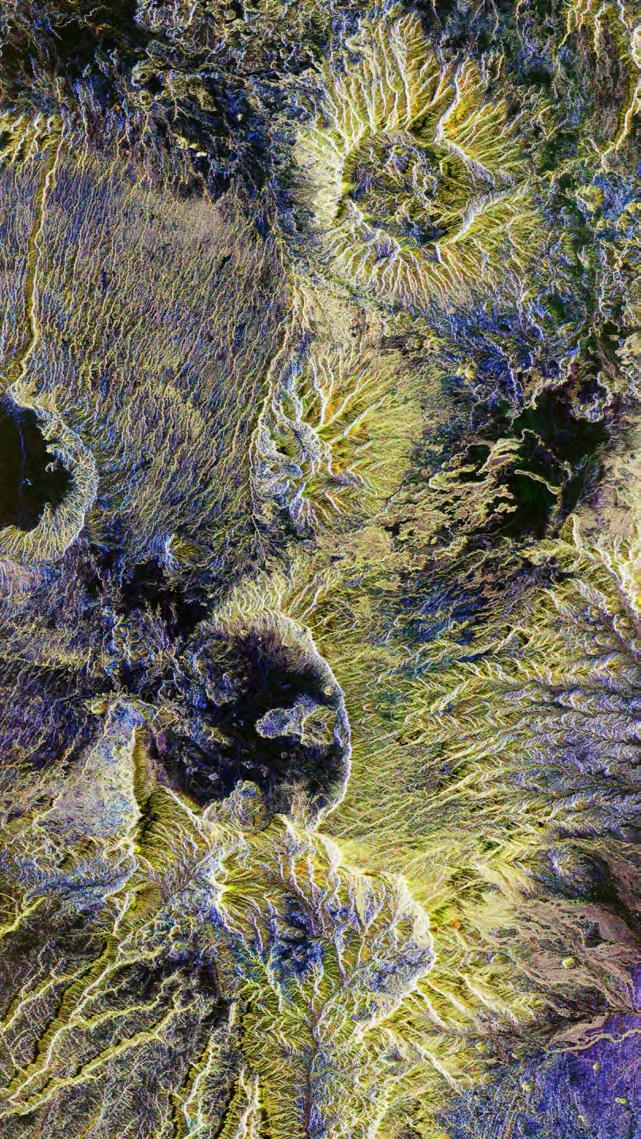
The last image shows a portion of the vast Antarctic Transantarctic Mountains with one of the large ice streams, Nimrod Glacier, flowing into Ross Ice Shelf.
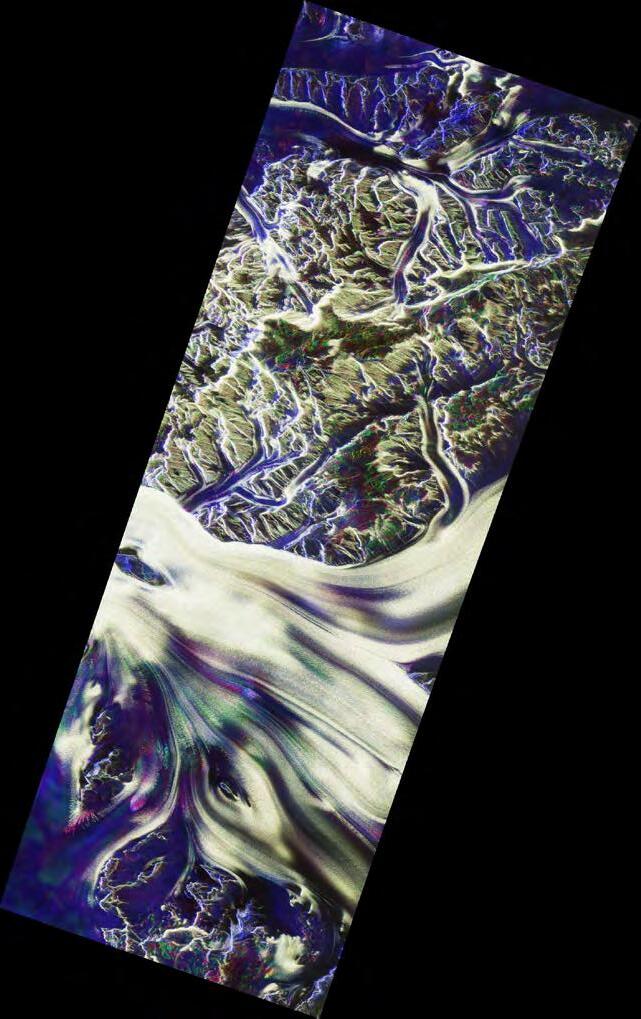
Indicating that this can indeed be achieved, the fifth image, above, shows the stunning structure of part of the Sahara Desert in Chad. This image covers part of the Tibesti Mountains, a mountain range in the central Sahara, mainly located in the extreme north of Chad.
The long wavelength of Biomass’ radar allows for deeper penetration into ice, enabling the retrieval of valuable information on ice velocity and the internal structure of the ice, capabilities that shorter wavelength radars cannot achieve effectively. And this image indicates that this could be a possibility.
More details here
(from ISRO release, July 2025)
The Indian Space Research Organisation (ISRO) continues to make steady and determined progress on its flagship Gaganyaan mission. As part of this mission, ISRO selected four Indian Air Force test pilots and imparted comprehensive training abroad as well as in India as a preparation towards Gaganyaan missions. Currently they are part of ISRO's Human Space Flight Centre and undergoing Gaganyaan mission specific training. In February 2024, the Prime Minister personally awarded these four astronauts their wings at the Vikram Sarabhai Space Centre, celebrating their grit and reaffirming India's commitment to human space exploration. Major milestones achieved by the Gaganyaan Program include the successful demonstration of the Crew Escape System in the TV-D1 test flight, advanced hardware integration for the uncrewed Gaganyaan-1 mission, and continued astronaut training. Preparations are also in progress for subsequent abort missions. The first uncrewed test flight is targeted for the fourth quarter of 2025, with the first crewed Indian mission expected by first quarter of 2027. These developments have their roots in a decisive moment of national vision—when the Hon'ble Prime Minister of India, Shri Narendra Modi ji, formally announced the Gaganyaan Programme on 15th August 2018, setting India on the path to launch its own astronauts into space using indigenous capabilities.
It was under his guidance that the foundation was laid for this joint collaboration between ISRO and the United States. During his historic visit to the USA in 2023 and his meeting with the then-President of the United States, this very mission was envisioned—to send an Indian astronaut to the International Space Station as part of a broader partnership.
Today, ISRO is proud to announce the successful launch of the Axiom Mission 4 (Ax-04) on 25 June 2025. The mission lifted off from Launch Complex 39A at the Kennedy Space Centre, Florida, USA, at 12:01 Hrs IST aboard a SpaceX Falcon 9 rocket, carrying four international crew members. The Ax-04 crew includes Commander Peggy Whitson, Pilot Shubhanshu Shukla from India, and Mission Specialists Sławosz Uznański from Poland and Tibor Kapu from Hungary.
Shubhanshu Shukla, an ISRO astronaut from the Gaganyaan pool, has been selected as the Mission pilot and prime crew member for the Ax-04 mission, while Prashanth B. Nair, also an ISRO astronaut from the Gaganyaan pool, has been nominated as the backup crew member for the mission.
Both Shubhanshu Shukla and Prashanth B. Nair have undergone intensive training across multiple international facilities. This includes training at NASA's Johnson Space Center, Axiom Space's headquarters in Houston, and SpaceX's Dragon mission simulators. The training modules covered are advanced spacecraft systems, emergency protocols, scientific payload operations, microgravity adaptation, space medicine, and survival training. They also participated in NASA's National Outdoor Leadership Program (NOLPS) in the wilderness of Mexico, where the focus was on team cohesion and resilience under stress. The training reflects the highest standards of astronaut readiness, making them a proud representative of India's growing cadre of space explorers.
More details here
The Japan Aerospace Exploration Agency (JAXA) Institute of Space and Astronautical Science (ISAS), in collaboration with Rikkyo University and the University of Tokyo (UTokyo), has successfully captured a series of images of the Earth's entire plasmasphere using the ultra-small extreme ultraviolet imager, PHOENIX, mounted on the deep space explorer, EQUULEUS.
This achievement marks an important milestone in the scientific utilization of nano and micro deep space spacecraft, and bring new possibilities to future space planetary exploration missions. The results of this research were published in the Journal of Geophysical Research: Space Physics on 24 April 2025.
EQUULEUS is a 6U CubeSat (1U = 10cm x 10cm x 10cm) for deep space exploration that was jointly developed
by JAXA and the University of Tokyo. The mission was launched onboard the NASA Space Launch System in November 2022. EQUULEUS carries the EUV imager PHOENIX, which is both ultra-small at less than 1U, and ultra-lightweight with a mass of less than 0.55kg, yet is capable of observing the emission from the plasma around the Earth with high sensitivity (Figure 1).
The PHOENIX camera is designed to observe extreme ultraviolet (EUV) radiation at a wavelength of 30.4 nm, corresponding to a specific emission line from helium ions (He) in the space surrounding the Earth (plasmasphere).
▼ Figure 1: On the left is the ultra-small deep space probe EQUULEUS. (Image credit: JAXA / University of Tokyo) On the right is the ultra-small extreme ultraviolet imager, PHOENIX. (Image credit: Modified from Kuwabara et al. 2025).
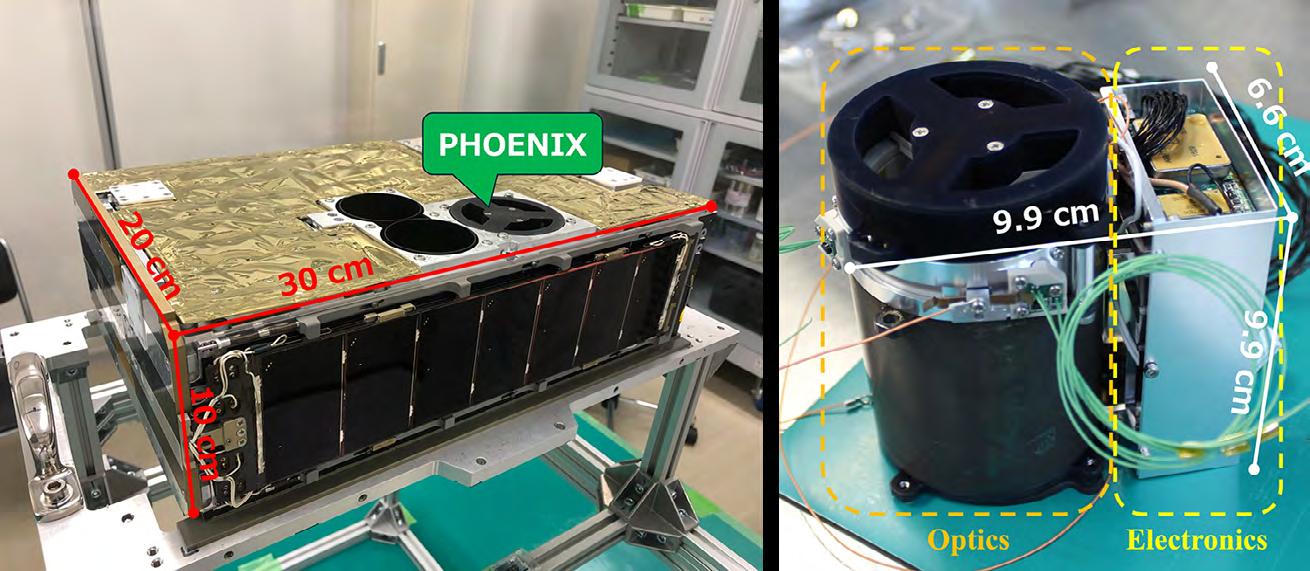
Light at this wavelength is absorbed by the Earth's atmosphere, so observations must be conducted from space. The design for PHOENIX utilises a mirror with a multilayer coating to achieve high reflectivity, enabling the camera to efficiently detect weak EUV light.
PHOENIX successfully captured multiple global images of the Earth's plasmasphere (Figure 2) during EQUULEUS's journey to the Earth-Moon Lagrangian point in May 2023. The plasmasphere is a region within the Earth's magnetosphere containing a large quantity of low-energy plasma that is trapped by the Earth's magnetic field.
Observations of plasmasphere to date have mainly been conducted from the north side (top side) of the Earth. Observations from above allow a view of the overall structure of the plasmasphere, but because the plasma at different altitudes and latitudes appear to overlap,
the detailed density distribution is difficult to grasp. By observing the Earth's plasmasphere from the side, PHOENIX was able to clearly capture the plasma density structure along the magnetic field lines.
Side-on observations are suitable for revealing the threedimensional structure of the entire plasmasphere, and allow for a detailed analysis of the plasma distribution around the Earth. In particular, it is possible to clearly identify the outer edge of the plasmasphere and its fluctuations, which are difficult to capture from the direction towards the centre of the Earth. In addition, by directly visualizing the plasma structure along the magnetic field lines, new insights have been provided to elucidate the detailed density distribution and dynamics of the plasmasphere.
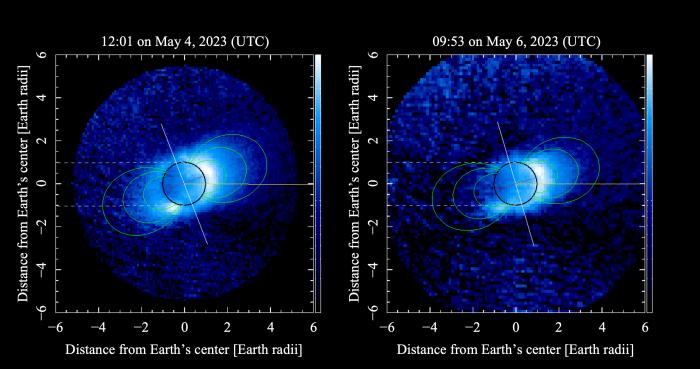
▲ Figure 2: Complete images of the Earth's plasmasphere observed with PHOENIX. The black circle is the Earth, the red line is the magnetic equator, the yellow line marks the direction of the Sun, the white line is the magnetic axis (upward direction is the South Pole), and the green lines are the magnetic field lines of L = 2,3,4. The area surrounded by the grey dotted lines shows the shadow of the Earth. It can be seen that the plasma around the Earth is distributed along the magnetic field lines. It's also possible to see that the plasmasphere photographed on May 6 (during a geomagnetic disturbance) has shrunk compared to May 4 (when there was geomagnetic quiet). (Image credit: Modified from Kuwabara et al. 2025)
This has made it possible to understand the detailed three-dimensional structure of the plasmasphere, which has previously been difficult to achieve.
These observations also made it possible to confirm the contraction of the plasmasphere associated with geomagnetic disturbances. This phenomenon occurs when the plasmasphere surrounding the Earth is pushed from the outside by strong winds (solar wind) and highenergy particles emanating from the Sun, causing parts of the plasmasphere to be eroded or pushed outwards. The contraction of the plasmasphere was particularly noticeable in the low-latitude regions on the nightside, which was confirmed to be consistent with past observations. Detailed analysis of the imaging data further revealed that the position of the outer edge of the plasmasphere fluctuates over time, allowing capture of the dynamics of the plasmasphere in response to changes in the magnetospheric environment.
Through calibration observations using a star in orbit, PHOENIX has been demonstrated to be capable of high-precision observations, despite the small size, and has the ability to capture spatio-temporal variations in the plasmasphere.
In addition to being physically small and lightweight, nano and micro satellites and probes are characterized by the ability to be developed at low cost, and in
a short period of time. These features allow a wide range of researchers to frequently conduct pioneering space science missions as their own missions, and the technological and scientific results obtained from these missions will in turn lead to larger missions such as those for medium-class projects.
The 30.4nm wavelength targeted by the PHOENIX team lies in the extreme ultraviolet region, and contains many emission lines present in planetary atmospheres and the surrounding plasma. In recent years, the efficiency of detectors and optical elements suitable for this wavelength range has rapidly advanced, and has attracted attention not only for planetary science, but also from the perspective of astrophysics. This results achieved here can be said to serve as a first step towards future large-scale missions that go beyond the boundaries of ultra-small missions.
This research shows new possibilities for observing the Earth's plasmasphere using ultra-small spacecraft. This is an important step in opening up new avenues for deep space observation using ultra-small spacecraft, which are being used by many organisations in recent years, including those in the private sector. In the future, missions such as EQUULEUS are expected to enable detailed investigation of long-term variations in the plasma environment around the Earth, and this will assist with purposes such as space weather forecasting.
(from SpaceX, July 2025)
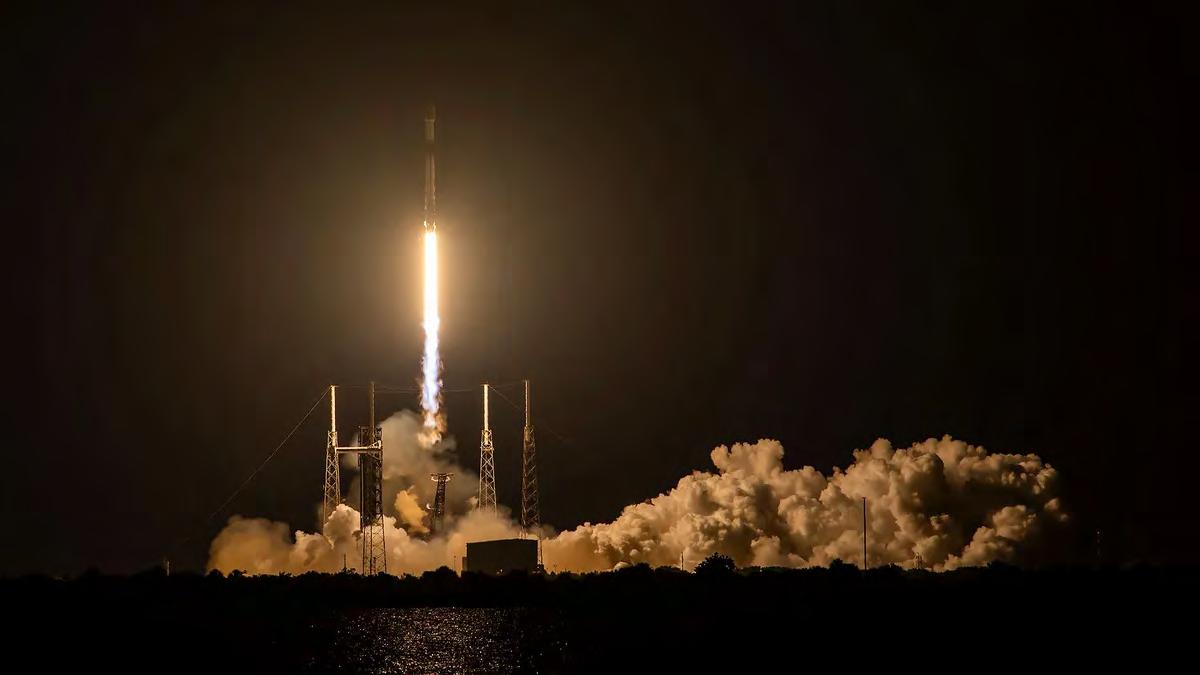
SpaceX's 500th Falcon 9 rocket was launched on 2nd July 2025, carrying 27 Starlink satellites, from Cape Canaveral. In addition to this major milestone, the rocket included the 29th reuse of its first stage, which is more than any other booster of the SpaceX fleet.
(from ESA release, June 2025)
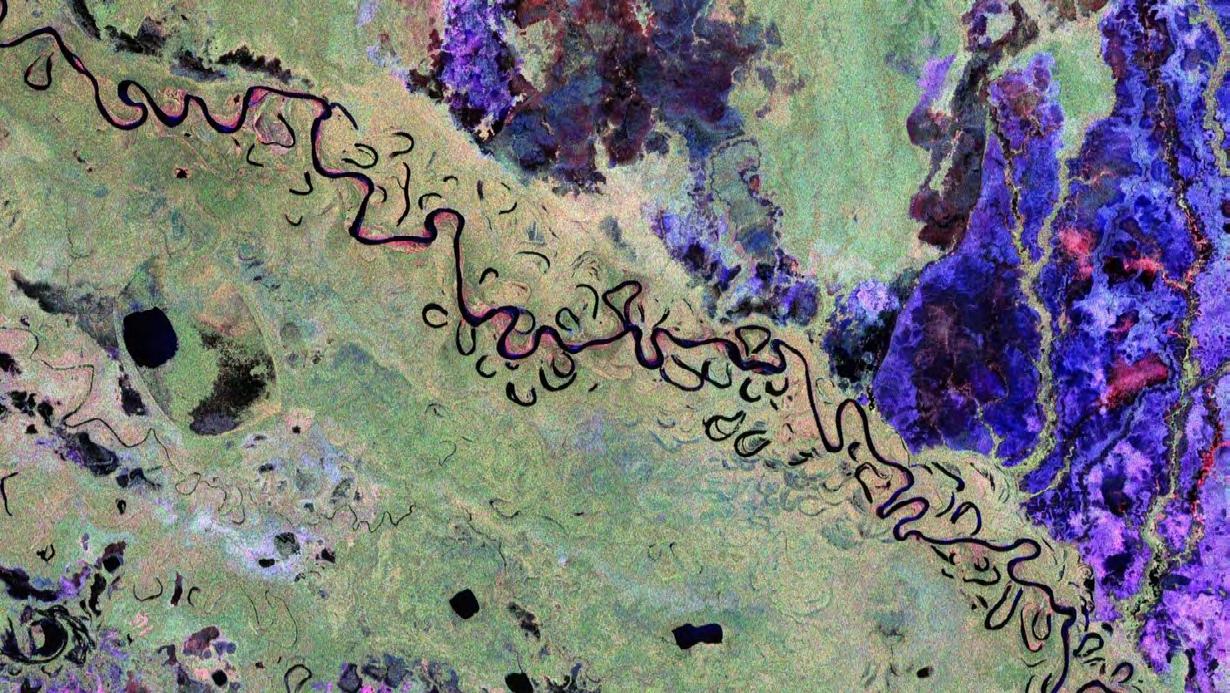
ESA revealed the first stunning images from its groundbreaking Biomass satellite mission – marking a major leap forward in our ability to understand how Earth’s forests are changing and exactly how they contribute to the global carbon cycle. This image features part of Bolivia. Bolivia has experienced significant deforestation, ranking among the highest globally for primary forest loss. Although there are complex reasons at play, this is primarily driven by forest clearance for agricultural expansion. Over time, the Biomass mission will be used to determine how carbon stocks stored in this kind of forest are changing.
This vibrant image was created using the radar instrument’s different polarisation channels, with each colour revealing distinct characteristics of the landscape. For instance, green hues mainly represent rainforest, red hues forested floodplains and wetlands, and blue–purple is indicative of grasslands, while black areas are rivers and lakes. The image spans approximately 90 km along the Biomass satellite's flight path (length) and 60 km across in width, with north oriented to the right.
(see Biomass article on page 54)
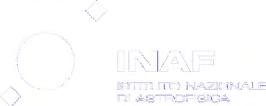

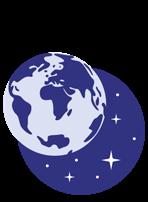

15-21 September 2025
Recife, PE, Brazil Space Week Nordeste 2025
17-22 August 2025
Sydney, Australia
2025 URSI Asia-Pacific Radio Science Conference
31 August - 6 September 2025
Lisbon, Portugal
IAGA-IASPEI Joint Scientific Assembly 2025
21-24 September 2025
San Juan, Puerto Rico, USA
71st Radiation Research Society (RRS) Annual Meeting
29 September - 3 October 2025
Sydney, Australia
International Astronautical Congress 2025
1-5 September 2025
Rimini, Italy
IAG Scientific Assembly 2025
11-14 September 2025
Frankfurt/Main, Germany IUPS congress
15-19 September 2025
Belgrade, Serbia, and virtual Int. Conf. on Trends in Geoscience Research and Applications
29 September - 3 October 2025
London, UK
European Radiation Protection Week ERPW2025
29 September - 10 October
Trieste, Italy
ICTP-UNOOSA-COSPAR CBW on IRI and NeQuick – Improving the Representation of the Real-Time Ionosphere
13-16 October 2025
Helwan, Egypt
The Arab Conference on Astronomy and Geophysics (ACAG 9) – SCIENCE FOR SOCIETY
Meetings organized or sponsored by COSPAR are pinned and shown in bold face. You can find more information by clicking on the events names.
14-17 October 2025
Madrid, Spain
15th European Aeronautics Science Network (EASN) Int. Conf.
20-31 October 2025
Bangalore, India
A Hands-on Workshop with JWST and UVIT: Galaxies on a Resolved Scale
27-30 October 2025
Virginia Beach, VA, USA/virtual Network for the Detection of Atmospheric Composition Change (NDACC) Symp.
27-31 October 2025
Umeå, Sweden
European Space Weather Week (ESWW) 2025
3-7 November 2025
Nicosia, Cyprus
6th COSPAR Symposium: Space Exploration 2025: A Symposium on Humanity's Challenges and Celestial Solutions
10-14 November 2025
Rome, Italy
Beacon Satellite Symposium 2025
17-29 November 2025
Kribi, Cameroon
African Space Hydrology Capacity
Building Workshop “AfrHySpace”
1-12 December 2025
La Plata, Argentina
ASTRAL-X: Advanced Spectral-Timing Polarimetry, and High-Resolution Spectroscopy X-ray School for Latin America
25-29 January 2026
Houston, TX, USA
23rd Conference on Space Weather, American Meteorological Society
9-13 February 2026
Liberia, Costa Rica
17th International Symposium on Equatorial Aeronomy (ISEA-17)
16-20 February 2026
San José, Costa Rica
United Nations/Costa Rica/ COSPAR Workshop on Machine Learning applied to Space Weather and Global Navigation Satellite Systems (GNSS)
The world stands at a pivotal moment for space exploration. Against a backdrop of shifting geopolitical landscapes and pressing terrestrial concerns, the global space research community will convene in Nicosia, Cyprus, from 3-7 November 2025, for the 6th COSPAR Symposium. Hosted by the Cyprus Space Exploration Organisation (CSEO), this landmark event, themed “Space Exploration 2025: A Symposium on Humanity's Challenges & Celestial Solutions,” is more than a scientific conference; it is a crucial forum to collectively chart humanity's next steps in the cosmos.
COSPAR 2025 promises an exceptionally rich and diverse programme, built around five main scientific pillars. With a record-breaking 330 abstract submissions received, the scientific discourse will be vibrant and cutting-edge. A central focus of the Symposium will be the presentation and in-depth deliberation of the new COSPAR Exploration Roadmap. This crucial document, developed through extensive international consultation, will chart the course for scientific exploration priorities and international collaboration for the next decade and beyond.
High-level dialogues will be a cornerstone of the event. The Roundtable of Space Leaders will feature a panel discussion with top executives from leading space agencies including NASA, ESA, JAXA, CNES, ASI, DLR and ISRO. This open session will tackle international collaboration, planetary defence, and responsible space policy. These discussions will be framed by inspiring keynote addresses from visionary leaders such as Prof. Pascale Ehrenfreund (COSPAR President), Ms. Mary Snitch (Principal, Lockheed Martin Space), Dr. Doris Daou (NASA Program Scientist), and others.

Beyond the core scientific sessions, COSPAR 2025 will feature an unprecedented programme of special events designed to inspire innovation and engage the public. A key highlight is the culmination of NovaSpaRC, COSPAR's 1st ever International Innovation in Space Research Competition. This global initiative challenges teams to develop revolutionary AI/ML solutions for space debris tracking and space biology, with prestigious awards
presented by Grand Sponsor Lockheed Martin during the Closing Ceremony.
Public engagement will be ignited through a series of unique events:
• A captivating Public Science Exhibition showcasing a unique space exhibits from around the world.
• The vibrant Nicosia Space Science Street Festival, an openaccess event with astronauts and interactive science for all.
Nicosia, a city steeped in over 4,500 years of history, offers a magnificent and welcoming backdrop. The Symposium venue sits within the ancient Venetian walls, in a historic quarter of sandstone streets and artisan workshops. This unique setting provides a professional conference environment paired with direct access to Cyprus's cultural landmarks.
The social programme is designed to foster networking and immerse guests in the local culture. The highlight will be a spectacular Traditional Cypriot Night, featuring authentic cuisine, Cypriot dances and a live halloumimaking demonstration – a true taste of Cyprus! Attendees can also discover the historic heart of Nicosia on a guided evening tour or opt for a full-day excursion to Paphos, the mythological birthplace of Aphrodite, featuring stunning UNESCO World Heritage sites.

COSPAR 2025 in Nicosia is more than an event; it's an opportunity to be part of a defining moment. It's where the global space community will address critical challenges, showcase groundbreaking innovations, and forge the collaborations that will shape our future in space and on Earth.
Visit the official symposium website for registration, the full programme, and travel information: www.cospar2025.org
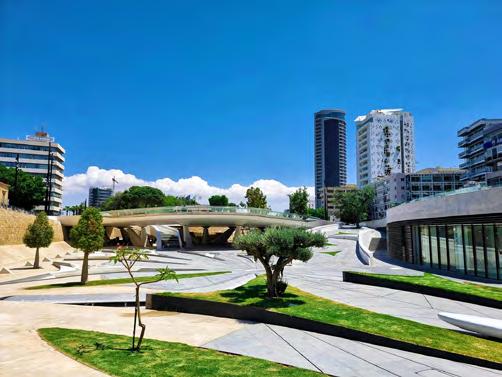


We eagerly look forward to welcoming you to Nicosia for a week of pioneering science, high-level dialogue, and the unforgettable warmth of Cypriot culture !
As you can see, this is a unique opportunity to present your work, network with a high-calibre international audience, contribute to a defining moment for the global space community—and discover Cyprus.
Among some of the special events in the program, you will have the chance to:
• Engage with Visionary Leaders: Attend keynotes from Pascale Ehrenfreund (COSPAR President), Lockheed Martin, EU Members of Parliament and other executives.
• Hear Doris Daou (NASA HQ) talk about the International Year of Asteroids and Planetary Defence
• Attend a thought-provoking Interdisciplinary Panel on Innovation, AI & Sustainable Solutions, and a discussion on responsible human presence on and around the moon, hosted by Eric Smith (LMC, Chair of the Panel on Innovative Solutions).
• Celebrate Innovation: Be present for the first COSPAR Innovation Awards.
• Take part in a Bioinformatics Workshop and Moon Mars Astronaut Analogs.
In short, this is your chance to be part of critical conversations defining space science and policy today. We hope you can join us.
Although it’s summer here in the Northern Hemisphere, and November might seem a long way off, do remember to start booking your travel and accommodation now for the COSPAR Symposium.
Flights should be booked to Larnaca (LCA) or Pafos (PFO) airports only, and detailed information about hotels and airport transfers can be found at https://cospar2025.org/accommodation/
And please don’t leave registration until the last minute! The regular registration rate runs until 30 September, with special reduced rates for Students as well as Early Career and Retirees.
We look forward to seeing you.
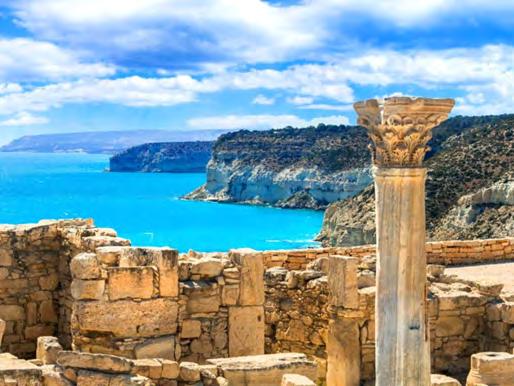
The Panel on Education is holding a series of inspiring and practical sessions for educators interested in space. This workshop weekend is free for educators, the registration link is on the next page.
Friday 7 November
12:00-13:00: Closing Ceremony (EXPLORE in a Nutshell, and Student Analog Astronaut Testimony)
Saturday 8 November
09:00-10:00: IDEA and Innovation in Schools
10:00-12:00: EXPLORE Project (Hands-on session)
13:00-15:00: StAnD Project (Hands-on session)
15:00-17:00: Space Education Roadmap Roundtable with space education experts from around the Mediterranean.
Sunday, 9 November
09:00-12:00: ASTROJOURNEYS (Hands-on session)
13:00-15:00: Discovery Space (Hands-on a Mission to Mars)

The EXPLORE project is more than just education—it's a gateway to the future. By bringing the spirit of space exploration into the classroom, EXPLORE empowers both students and teachers to embark on a life-changing journey. This summer, EXPLORE I (also known as EXPLORE 25) took place in Monsaraz, Portugal, 22–27 June, where students from three countries became analog astronauts, stepping into the roles of space explorers and mission controllers. Join us at the COSPAR Symposium to see some of the handson training and innovative tools for teachers to enable you to simulate space missions and guide your students toward becoming analog astronauts in the upcoming EXPLORE 26

missions. With a focus on bridging the digital divide, igniting curiosity, and fostering essential 21st-century skills, from critical thinking to teamwork, EXPLORE is turning classrooms into launchpads for imagination, innovation, and real-world scientific engagement. And meet a student analog astronaut from the first EXPLORE mission!
During the workshop, participants will have a sneak preview of the project and have the opportunity to interact with the project virtual toolkit.
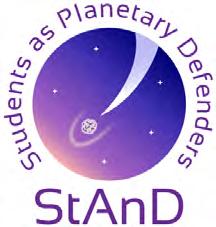
If you are looking for something extraordinary for your STEM subject classes, look no further than the Erasmus+ project Students As Planetary Defenders (StAnD). StAnD provides virtual and physical toolkits ready to use in the classroom, teaching manuals and online support as well as tried-and-tested scenarios created by real teachers. This material will help engage your students—indoors and out—with a variety of out-of-this-world topics, from star dust to meteorites, from asteroids to other celestial visitors, space debris, and the solar system. Spark your students' natural curiosity, and
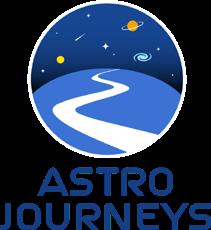
AstroJourneys aim to bring innovation and inclusion to astronomy lessons.
Astro-Journeys provides learners with a unique, interdisciplinary learning experience through an AI-supported platform where educators and learners collaborate to co-create personalised journeys in astronomy. Guided by the “Big Ideas in Astronomy,” these journeys offer learners a modern perspective on the relevance of astronomy in our daily lives.
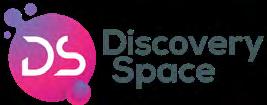
Discovery Space is an Erasmus+ Project that aims to facilitate the transformation of the traditional classroom to an environment that promotes scientific exploration and monitors and supports the development of key skills for all students. It mixes conversational agents with AI-driven learning paths.
at the same time, benefit from the latest innovative tools and technologies to enhance your teaching while gaining EU-recognised open digital badges. Come to the StAnD session during the Panel on Education weekend at the COSPAR 2025 Symposium to find out more.
During the workshop, participants will have the opportunity to learn how to use micrometeorites as a tool to facilitate learning curriculum content and search for asteroids, comets and other solar system objects.
The workshop will promote an observing session with robotic telescopes, image processing with a userfriendly software (Salsa J) and some basic tips on how to use Planetarium Software to understand the night sky. A short session on the integration of AI to support innovative assessment will also be included.
During the workshop, participants will be able to engage in a scenario that invites them to explore Mars (A Mission to Mars).
Interested in bringing space into the classroom? If you are a teacher, register for the free Education Weekend here! We look forward to changing the world of tomorrow with you!
COSPAR publishes scientific papers in both Advances in Space Research (ASR) and Life Sciences in Space Research (LSSR). In this regular section we invite the author or authors of one or more recent papers that have been particularly significant in terms of scientific impact to write extended abstracts that summarise these papers.
Here we have invited Tore Straume and Andy Wyrobek, co-corresponding authors, to summarise their paper "NonDNA radiosensitive targets that initiate persistent behavioural deficits in rats exposed to space radiation" which was published in Life Sciences in Space Research Vol. 45, 44-60 (2025); at this link.
Following this Extended Abstract is another, for the paper "Coastal Sea Level Rise at Altimetry-based Virtual Stations in the Gulf of Mexico", by Lancelot Leclercq et al. published in Advances in Space Research 2024; at this link
—
Richard Harrison, General Editor, SRT.
[ Tore Straume (Lawrence Berkeley National Laboratory, University of California, USA, and NASA Ames Research Center, USA), Ana M. Mora (School of Public Health, University of California, USA), James B. Brown (Lawrence Berkeley National Laboratory, University of California, USA), Ishan Bansal (Lawrence Berkeley National Laboratory, University of California, USA), Bernard M. Rabin (University of Maryland, Baltimore County, Dept. of Psychology, USA), Lesley A. Braby (Texas A&M University, USA), Andrew J. Wyrobek (Lawrence Berkeley National Laboratory, University of California, USA)]
Introduction
Very little is known about the nature of radiosensitive Central Nervous System (CNS) targets for behaviour deficits in response to low dose exposures. Two poorly understood observations in rats with important implications for predicting behaviour risk during deep-space missions are: (1) ions with linear energy transfer (LET) in the 1 to 15 keV/μm range can produce behavioural deficits in rats at much lower doses than heavier ions with LETs in the 100 to 150 keV/ μm range (e.g., Rabin et al. 2011, 2015b; Britten et al. 2018, 2020; Cucinotta and Cacao 2019; Burket et al. 2021) and (2) high energy protons (LET ~0.2 keV/μm) are ineffective in producing behavioural effects in rats (Rabin et al. 2015a). These observations contrast with a large body of radiobiological data in rodents and humans
where densely ionizing ions are more effective than less densely ionizing ions, protons are not ineffective, and where the DNA/ nucleus is the accepted target for radiation-induced tumorigenesis, cytogenetic aberrations, genetic mutations, and reproductive cell death. We investigated the very different LET responses observed for behavioural effects in rats compared with those observed for DNA-related endpoints and concluded that the radiosensitive targets for behaviour deficits cannot be DNA or chromosomes. Our analyses of the biophysical nature of the radiosensitive CNS targets for persistent behavior deficits supports the new hypothesis of sub-micron sized targets consistent with the thickness of plasma membranes or small CNS structures, smaller than a whole synapse.
We investigated four space-relevant behaviours that are controlled by different regions of the CNS in rats: Elevated Plus Maze (EPM) which measures anxiety, associated with amygdala function; Novel Object Recognition (NOR) which measures recognition memory associated with hippocampus-perirhinal-cortex functions; Operant Responding (OR) on an ascending fixed-ratio reinforcement schedule (number of bar presses to receive food) which evaluates responsiveness to environmental stimuli, including changes in reinforcement contingencies associated with striatum (dopamine) functions; and Attentional Set Shifting (ATSET) performance which evaluates simple and complex discrimination by rats to gain access to food (e.g., Britten et al. 2018). The behavioural responses to space radiation were compared to DNA-related responses (i.e., tumour induction and chromosome aberrations) using open-source
When analyzed by dose (Fig 1a), we confirmed that ionizing particles with LETs in the 1 keV/μm range are ~100-fold more effective for producing behavioural deficits than densely ionizing particles in the 150 keV/μm range, e.g., threshold dose estimates: 0.1-1 cGy for 4He vs. 15-100 cGy for 56Fe. We also confirmed that very low LET radiations, e.g., 1000 MeV protons (LET 0.2 keV/μm) are ineffective in producing behavioural deficits in rats. When analyzed by fluence (Fig 1b), the behavioural responses converged for all LETs between 1 and 150 keV/μm, indicating that 4He and 56Fe were equally effective on a per-track basis. These unique features of radiation-induced behavioural deficits (high sensitivity to particles in the 1-keV/μm range, insensitivity to protons in the 0.2 keV/μm range, and isofluence dependence for particles with LET>1 keV/μm) provide evidence in support of a new hypothesis of submicron sized radiosensitive targets for behavioural effects consistent with the thickness of plasma membranes or small structures of any shape, smaller than a whole synapse. Our findings raise questions regarding the identity of targets, the multi-cellular functional units for behaviour risks, lowdose susceptibility, and generalizability from rat to other species and astronauts, as discussed in Straume et al. 2025.
Elevated plus maze: Figure 1 illustrates the behaviour results for the EPM assay in rats. Results from evaluations of all four assays are presented in Straume et al. 2025. For the EPM behavioural assay, rats were placed on the centre
rodent and human datasets to investigate the roles of dose, fluence, linear energy transfer (LET), relative biological effectiveness (RBE), and target dimensions. We compared the behaviour and DNA responses with those of another non-DNA damage endpoint (i.e., mouse immature oocyte killing), where the radiosensitive target is known to be the plasma membrane (Straume et al. 1987, 1989). This immature oocyte model provides a non-CNS comparison of DNA-related versus membrane-like targets, independent of behaviour. The ions selected for the behaviour analyses included a light ion (4He) and a densely ionizing ion (56Fe), both significant contributors to exposure in deep space. Also included were 1H, 12C, 16O, 28Si, 40Ar, and 48Ti because data were available for some behavioural endpoints. The details of these analyses are presented in Straume et al. 2025.
area of the EPM that consists of four radiating arms (two open and two closed) and their movements tracked for 5 minutes with a series of infra-red photocells to measure the time spent in the open arms and time spent in the closed arms. Fig. 1a illustrates dose-dependent preferences of rats to spend less time in the open arms and more time in the closed arms with increasing doses of 4He or 56Fe ions, as discussed in Straume et al. 2025.
As shown in Fig 1a, 56Fe exposures required a substantially higher absorbed dose (D) to reach the same level of response as 4He. For example, the DFe/DHe ratio at the value of 65% time in the closed arms is about 100/0.5 = 200. Thus, 4He is ~200 times more effective per dose than 56Fe for EPManxiety. For DNA-related endpoints, 56Fe is usually more effective than high energy 4He, which is the opposite effect of the behavior response for the same ions (NCRP 1990).
In Fig. 1b, the EPM-anxiety responses are plotted against ion fluence rather than dose. The fluence data for 4He and 56Fe converged providing similar detection limits, about 3 particles/100 μm2 for both 1000 MeV/n 4He and 1000 MeV/n 56Fe. Thus, one particle track of 4He appears to be as effective as one track of 56Fe for inducing EPM-anxiety. Because 56Fe deposits about 160 times more energy per unit track length than 4He, this suggests the 4He ion deposits sufficient energy to saturate the behavioural response per track so that the additional damage from the densely
1
▲ Figures 1a and 1b: Elevated Plus Maze (Straume et al. 2025). Comparison of dose (1a, left) and fluence (1b, right) responses in rats exposed to 1000 MeV/n 4He (LET = 0.9 keV/µm) or 1000 MeV/n 56Fe (150 keV/µm).
ionizing 56Fe track is not required. Wasted energy has a powerful influence on the RBE-LET relationship (see Fig. 5 in Straume et al. 2025). Similar dose/fluence/LET relationships are observed with the other rat assays evaluated (Straume et al. 2025), indicating that our findings are applicable to four different behavior domains.
Mouse to rat comparisons: To test the generalizability of our hypothesis to another species, we surveyed a subset of published mouse studies to examine whether the response of mice is consistent with those of rats for space-relevant radiation exposures (Straume et al. 2025). The available murine data for behaviour responses to space radiation are extremely limited in contrast to rat data. Mouse studies seldom used more than two dose levels, never more than 3 (Kiffer et al. 2019), and rarely included animals exposed to doses less than 5 cGy. Mouse and rat data that can be compared show some agreement as well as disagreement. For example, male mouse NOR results (Parihar et al. 2016, 2020) for 4He and 48Ti are consistent with findings in male rats, i.e., 4He ions more effective in producing NOR deficits than heavier ions. However, exposure to 48Ti was more effective than 16O, which is contrary to what is observed in rats. Our analyses employed multiple datasets that contain large numbers of dose groups per experiment, including doses substantially less than 5 cGy, (e.g., Figs. 1a) and provide insights into low-dose relationships, which are of
particular significance for human space travel. The current paucity of low-dose data for mice is a major limitation for comparing responses (and thresholds) at the low doses where the highest rate-of-change of behaviour is observed in rats. To test the trans-species relevance of our rat findings will require replicate mouse experiments with emphasis on low-dose exposure groups (<5 cGy and even <1 cGy), using the same assays, ions and energies used in the rat studies. Also, substantial differences have been observed between male and female mice for some behavioural assays (e.g., Parihar et al. 2020). This requires complementary experimentation with male and female rats.
Target dimensions: To gain insights into the dimensions of the radiosensitive CNS targets that determine behaviour risks we compared the numbers of ion pairs (ionization events) produced within various target configurations along single tracks of space-relevant ions. We calculated the number of ion pairs per track for target thicknesses ranging from < 0.01 μm (synapse gap and related receptors and reuptake pumps) to >10 μm (e.g., diameter of the neuron cell body, soma), based on unit density targets (see Figure 10 in Straume et al. 2025). Energy deposition in tissues exposed to radiation begins with the production of ion pairs (a negative and a positive ion), with the assumption that at least one ion pair is required to produce biological damage. The average energy required to produce an ion
pair (W) in liquid water is about ~20 eV (Ward 1988). Water content of CNS cells, including axons and glial cells, is about 80 to 90 %. These high-water concentrations suggest that the W for CNS-related targets is like that for water.
For our analyses, we assumed orthogonal traversals for membrane-like targets and effective diameter for spherical targets. Ion pairs per track is the average number of ion pairs produced in the target per track traversal when many observations are considered. For single tracks, Poisson statistics would apply. Random positioning of membranelike targets in a behavioural network would produce more ion pairs per track due to tangential traversals, which would tend to decrease the critical target thickness. If more than 1 ion pair (i.e., a cluster) were required to register CNS damage, the critical target thickness would be larger. Ionpair clusters are important for DNA-related effects (i.e., production of double strand DNA breaks) but thought to be less relevant to CNS behavioural effects due to limited repair, as suggested by the lack of an increase in response to increasing LET. As expected, higher LET radiations produce more ion pairs per target thickness, smaller targets would contain fewer ions, and very small targets may not contain any ionization events within them. The minimum target thickness predicted to contain at least one ion pair when traversed by a 1000 MeV/n 4He ion is 0.01 to 0.03 μm, which is the approximate thickness of a cell membrane. The unexpected observations of minimal behaviour effects
after exposure to high-energy protons (1H) provides a special case that supports our hypothesis that behavioural deficits involve small or thin membrane-like targets. The “critical thickness” is the target thickness where lower LET radiations transition from reliable energy deposition within the target to occasional energy deposition within the target. This occurs when the target thickness is smaller than the mean distance between ionizations. At target thicknesses below about 0.1 μm, the efficiency of 1000 MeV 1H ions (LET ~0.2 keV/μm) to produce ion pairs is diminished, and it is substantially diminished at 0.01 μm, the thickness of a typical plasma membrane. The 150 MeV protons (LET ~0.55 keV/μm) produce about 2.5 times more ion-pairs than 1000 MeV protons. This is consistent with the findings of Rabin et al. (2015a) who found no reliable cognitive impairment following exposure to 1000 MeV protons but noted a marginal response following exposure to 150 MeV protons.
Comparison of dose and fluence responses among four behavioural domains: The dose and fluence thresholds for behavioural impairments in 4 behaviour domains were estimated from datasets from multiple studies of behaviour performance in male rats exposed to space-relevant ions from two independent labs (Fig. 2). Fig. 2a suggests that very low LET ions (1000 MeV protons and gamma rays, LET ~0.2-0.3 keV/μm) are inefficient in producing ionization events within behavioural targets. This is consistent with very thin or small target dimensions (<0.1 μm) where the
▲ Figures 2a and 2b: Relationships between LET and exposure thresholds (dose versus fluence) for behaviour deficits in four behaviour domains based on data from independent studies of male rats exposed to various space relevant ions: (2a, left) threshold dose vs LET. (2b, right) threshold fluence vs LET. Behaviour assays: OR=Operant Responding, NOR = Novel Object Recognition, EPM = Elevated Plus Maze, ATSET = Attentional Set Shifting (See Straume et al. 2025).
sparse ionizations from low LET ions have larger mean free paths than the target thickness. Notably, the 4He ions with LETs in the ~1 keV/μm range have the lowest threshold dose (i.e., highest effectiveness) compared to all other ions plotted in Fig 2a. This suggests that the mean free paths between ionization events for ions with LETs of ~1 keV/μm fall within a tissue thickness of 0.01 to 0.1 μm.
Optimum effectiveness would also be influenced by the high fluence per dose of 4He relative to higher LET ions, as illustrated in Fig 2b. Higher LET radiations (48Ti and 56Fe) have lower fluence per dose but produce more ionizations per track than are required to initiate damage (see Straume et al. 2025 for additional discussion). The consequence is a tendency toward isofluence responses between 4He and 56Fe as observed in Fig. 2b. It is significant that this trend is consistent among four different behavioural tests and two rat strains (male S-D and male Wistar) in independent experiments performed by two different labs.
Implications for human travel in space: The absorbed dose to brain expected in interplanetary space (e.g., a mission to Mars) from all GCR ions is about 10-12 cGy/yr (Cucinotta and Cacao 2019). The current CNS dose limits (NASA 2023) are 50 cGy (30 d), 100 cGy (1 y), 150 cGy (lifetime). Also, special CNS limits for Z ≥10 which are 10 cGy (1 y) and 25 cGy (lifetime). The results in Fig. 2b would suggest a simpler dose limitation system based on fluence. The data available in rats suggest intermediate LETs (1 – 15 keV/μm) may be major contributors to behaviour risk during and after a mission to Mars. These observations in rats have important implications for astronaut risk assessment and demand additional data to determine whether these LET/ risk relationships extend to other rodent species (mice), are influenced by potential modifying factors such as sex, age, time post exposure, and are reproducibly observed across independent research laboratories.
Thin radiosensitive targets as components of a behavioural network: Our analyses of the relative effects of ion fluence, dose, and LET across numerous space-relevant ions and different behaviour endpoints in rats suggest that radiosensitive targets for behavioural deficits require energy deposition into small or thin membrane-like structures (0.01 - 0.1 μm minimum thickness) and that the functional units of behavioural deficits (targets) are broadly distributed within a hypothesized “behavioural network”. These networks
could include neurons as well as non-neuronal targets that may interact with (or otherwise impact) neurons, such as microglia, astrocytes, and endothelial cells. Evidence supporting this hypothesis includes:
a. The low response observed for behavioural deficits in rats following exposures to very low LET radiations (0.20.3 keV/μm; 1000 MeV protons and high-energy gamma rays) is consistent with ineffectiveness due to their sparsely ionizing tracks traversing a thin (membrane) or small target creating few ionizations.
b. The high responses observed for behavioural deficits in rats exposed to space-relevant ions in the 1 to 15 keV/ μm range (4He, 12C, 16O) are consistent with their ability to produce ionizations in small targets and their relatively high fluence compared with heavier ions.
c. Low response for heavy ions (48Ti, 56Fe) is consistent with diminished effectiveness from wasted energy deposition (“overkill”) due to low saturation threshold per individual track in the behavioural target, i.e., for 1000 MeV/n ions, one 4He track is as effective as one 56Fe track suggesting the 4He ion deposits sufficient energy to saturate the response per track so that the additional damage from the densely ionizing 56Fe track is unnecessary and is therefore wasted. That would result in isofluence response for ions above ~1 keV/μm, as observed in Fig. 2b
Straume et al. 2025 identified several research gaps for spaceradiation-induced behaviour deficits in rats. Of particular significance for future deep space human missions are:
1. Determine whether the dose, LET, and fluence responses observed in male rats occur in other rodent models and females, which would strengthen their potential relevancy for astronaut risk assessment.
2. Identify the nature of the CNS targets that affect behavioural responses in rodents, focusing on the roles of membranes and their sub-micron constituents and interactions between neurons and supporting cells.
Finally, it is prudent to keep an open mind that humans may not exhibit the effects at the very low space-relevant doses similar to rodents because of the complexity of human thought processes that have a large capacity to compensate for behavioural deficits and dysfunctions among various CNS domains.
This work was supported in part by NASA under Grants 80JSC019T0007 to AJW and 80JSC019T0025 to AJW, and performed in part under the auspices of the US Department of Energy by the Lawrence Berkeley National Laboratory under contract DE-AC02-05CH11231.This manuscript was made possible through collaboration with the research team of the NASA grant entitled “Predictive modelling of cosmic radiation effects on CNS tissue and operationrelevant performance” (PI: AJW). That NASA-sponsored modelling project (1) evaluated the effect modifiers of dose-response for behavioural deficits in rats exposed to space-relevant radiations including the effects of dose-
response modifiers such as age, sex, gender, diet, and time post-exposure (Mora et al.); (2) applied machine learning tools to investigate the nature of the low dose responses of diverse behaviours (Brown et al.), (3) employed molecular profiling of CNS and peripheral blood cells of behaviour characterized animals to predict individual susceptibility for anxiety and memory deficits after exposure to space radiation (Wyrobek et al.) and (4) analyzed available data to show that radiosensitive targets for persistent behaviour deficits in male rats are not DNA, and that they are thin (membrane-like) or small with thickness in the 0.01 to 0.1 μm range (Straume et al. 2025).
References - The complete list can be found in Straume et al., 2025.
• Britten, R.A., Jewell, J.S., Duncan, V.D., Hadley, M.M., Macadat, E., et al., 2018. Impaired Attentional Set-Shifting Performance after Exposure to 5 cGy of 600 MeV/n 28Si Particles. Radiat. Res. 189, 273-282.
• Britten, R. A., Duncan, V. D., Fesshaye, A., Rudobeck, E., Nelson, G. A., Vlkolinsky, R., 2020. Altered cognitive flexibility and synaptic plasticity in the rat prefrontal cortex after exposure to Low (<15 cGy) doses of 28Si radiation. Radiat. Res. 193, 223-235 (2020).
• Burket, J.A., Matar, M., Fesshaye, A., Pickle, J.C., and Britten, R.A., 2021. Exposure to low (≤10 cGy) doses of 4He particles leads to increased social withdrawal and loss of executive function performance. Radat Res. 196(4), 345-354.
• Cucinotta, F.A., Cacao E., 2019. Risks of Cognitive Detriments after Low Dose Heavy Ion and Proton Exposures. Int J Radiat Biol. 95, 985-998.
• Kiffer, F., Boerma, M., Allen, A., 2019. Behavioral effects of space radiation: a comprehensive review of animal studies. Life Sciences in Space Research 21, 1-21.
• NASA 2023. Technical Standard: NASA-STD-3001, Spaceflight Human-System Standard, Volume 1: Crew Health, Revision C. September 15, 2023.
• NCRP 1990. National Council on Radiation Protection and Measurements. The relative biological effectiveness of radiations of different quality. NCRP report 104, Bethesda, MD, USA.
• Parihar, V.K., Allen, B.D., Caressi, C., Kwok, S., Chu, E., Tran, K.K., Chmielewski, N.N., Giedzinski, E., Munjal M. Acharya, M.M., Britten, R.A., Baulch, J.E., Limoli, C.L., 2016. Cosmic radiation exposure and persistent cognitive dysfunction. Scientific Reports 6, 34774.
• Parihar, V.K., Angulo, M.C., Allen, B.D., Syage, A., Usmani, M.T., de la Chapelle, E.P., Amin, A.N., Flores, L., Xiaomeng Lin, X., Giedzinski, E., Limoli, C.L., 2020. Sex-specific cognitive deficits following space radiation exposure. Front. Behav. Neurosci. 14, 535885.
• Rabin, B.M., Carrihill-Knoll, K.L., Shukitt-Hale, B., 2011. Operant responding following exposure to HZE particles and its relationship to particle energy and linear energy transfer. Advances in Space Research, 48, 370-377.
• Rabin, B.M., Heroux, N.A., Shukitt-Hale, B., Carrihill-Knoll, K.L., Beck, Z., Baxter, C., 2015a. Lack of reliability in the disruption of cognitive performance following exposure to protons. Radiat Environ Biophys. 54, 285-95.
• Rabin, B.M., Carrihill-Knoll, K.L, Shukitt-Hale, B., 2015b. Comparison of the effectiveness of exposure to low LET helium particles (4He) and gamma rays (137Cs) on the disruption of cognitive performance. Radiat. Res. 184, 266-272.
• Straume, T., Dobson, R.L., Kwan, T.C., 1987. Neutron RBSs and the radiosensitive target for mouse immature oocyte killing. Radiat. Res. 111, 47-57.
• Straume, T., Dobson, R. L., Kwan, T. C., 1989. Size of lethality target in mouse immature oocytes determined with accelerated heavy ions. Radiat. Env. Biophys. 28, 131-139.
• Straume, T., Mora, A.M., Brown, J.B., Bansal, I., Rabin, B.M., Braby, L.A., Wyrobek, A.J., 2025. Non-DNA radiosensitive targets that initiate persistent behavioral deficits in rats exposed to space radiation. Life Sciences in Space Research 45, 44-60.
• Ward, J. F., 1988. DNA damage produced by ionizing radiation in mammalian cells: Identities, mechanisms of formation, and reparability. Progress in Nucleic Acid Research and Molecular Biology 35, 95-125.
Andrew Wyrobek received his BS in physics from the University of Notre Dame, Indiana, and his PhD in medical biophysics from the Ontario Cancer Institute, Canada. He launched his career in reproductive biology and germ cell mutagenesis at the Lawrence Livermore National Lab in California, where he developed batteries of sperm methods for detecting genetic and chromosomal defects in sperm to understand the effects of aging, disease, and exposure to environmental mutagens. He has served as Division Leader, President of the Environmental Mutagenesis and Genomics Society and on numerous editorial, advisory and review boards.
After he moved to the Lawrence Berkeley Laboratory, University of California, he served as Head of Radiation Biology Department and principal investigator on research programs to investigate the molecular basis of individual risk for breast cancer, behaviour deficits and neurocognitive risks after radiation exposure. He currently serves as Senior Scientist Affiliate at the Lawrence Berkeley National Lab and has authored ~180 research publications.
He also serves as PI of several NASA research projects related to behaviour modelling and molecular profiling of susceptibility for behaviour deficits, which have been valuable resources for the Straume et al. 2025 paper.
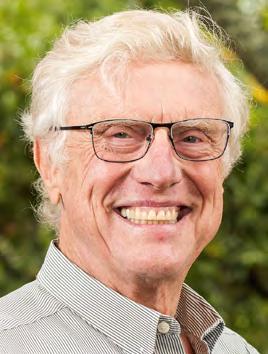
Tore Straume received a BS in Biological Sciences and MS in Radiological Sciences from the University of Washington, and a PhD in Radiation Biophysics from the University of California. He has extensive experience as a radiobiologist, radiation biophysicist, and dosimetrist in space and terrestrial radiation research. His 50+ years career includes positions as Chief Scientist for Life Sciences Division at NASA Ames and Member of the NASA Human Research Program’s Science Management Office. Earlier positions include Research Professor of Radiobiology and Director and Principal Investigator of the Center of Excellence for Biomolecular Technologies at the University of Utah, and senior scientist positions at the Lawrence Livermore National Lab, including Head of Dosimetry and Exposure Assessment, Principal Investigator of Hiroshima Dosimetry (DS02), Principal Investigator of Fluorescence In-Situ Hybridization (FISH) Biodosimetry, and related technology developments. He holds several patents in the technology field, has served on journal editorial boards and radiation protection committees. Since retiring from NASA in 2020, he served as Senior Scientist Affiliate at the Lawrence Berkeley National Lab and Co-Investigator with Andrew Wyrobek on his NASA sponsored Behavior Modeling and Molecular Profiling grants. While at LLNL he also performed pioneering research to identify the plasma membrane as the radiosensitive target for mouse immature oocyte depletion, which provides compelling support for our hypothesis of membrane targets for behavior effects. He authored ~170 publications and he is the lead author on the Straume et al. 2025 paper.
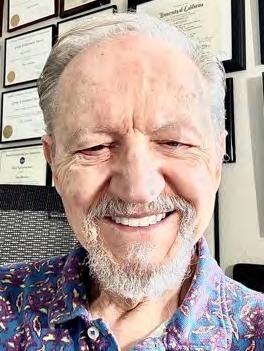
Sea level rise is one of the most threatening consequences of current global warming for the populations living in low lying coastal zones. High-precision satellite altimetry that started with the launch of the Topex/Poseidon mission in 1992, routinely measures sea level change globally and regionally for now more than three decades (e.g., Stammer and Cazenave, 2018). The successive altimetry missions (i.e., Topex/Poseidon, Jason-1, Jason-2, Jason-3, Sentinel-6/ Michael Freilich) have shown that the global mean sea level is not only rising at a mean rate of 3.4 ± 0.3 mm/yr, but is also accelerating in the proportion of ~0.12 ± 0.01 mm/yr every year over the altimetry era (Guerou et al., 2023).
Along the world coastlines, the rate of sea level change results from the combination of the global mean rise, the regional trends due to non-uniform ocean heat content (IPCC, 2019, 2021) and some small-scale coastal processes acting at local scale. Vertical land motions also contribute to relative sea level change at the coast. The small-scale
coastal processes include shelf currents, wind-induced waves, fresh water delivered to the ocean in river estuaries and deltas, as well as changes in temperature and water mass on coastal shelves, and remote effects from natural climate modes (Woodworth et al., 2019, Han et al., 2019). Any change in such coastal processes can affect coastal sea level in the long-term. Characterizing how coastal sea level varies on interannual to multidecadal time scales is a key issue for adaptation purposes.
In the context of the ESA Climate Change Initiative sea level project, a complete reprocessing of high-resolution (20Hz, i.e., 350 m resolution along the satellite tracks) along-track satellite altimetry data from the Jason-1, Jason-2 and Jason-3 missions, covering the period January 2002-June 2021, has been performed during the recent years along the world coastal zones, in order to improve altimetry-based coastal sea level data. For that purpose, The Adaptative Leading Edge Subwaveform (ALES) retracking method developed by Passaro et al. (2014) has been used and some of the geophysical corrections applied to the altimetry data have been improved. The latest validated version of the coastal sea level products (along-track sea level time series and associated trends, from 50 km offshore

◀ Figure 1: Map of the regional sea level trends in the Gulf of Mexico computed with the C3S gridded altimetry product (https://climate. copernicus.eu) over 2002-2021. The position of the 32 coastal virtual stations (version v2.3) are indicated by the numbered circles. Colors within the circles are sea level trends (over 2002-2021) at the virtual stations from this reprocessing. The dotted straight lines are the satellite tracks. The solid black line is the 200m isobath.
to the coast, named version 2.3), provides a total of 1189 virtual coastal altimetry located at less than 8 km from the coast, including 392 virtual stations at less than 3 km from the coast. This data set available from the SEANOE website (https://doi.org/10.17882/74354) is used in this study.
In the present study, we used this dataset (i.e., along-track 20Hz data from 20 km offshore to the coast), to investigate how sea level along the coasts of the Gulf of Mexico has varied over the last two decades, focusing on interannual variability and trends. Where possible, comparisons with tide gauge records are performed. In addition to the alongtrack sea level time series, we also consider a gridded sea level product computed with classical altimetry processing, and use the Copernicus Climate Change Service, Climate Data Store, 2018 (C3S) product with a mesh resolution of 0.25 km (https://cds.climate.copernicus.eu/cdsapp#!/ dataset/satellite-sea-level-global).
Figure 1 shows the location of the 32 virtual stations in the Gulf of Mexico region (circles with numbers). The color in the circles represent the sea level trend at the virtual
stations computed from this reprocessing over the study period (2002-2021). The dotted lines represent the satellite tracks. The oceanic background of Figure1 represents the sea level trend patterns computed over the same time span as for the reprocessed along-track coastal data, using the gridded C3S product. We note from Figure 1 that the sea level trends at the virtual coastal stations are sometimes larger than the trends of the adjacent open ocean (e.g., stations 11, 12, 13), while at other sites, there is good agreement between coastal and offshore trends.
The Gulf of Mexico is a semi enclosed sea with a complex dynamic circulation dominated by the Loop Current. The Loop Current propagates northward through the Yucatan Channel located between the Yucatan Peninsula and Cuba, up to ~26°N in the middle of the Gulf, and outflows southward through the Florida Straits. The Gulf of Mexico is characterized by a present-day mean sea level rise significantly more rapid than the global mean rise. The regional mean rate of rise (Fig.1) amounts to 5 ± 1 mm/yr over the study period, while the global mean rise amounts to 3.8 ± 0.3 mm/yr during the same period. Figure 1 also
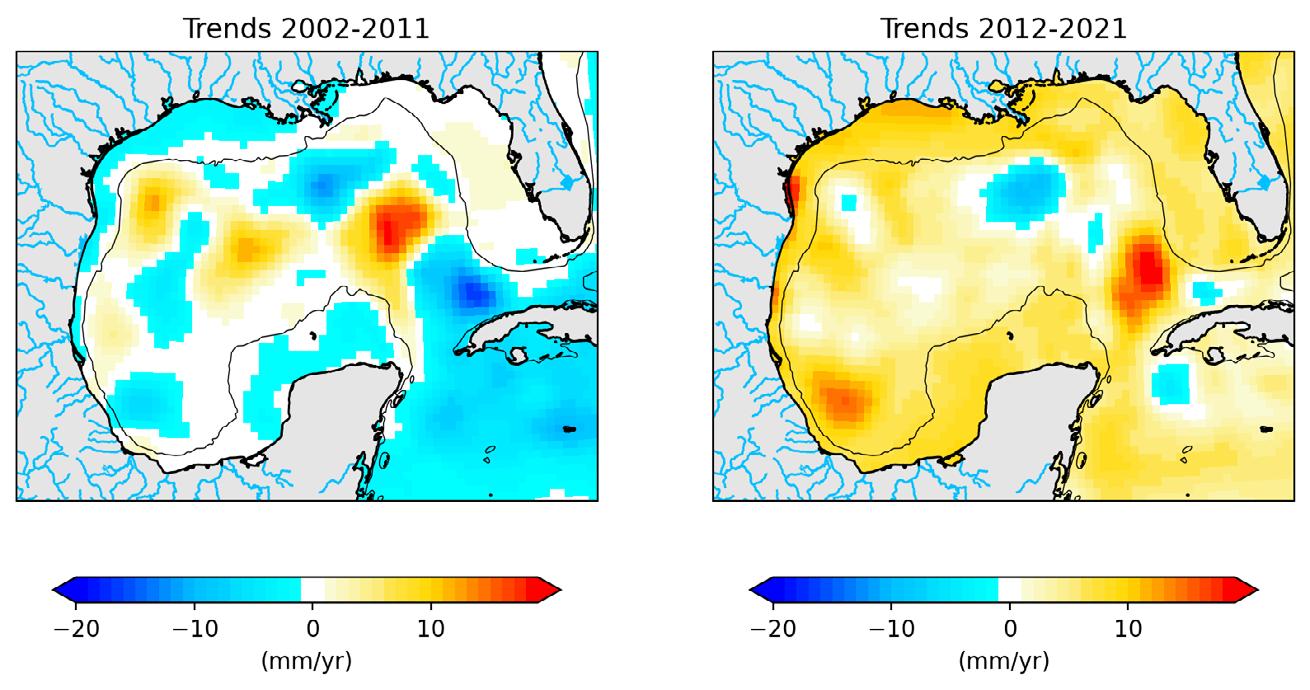
▲ Figure 2: Regional sea level trends over 2002-2011 (a, left), and 2012-2021 (b, right) calculated from the C3S gridded altimetry product (https://climate.copernicus.eu). The solid black line is the 200m isobath.
indicates that over the continental shelf (see the 200m isobath marked by the black solid line), sea level rises faster than in the rest of the Gulf area.
There exists an abundant literature on the ocean dynamics, sea level change, extreme hydro-meteorological events and coastal ecosystem evolution for the Gulf of Mexico. A number of recent publications have focused on the rate of sea level rise along the US Gulf Coast (the northern part of the Gulf of Mexico), often studied in conjunction with sea level along the US eastern coast (e.g., Dangendorf et al., 2023, Yin, 2023).
In the present study, we revisit the accelerated coastal sea level rise in the Gulf of Mexico during the 2010s. Owing to our 32 altimetry-based virtual stations all along the Gulf coasts (see Figure 1 for location), we show that this signal is not limited to the US Gulf coast but impacts also the western and southern coasts of the Gulf. Figure 2a,b compares the regional sea level trends computed over the two successive decades (2002-2011 and 2012-2021) using the gridded C3S altimetry data. During 2002-2011, the mean regional trend amounts 0.12 ± 1 mm/yr while it increases to 5.7 ± 1 mm/yr during 2012-2021 (uncertainties from Prandi et al, 2021).
We have computed the rate of sea level rise at each of the 32 virtual coastal stations. Results shows that the mean rate of change at the 32 coastal sites is close to zero, or even slightly negative during the first decade (but it is likely non-significant considering the associated trend uncertainty), and significantly increases to about 10 mm/yr on average over the second decade These results confirm earlier findings by Dangendorf et al. (2023) and Yin (2023), but also show that the last decade acceleration affects not only the northern part, but also the western and southern coastlines of the Gulf where no long-term tide gauge records were available for previous studies. The results also show that there are some variations in the sea level trend values from one coastal site to another, likely due to small scale coastal processes. A synthesis of these results is shown in Figure 3 that gathers the rates of sea level rise and corresponding uncertainties (90% confidence level) over two periods: (1) June 2002- December 2021 and (2) January 2012-June 2021, at each of the 32 virtual coastal stations. Figure 3 clearly shows significantly different sea level trends between the two periods at almost all virtual stations (except at stations 28 and 29 located at the western coast of Florida), with differences larger than the trend errors.
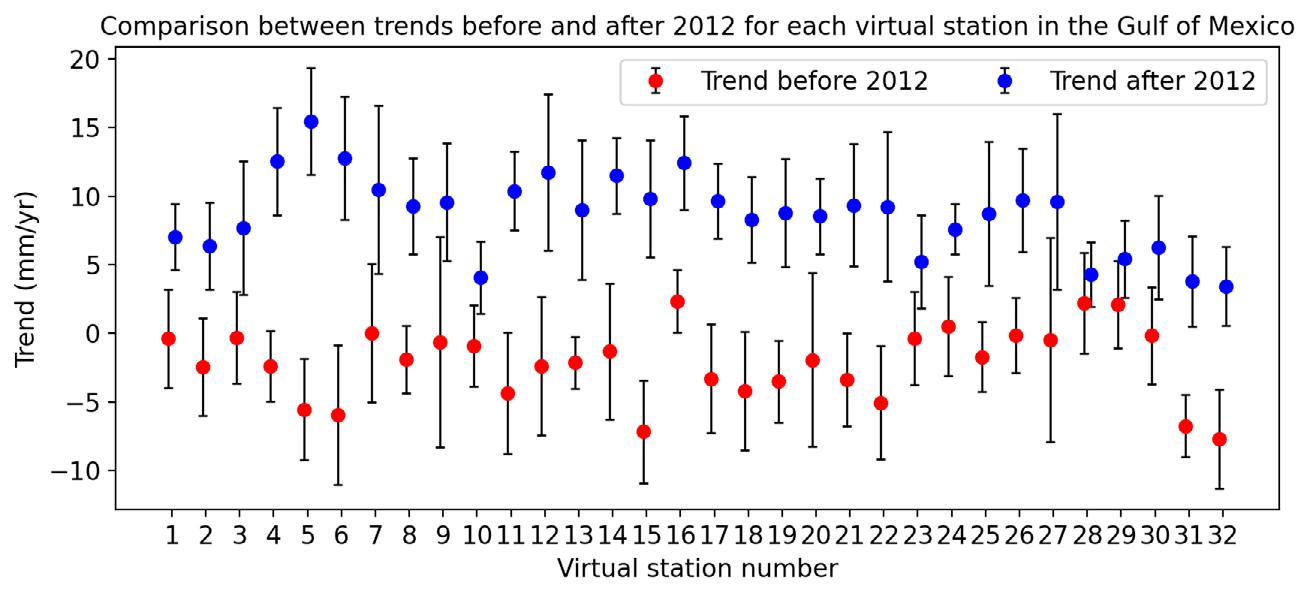
▲ Figure 3: Sea level trends (dots) and corresponding errors (90% confidence level; vertical black bars) in mm/yr computed over June 2002-December 2011 (red dots) and January 2012-June 2021 (blue dots) at the 32 virtual coastal stations (referred by the numbers on the horizontal axis).
The analysis of this altimetry dataset along the coasts of the Gulf of Mexico indicates that over 2002-2021, sea level did not vary linearly. After a first decade of slightly negative trend, a steep increase in the rate of sea level rise is reported, starting around early 2012. While this was previously shown in the literature at the tide gauges of the US Gulf coast, here we observe that this acceleration affects the whole Gulf coastlines. Another result of this study concerns the interannual variability, moderately correlated to ENSO, that propagates almost homogeneously over the shelf area. Comparisons with tide gauge data, available only along the US Gulf coast, allowed us to validate these results, both in terms of trends and interannual variability. But where no long-term tide gauge records are available (e.g., in the southern part of the region), our altimetry-based virtual
• Benveniste, J., Birol, F., Calafat, F., Cazenave, A., Dieng, H., Gouzenes, Y., Legeais, J.F., Léger, F., Niño, F., Passaro, M., Schwatke, C., Shaw, A., 2020. Coastal sea level anomalies and associated trends from Jason satellite altimetry over 2002–2018. Sci Data 7, 357.
• Cazenave, A., Gouzenes, Y., Birol, F., Leger, F., Passaro, M., Calafat, F.M., Shaw, A., Nino, F., Legeais, J.F., Oelsmann, J., Restano, M., Benveniste, J., 2022. Sea level along the world’s coastlines can be measured by a network of virtual altimetry stations. Commun Earth Environ 3, 117.
• Copernicus Climate Change Service, Climate Data Store, 2018. Sea level gridded data from satellite observations for the global ocean from 1993 to present.
• Dangendorf, S., Hendricks, N., Sun, Q., Klinck, J., Ezer, T., Frederikse, T., Calafat, F.M., Wahl, T., Törnqvist, T.E., 2023. Acceleration of U.S. Southeast and Gulf coast sea-level rise amplified by internal climate variability. Nature Communications, 14, 1935.
• Guérou, A., Meyssignac, B., Prandi, P., Ablain, M., Ribes, A., BignaletCazalet, F., 2023. Current observed global mean sea level rise and acceleration estimated from satellite altimetry and the associated measurement uncertainty. Ocean Science 19, 431–451.
• Han, W., Stammer, D., Thompson, P., Ezer, T., Palanisamy, H., Zhang, X., Domingues, C.M., Zhang, L., Yuan, D., 2019. Impacts of Basin-Scale Climate Modes on Coastal Sea Level: a Review. Surv Geophys 40, 1493–1541.
• IPCC, 2019: IPCC Special Report on the Ocean and Cryosphere in a Changing Climate [H.-O. Pörtner, D.C. Roberts, V. MassonDelmotte, P. Zhai, M. Tignor, E. Poloczanska, K. Mintenbeck, A.
coastal stations provide important information about sea level change over the recent decades.
The present study demonstrates the value of careful analysis of near coast altimetry measurements. Where the continental shelf is wide enough, altimeter measurements can be used to explore cross-shelf sea level variability, as well as coastal to open-ocean transition from a process perspective. While the studies by Benveniste et al. (2020) and Cazenave et al. (2022) focused on the production of new altimetry-based coastal sea level time series, the present study, focusing on the Gulf of Mexico region, provides a very first example of the use of such products and highlights the interest of the altimetry-based virtual coastal station concept, that complements the currently limited tide gauge network.
Alegría, M. Nicolai, A. Okem, J. Petzold, B. Rama, N.M. Weyer (eds.)] Cambridge University Press, Cambridge, UK and New York, NY, USA, 755 pp.
• IPCC, 2022: Climate Change 2022: Impacts, Adaptation and Vulnerability. Contribution of Working Group II to the Sixth Assessment Report of the Intergovernmental Panel on Climate Change [H.-O. Pörtner, D.C. Roberts, M. Tignor, E.S. Poloczanska, K. Mintenbeck, A. Alegría, M. Craig, S. Langsdorf, S. Löschke, V. Möller, A. Okem, B. Rama (eds.)] Cambridge University Press. Cambridge University Press, Cambridge, UK and New York, NY, USA, 3056 pp.
• Passaro, M., Cipollini, P., Vignudelli, S., Quartly, G.D., Snaith, H.M., 2014. ALES: A multi-mission adaptive subwaveform retracker for coastal and open ocean altimetry. Remote Sensing of Environment 145, 173–189.
• Prandi, P., Meyssignac, B., Ablain, M., Spada, G., Ribes, A., Benveniste, J., 2021. Local sea level trends, accelerations and uncertainties over 1993–2019. Sci Data 8, 1.
• Stammer D.L., and A. Cazenave, 2018. Satellite altimetry over oceans and land surfaces, 617 pages, CRC Press, Taylor and Francis Group, Boca Raton, New York, London, ISBN: 13: 978-14987-4345-7
• Woodworth, P.L., Melet, A., Marcos, M., Ray, R.D., Wöppelmann, G., Sasaki, Y.N., Cirano, M., Hibbert, A., Huthnance, J.M., Monserrat, S., Merrifield, M.A., 2019. Forcing Factors Affecting Sea Level Changes at the Coast. Surv Geophys 40, 1351–1397.
• Yin, J., 2023. Rapid Decadal Acceleration of Sea Level Rise along the U.S. East and Gulf Coasts during 2010–22 and Its Impact on Hurricane-Induced Storm Surge. Journal of Climate 36, 4511–4529.
This study was conducted in the context of the ESA CCI Coastal Sea Level project, with J.F. Legeais (CLS) as project manager and A. Cazenave (LEGOS) as science leader. The project consists of the development of long term coastal sea level time series based on the reprocessing of coastal altimetry data of the Jason-1, 2, 3 missions over the 2001-present time span. It involves different partners, including LEGOS (France), TUM (Germany), NOC (UK) and CLS (France). The present study dedicated to investigate how much sea level has been rising along the coasts of the Gulf of Mexico since the early 2000s was led by Lancelot Leclercq (LEGOS), in collaboration with other colleagues from LEGOS and CLS. The coastal sea level product is regularly updated by improving the data processing and extending the spatial coverage of the data. The most recent product (July 2025) provides sea level time series since 2001 at more than 1600 virtual coastal stations uniformly located along the world coastlines. It is accessible at the SEANOE website



We are pleased to announce the following recently or soon to be published Special Issues:
• Science and Applied Research with Small Satellites, Vol. 75, Number 9, edited by Loren C. Chang and Margaret Shea
• International Reference Ionosphere - Improved Real-time Ionospheric Predictions with Ground and Space Data, Vol. 75, Number 5, edited by Dieter Bilitza and Yong-Ha Kim
• Information Theory and Machine Learning for Geospace Research, Vol. 74, Number 12, edited by Georgios Balasis and Simon Wing
• Progress in Cosmic Ray Astrophysics, Vol. 74, Number 9, edited by Igor V. Moskalenko and Eun-Suk Seo
• Global Navigation Satellite Systems: Recent Scientific Advances, Vol. 74, Number 6, edited by Elisa Felicitas Arias, Paride Testani
• Recent Advances in Satellite Constellations and Formations, Vol. 73, Number 11, edited by Margaret Ann Shea
The next call for papers is for this special issue of ASR:
• Space Sailing: Concepts, Technology, and Missions: deadline 30 November 2025
The latest news about ASR can be found on this webpage.
My ‘What Caught the Editor’s Eye’ column this issue has really been limited by a period where so much has been happening that I have not found the time to read as much as I would like. Does that sound familiar? However, having been invited to write two book reviews for Space Research Today, I was pleased that in accepting to do this, I was actually obliged to stop, sit down and read. I am glad that I did so, because these books, though very different, were fascinating and well worth a read! — Richard Harrison, General Editor, SRT.
By Lorenzo Iorio, Published March 2025; ISBN-13: 979-8309019823
I wasn’t sure what to expect of this book at first. I did think that it might be something of a novelty that explores some amusing elements of the way scientists use Greek and Latin, but I was to be both surprised and in admiration of Iorio’s work and of its aims. The author points out early on that he is not a professional linguist, being a physicist active in the field of general relativity and gravitation. He points to his motivation for the work being ‘solely (due to) the fact that the vast majority of scientific terms currently in use derive, directly or indirectly, from the aforementioned classical languages to a degree that, perhaps, might surprise the reader’. Indeed, he goes on to stress that by exploring the Greek and Latin influences on how we communicate in our fields, we are exploring something of the historical development of our fields and of the way we communicate today. In effect, it provides a platform for better understanding and clarity. With that in mind, of course, it struck me that I have used Latin and Greek in some senses in every scientific paper I have written, without even thinking about it. After some introductory paragraphs, the book goes on to cover numerous words, dictionary style, in logical sections such as ‘General Terms and Concepts’, ‘Experimental Techniques and Devices’, ‘Mathematics and Geometry’ etc, and it was at that point that I realised that this was so much more than our liberal use of Greek characters for constants and specific parameters, such as lambda for wavelength, pi for the ratio of a circular circumference to the diameter and so on. This was a detailed study of the origins of words that we use, often without thought about where they came from. Clearly, one is tempted to look through for the novelties. I loved the fact that ‘data’ comes from the Latin for ‘given’, as though the numbers we receive from our experiments are a gift. What a nice thought! Similarly, ‘current’
comes from the Latin verb to fly or move quickly; ‘asymptote’ comes from the Latin, borrowed from Greek, for ‘not falling in; not touching’.
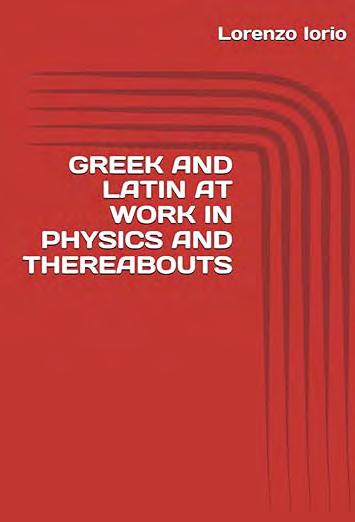
Of course, in most cases it is clear that the root meaning of the Greek or Latin words describe a situation well, and understanding the words can provide an instant understanding of something – e.g. planetary ‘prograde’ motion (from the Latin ‘to come or go forth, march forward’), or ‘atom’ (coming from a Latin/Greek root ‘indivisible’ – though, of course, we know now that the atom is made up of different particles). I found that the dictionary style entries led me to explore basic questions about, for example, what the language really tells us about the difference between a spectrograph and a spectrometer. This book is actually not an amusing list of anecdotes; it is a substantial piece of work. Not exactly bed time reading, but certainly a unique contribution to our field and one that contains a lot of useful information related to how we define things, and how we communicate as scientists. I invite others to find a copy and explore how it relates to your own area of work. It will be an interesting journey.
By Patrizia Caraveo, Published by Springer, 2025;
ISBN 978-3-031-78343-2, ISBN 978-3-031-78344-9 (eBook)
Ecology is not a word many of us often associate with space, but in the spirit of a consideration of preserving ecological balance on our planet, the author is effectively asking what are the boundaries of the environments we wish to protect, with an eye beyond our atmosphere. Of course, the ecology question for the space environment has been looming – growing in our consciousness – with, for example, the increasing discussion about space debris and the mining of extraterrestrial bodies, and clearly this book is timely. The author argues that, like the sea, space can be considered as something for the common good and whilst its use for humanity is undeniably beneficial, it needs to be cared for, protected.
The discussion goes on to focus on Earth and on ecological issues that can be very effectively monitored using space assets, and on the services that satellites provide us. As she puts it, our lives are intimately connected to the services offered by a plethora of satellites orbiting Earth. Indeed, the first half of the book goes on to discuss the development of satellites and, in particular, the rapid increase in numbers of satellites in recent times, especially with the development of commercial activities and cubesats, but she emphasises gaps in the regulation of spacecraft. For example, she talks about the crowding of space in Earth orbit and, in a few paragraphs goes on to say that it is clear that in what she calls circumterrestrial space we do not have uniform regulation; whilst the management of radio frequencies is regulated by a UN body, the occupation of orbits, except for geostationary orbits, is left to national bodies. The 1967 treaty for outer space is mentioned but it is stressed that it is focused on prohibitions of using space for military purposes, claiming sovereignty of the Moon or other bodies etc; it does not prohibit commercial activities and requires the national governments to take responsibility for

control. Whilst there have been additional elements to the treaty, the point the author is making is that there is a clear ‘legislative void’ with 91 nations now involved in space activities.
The section of the book called ‘Explosion of Numbers’ is a fascinating read, putting much into perspective but
also raising more issues that can be a little worrying, such as the dependence on one company or person (SpaceX and Elon Musk being the example used) on a global scale. The expanding commercial endeavours are discussed and the numbers are clearly adding to our crowded space.
The ecological footprints of a spacecraft are discussed. This includes, for example, the impact on the stratosphere and here we find another ‘legal gap’ issue in that whilst the Montreal Protocol set limits on chemicals known to damage the ozone layer, it does not address emissions from rockets or satellites because in 1987 the number of launches was much smaller than today. The numbers are sobering.
About halfway through the book the focus turns to the Moon. The author talks about the lunar renaissance and its diplomatic consequences. After the heady days of the Apollo era, there was a long hiatus in lunar interest, in terms of space missions, but we are well into a new era of interest with orbiters and landers from numerous nations as well as commercial interest. This brings out many questions. There is an interesting discussion on the impact of dealing with the lunar regolith, in future missions and even settlements, for example. Details about the human-generated debris around the Moon, or left or crashed on the lunar surface are given; what do you do with end of life lunar probes and landers? Of course, having covered a range of ecological issues related to the Moon, the
text goes on to discuss Mars in a similar way, and even touching on suggestions by some about terraforming. I found the lunar and Mars discussions to be somewhat disturbing, but much depends on your point of view. Are these heavenly bodies like national parks, to be preserved and protected, or can we - should we - use them for human/commercial benefit? In any case, how do you control or police it?
Planetary defence is covered in the subsequent section of the book, bringing in COSPAR specifically through its active planetary protection activities, and it is good to see a detailed summary of this endeavour in the book.
As you would expect, the book comes to a conclusion with a discussion about sustainable space; what can we do? Can we avoid/manage space debris? Can we set up robust space laws? Indeed, this is underlined by the final section entitled 'Time to Act'.
Incidentally, there is an extremely useful and interesting appendix covering UN space treaties, international agreements and national laws.
Overall, a thorough book, somewhat sobering and certainly a call to get things sorted on the global arena as our space activities continue to expand in terms of launches and numbers of active nations and commercial groups. I would recommend it to everyone in the space business.
Anyone is welcome, indeed encouraged, to submit an article or news item to Space Research Today. As we are the main information bulletin of COSPAR, we are particularly focused on issues and news related to COSPAR business, to space research news and events, including meetings, around the world. In the spirit of a bulletin publication, we aim to be as flexible as possible in the submission procedures. Submission should be made in English, by e-mail to any member of the Editorial Team (see contact details given earlier).
Submissions may be made in (i) e-mail text, with attached image files if required, and (ii) As Word files with embedded images (colour is encouraged). Other formats can be considered; please contact the editorial team with your request. If you are submitting an article, please include ‘about the author’ information, i.e. a paragraph about yourself with an image.
The nominal deadlines are 1 February for the April issue, 1 June for the August issue, and 1 October for the December issue, but material can be submitted at any time.
The editors will always be pleased to receive the following types of inputs or submissions, among others:
RESEARCH HIGHLIGHT articles: These are generally substantial, current review articles that can be expected to be of interest to the general space community, extending from two pages to over five pages, with figures and images (again, colour encouraged). These could be reports on space missions, scientific reports, articles on space strategy or history.
IN BRIEF articles: short research or news announcements up to three pages, with images as appropriate.
COSPAR BUSINESS and COSPAR COMMUNITY: articles related to COSPAR business, reporting on particular activities, meetings or events.
SNAPSHOTS: striking space research related images (e.g. a spacecraft launch, a planetary encounter image, a large solar flare, or a historical image, particularly related to COSPAR) for which we require the image and a single paragraph caption, plus the image credit.
In Memoriam submissions: Articles extending to a few pages, including an image, about a significant figure in the COSPAR community.
LETTERS to the EDITOR: Up to two or three pages on any subject relevant to COSPAR and space research in general. These can cover news, opinions on strategy, or scientific results.
MEETING ANNOUNCEMENTS: meeting reports and book reviews all welcome.
Articles are not refereed, but the decision to publish is the responsibility of the General Editor and his editorial team.
Furthering research, exploration, and the peaceful use of outer space through international cooperation
COSPAR was established by the International Council of Scientific Unions (ICSU), now the International Science Council (ISC), in October 1958 to continue the cooperative programmes of rocket and satellite research successfully undertaken during the International Geophysical Year of 1957-1958. The ICSU resolution creating COSPAR stated that its primary purpose was to "provide the world scientific community with the means whereby it may exploit the possibilities of satellites and space probes of all kinds for scientific purposes, and exchange the resulting data on a cooperative basis".
Accordingly, COSPAR is an interdisciplinary scientific organization concerned with the promotion and progress, on an international scale, of all kinds of scientific research carried out with space vehicles, rockets and balloons. COSPAR’s objectives are carried out by the international community of scientists working through ISC and its adhering National Academies and International Scientific Unions. Operating under the rules of ISC, COSPAR considers all questions solely from the scientific viewpoint and takes no account of political considerations.
COSPAR Members are National Scientific Institutions, as defined by ISC, actively engaged in space research and International Scientific Unions federated in ISC which desire membership. The COSPAR Bureau manages the activities of the Committee on a day-to-day basis for the Council – COSPAR’s principal body – which comprises COSPAR’s President, one official representative of each Member National Scientific Institution and International Scientific Union, the Chairs of COSPAR Scientific Commissions, and the Finance Committee Chair.
COSPAR also recognizes as Associates individual scientists taking part in its activities and, as Associated Supporters, public or private organizations or individuals wishing to support COSPAR’s activities. Current members in this category are Airbus Defence and Space SAS, Center of Applied Space Technology and Microgravity (ZARM), Germany; China Academy of Launch Vehicle Technology (CALT), China; China Academy of Space Technology (CAST), China; Groupement des Industries Françaises Aéronautiques et Spatiales (GIFAS), France; the International Space Science Institute (ISSI), Switzerland; Korea Aerospace Industries, Ltd., S. Korea, L3Harris, USA; United Launch Alliance, USA.
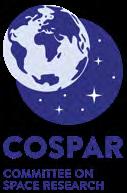
COSPAR also has an Industry Partner programme to encourage strategic engagement with relevant industries who wish to be involved in the activities of COSPAR and support its mission.
The current Industry Partner is Lockheed Martin Corporation , USA.

COSPAR Bureau (2022-2026)
President: P. Ehrenfreund (Netherlands/USA)
Vice Presidents: C. Cesarsky (France), P. Ubertini (Italy)
Other Members: V. Angelopoulos (USA), M. Fujimoto (Japan), M. Grande (UK), P. Rettberg (Germany), I. Stanislawska (Poland), C. Wang (China)
COSPAR Finance Committee (2022-2026)
Chair: I. Cairns (Australia)
Members: C. Mandrini (Argentina), J.-P. St Maurice (Canada)
COSPAR Publications Committee
Chair: P. Ubertini (Italy)
Ex Officio: P. Ehrenfreund (Netherlands/USA), J.-C. Worms (France), R.A. Harrison (UK), T. Hei (USA), M. Shea (USA), P. Willis (France)
Other Members: A. Bazzano (Italy), M. Klimenko (Russia), G. Reitz (Germany), M. Story (USA), P. Visser (Netherlands)
COSPAR Secretariat
Executive Director: J.-C. Worms
Associate Director: A. Janofsky
Administrative Coordinator: L. Fergus Swan
Accountant: A. Stepniak
COSPAR Secretariat, c/o CNES, 2 place Maurice Quentin 75039 Paris Cedex 01, France
E-mail: cospar@cosparhq.cnes.fr
Web: https://cosparhq.world
••• J. Benveniste (France, Chair)
E. Lansard (Singapore)
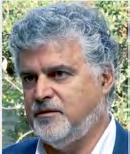
SC A on Space Studies of the Earth's Surface, Meteorology and Climate
••• D. Pallamraju (India, Chair)
P.R. Fagundes (Brazil),
D. Themens (UK),
E. Yigit (USA)
••• H. Yano (Japan; Chair)
B. Foing (Netherlands), R. Lopes (USA)

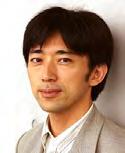
SC B on Space Studies of the Earth-Moon System, Planets, and Small Bodies of the Solar System
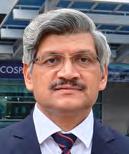
SC C on Space Studies of the Upper Atmospheres of the Earth and Planets, Including Reference Atmospheres
••• I. Papadakis (Greece; Chair)
E. Churasov (Germany), B. Schmieder (France), W. Yu (China)
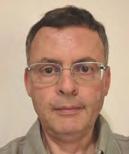
SC E on Research in Astrophysics from Space
••• N. Vilmer (France, Chair)
A. Gil-Swiderska (Poland), J. Zhang (USA)

SC D on Space Plasmas in the Solar System, Including Planetary Magnetospheres
••• T.K. Hei (USA; Chair)
G. Baiocco (Italy), J. Kiss (Germany), P. Rettberg (Germany), Y. Sun (China)
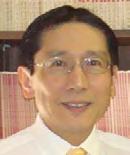
SC F on Life Sciences as Related to Space
••• M. Avila (Germany; Chair)
K. Brinkert (UK),
K. Li (China)
J. Porter (Spain),
A. Romero-Calvo (USA)
SC G on Materials Sciences in Space
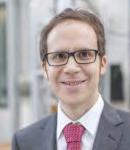
••• M. Rodrigues (France; Chair)
O. Bertolami (Portugal), S. Hermenn (Germany), P. McNamara (ESA/ESTEC)
SC H on Fundamental Physics in Space
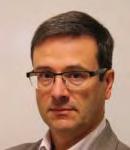
••• J.C. Gabriel (Spain; Chair)
D. Altamirano (UK), J. Benvéniste (ESA), D. Bilitza (USA), M. C. Damas (USA), N. Kumar (India), D. Perrone (Italy), R. Smith (USA), M. Tshisaphungo (S. Africa)
(PCB) Capacity Building
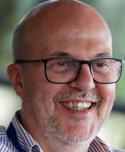
••• D. Baker (USA; Chair)
A. Chandran (USA)

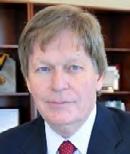
(PCSS) Establishing a Constellation of Small Satellites
••• R. Doran (Portugal; Chair)
S. Benitez Herrera (Spain), G. Rojas (Portugal)

(PE) Education
••• C. Frueh (USA; Chair)
C. Pardini (Italy)
••• M. Snitch (USA; Chair)
TBD
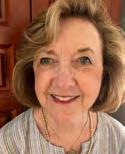
(PECISS) Early Careers and International Space Societies
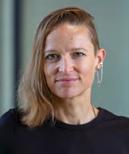
(PEDAS) Potentially Environmentally Detrimental Activities in Space
••• L. Giulicchi (ESA/ESTEC; Chair)
TBD
••• M. Blanc (France; Chair)
B. Foing (Netherlands), C. McKay (USA), F. Westall (France)
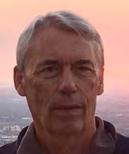
(PEX) Exploration

(PIDEA) Inclusion, Diversity, Equity, and Accessibility Initiative
••• P. Brandt (USA; Chair)
S. Barabash (Sweden), E. Provornikova (USA) (PIR) Interstellar Research
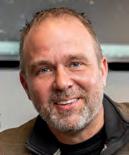
••• Y. Shprits (Germany; Chair)
TBD
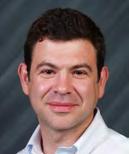
(PMLDS) Machine Learning and Data Science
••• Y. Miyoshi (Japan; Chair)
A. Brunet (France), Y. Shprits (Germany), Y. Zheng (USA)

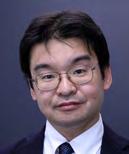
(PRBEM) Radiation Belt Environment Modelling
••• A. Coustenis (France; Chair)
P. Doran (USA), N. Hedman (UNOOSA)
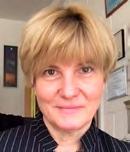
(PPP) Planetary Protection
••• A. Jäggi (Switzerland; Chair)
K. Sosnica, (Poland)
X. Mao (China), F. Topputo (Italy)
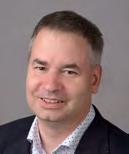
(PSD) Technical Panel on Satellite Dynamics
••• M. Abrahamsson (Sweden; Chair)
V. Dubourg (France), H. Fuke (Japan), E. Udinski (USA)
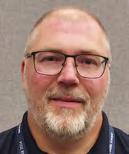
(PSB) Technical Problems Related to Scientific Ballooning
••• E.H. Smith (USA; Chair)
G. Danos (Cyprus)
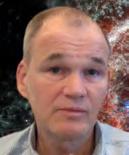
(PoIS) Innovative Solutions
••• M. Bisi (UK; Chair)
J.E.R. Costa (Brazil), S. Gadimova (UNOOSA), N. Gopalswamy (USA), K. Yoon (S. Korea) (PSW) Space Weather

URSI/COSPAR Task Group on the International Reference Ionosphere (IRI)
Chair: Vladimir Truhlik (Czech Rep.), 2022–2026
COSPAR/URSI Task Group on Reference Atmospheres, including ISO WG4 (CIRA)
Chair: Sean Bruinsma (France), 2021–2024
Task Group on Reference Atmospheres of Planets and Satellites (RAPS)
Chair: Hilary Justh (USA), 2021–2024
Task Group on the GEO (TG GEO)
Chair: Suresh Vannan (USA), 2022–2026
Sub-Group on Radiation Belts (PCSS -SGRB)
Chair: Ji Wu (China), 2021–2025
Task Group on Establishing an International Geospace Systems Program (TGIGSP)
Chair: Larry Kepko (USA), 2021–2025
Advisory board: Committee on Industry Relations
Chair: Alison Nordt (Lockheed Martin, USA)
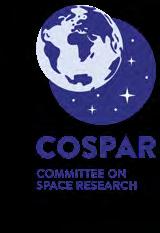
▶ You can find more information by clicking on the Task Groups names.
Space Research Today Editorial Officers
General Editor: R.A. Harrison, Rutherford Appleton Laboratory, Harwell, Oxfordshire OX11 0QX, UK. E-mail: richard.harrison@stfc.ac.uk
Executive Editor: L. Fergus Swan (leigh.fergus@cosparhq.cnes.fr)
Associate Editors: J.-C. Worms (France; cospar@cosparhq.cnes.fr), D. Altamirano (UK; d.altamirano@sotonac.uk), Y. Kasai (Japan; ykasai@nict.go.jp), E.C. Laiakis (USA; ecl28@georgetown.edu), H. Peter (Germany; heike.peter@positim.com)
SPACE RESEARCH TODAY PUBLISHING INFORMATION
Copyright © COSPAR 2025
ISSN: 2647:9933
Page design and layout provided by Illustrator and Graphic Designer: Line
Space Research Today (3 issues per annum) is published by COSPAR and can be freely viewed or downloaded from the COSPAR website https://cosparhq.cnes.fr/. No part of this publication may be reproduced, stored in a retrieval system or transmitted in any form or by any means, electronic, electrostatic, magnetic tape, mechanical, photocopying, recording or otherwise, without permission from the publisher or the copyright holders. COSPAR does not necessarily agree with opinions expressed in articles in Space Research Today